PBE Europe as Axell Wireless 50-0606SERIES UHF Signal Extender User Manual RECEIVER MULTICOUPLER
Axell Wireless UHF Signal Extender RECEIVER MULTICOUPLER
manual

5-Way Channelised UHF Cell Enhancer
Maintenance Handbook
H/book Number:-50-060601HBKM Issue No:-1Date:-04/07/2003 Page:-1 of 54
5 Channel, Channelised Cell Enhancer
Maintenance Handbook
For
AFL Works Order N.:Q108745
Includes AFL product part N’s.: 50-060602 Downlink Amplifier
50-060603 Uplink Amplifier
50-060604 Power Supply
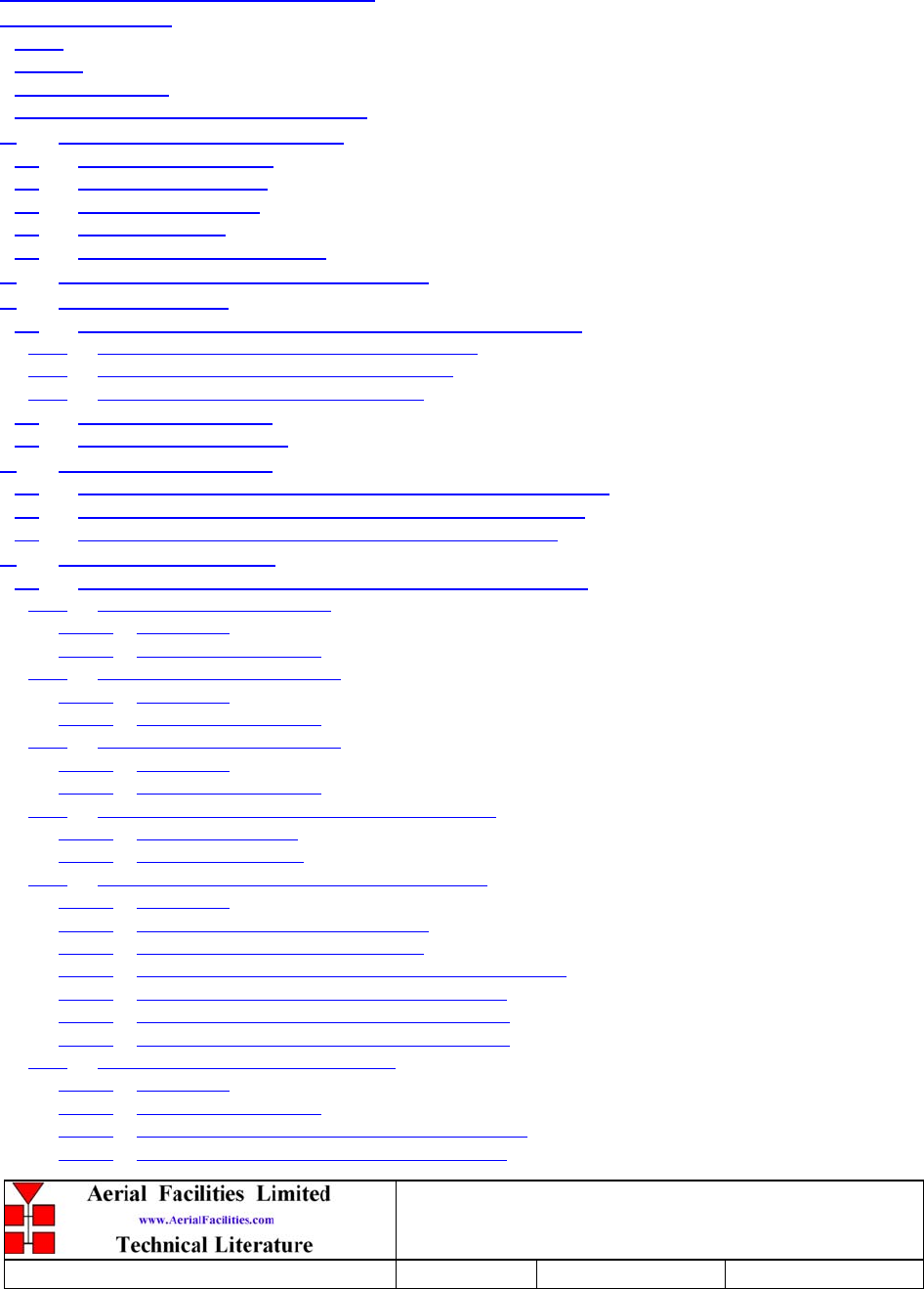
5-Way Channelised UHF Cell Enhancer
Maintenance Handbook
H/book Number:-50-060601HBKM Issue No:-1Date:-04/07/2003 Page:-2 of 54
Table of Contents
AMENDMENT LIST RECORD SHEET ................................................................................................. 4
INTRODUCTION ....................................................................................................................................... 5
Scope...........................................................................................................................................................................5
Purpose.......................................................................................................................................................................5
Glossary of Terms .....................................................................................................................................................6
Key to AFL RF Module Drawing Symbols.............................................................................................................7
1. SAFETY CONSIDERATIONS ....................................................................................................... 8
1.1 Earthing of Equipment................................................................................................................................8
1.2 Electric Shock Hazard .................................................................................................................................8
1.3 RF Radiation Hazard...................................................................................................................................8
1.4 Chemical Hazard..........................................................................................................................................9
1.5 Emergency Contact Numbers .....................................................................................................................9
2. OVERVIEW/SYSTEM DESCRIPTION ..................................................................................... 10
3. SPECIFICATION .......................................................................................................................... 11
3.1 5 Channel Channelised Cell Enhancer 50-060601 Parts Lists ...............................................................11
3.1.1 Downlink Channelised CE 50-060602 Parts List.....................................................................................11
3.1.2 Uplink Channelised CE 50-060603 Parts List .........................................................................................12
3.1.3 Power Supply Shelf 50-060604 Parts List ...............................................................................................13
3.2 Technical Specification ..............................................................................................................................14
3.3 Mechanical Specification ...........................................................................................................................15
4. SYSTEM DRAWINGS .................................................................................................................. 16
4.1 Drg. Nō. 50-060682, Downlink Amplifier Shelf System Diagram..........................................................16
4.2 Drg. Nō. 50-060683, Uplink Amplifier Shelf System Diagram...............................................................17
4.3 Drg. Nō. 50-060684, Power Supply Shelf System Diagram ....................................................................18
5. SUB-UNIT MODULES.................................................................................................................. 19
5.1 Downlink Channelised Cell Enhancer 60-060602 (5U chassis) ..............................................................19
5.1.1 Bandpass Filters (02-010701) ..................................................................................................................19
5.1.1.1 Description.......................................................................................................................................19
5.1.1.2 Technical Specification ....................................................................................................................19
5.1.2 UHF 3dB Splitter (05-002603) ................................................................................................................20
5.1.2.1 Description.......................................................................................................................................20
5.1.2.2 Technical Specification ....................................................................................................................20
5.1.3 3dB UHF Splitter (05-002603) ................................................................................................................21
5.1.3.1 Description.......................................................................................................................................21
5.1.3.2 Technical Specification ....................................................................................................................21
5.1.4 ¼Watt 0- -30dB Switched Attenuator (10-000701).................................................................................21
5.1.4.1 General Application .........................................................................................................................21
5.1.4.2 Switched Attenuators........................................................................................................................21
5.1.5 Low Noise Amplifiers (11-007302 & 11-007402) ..................................................................................22
5.1.5.1 Description.......................................................................................................................................22
5.1.5.2 Technical Specification, (11-007302) ..............................................................................................22
5.1.5.3 Technical Specification (11-007402) ...............................................................................................22
5.1.5.3 Drg. Nō. 11-007302, LNA Assembly With Alarm Relay ..................................................................23
5.1.5.4 Drg. Nō. 11-007370, LNA RF Circuit Diagram...............................................................................24
5.1.5.5 Drg. Nō. 11-007371, LNA DC Wiring Diagram ..............................................................................25
5.1.5.6 Drg. Nō. 11-003971, LNA DC Circuit Diagram..............................................................................26
5.1.6 10Watt Power Amplifier (12-001901) .....................................................................................................27
5.1.6.1 Description.......................................................................................................................................27
5.1.6.2 Technical Specification ....................................................................................................................27
5.1.6.3 Drg. Nō. 12-001901, 10W PA PCB Sub-Assembly ..........................................................................28
5.1.6.4 Drg. Nō. 12-001970, 10W PA Circuit Diagram ..............................................................................29
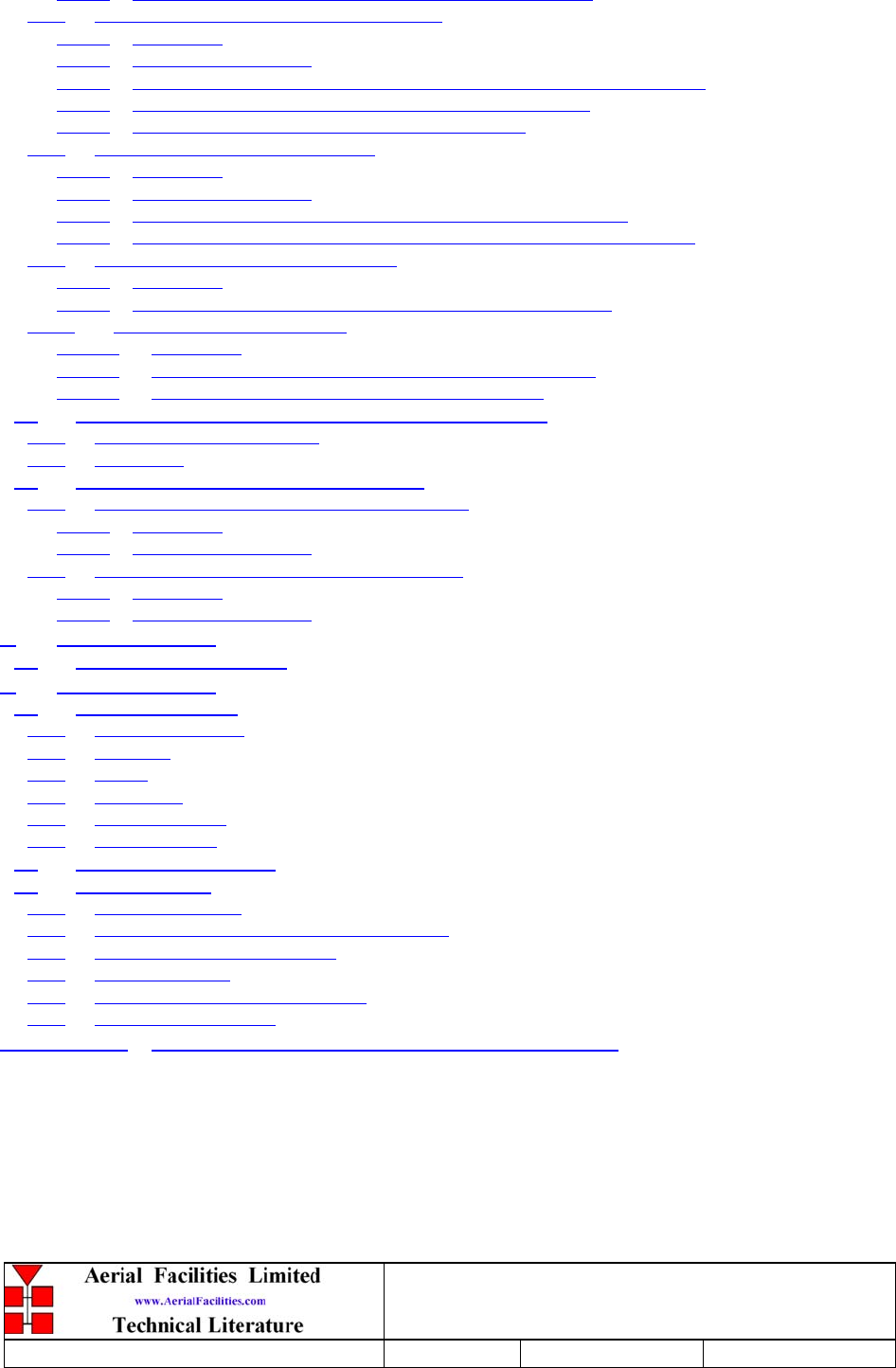
5-Way Channelised UHF Cell Enhancer
Maintenance Handbook
H/book Number:-50-060601HBKM Issue No:-1Date:-04/07/2003 Page:-3 of 54
5.1.6.5 Drg. Nō. 80-008450, PA to Alarm Board DC Wiring Details .........................................................30
5.1.7 3 Stage Amplifier Alarm Boards (12-002201).........................................................................................31
5.1.7.1 Description.......................................................................................................................................31
5.1.7.2 Technical Specification ....................................................................................................................32
5.1.7.3 Drg. Nō. 12-002201, 3 Stage Alarm Board Assembly Drawing & Parts List..................................33
5.1.7.4 Drg. Nō. 12-002270, 3 Stage Alarm Board Circuit Diagram..........................................................34
5.1.7.5 Generic Rack Shelf Enclosure Alarm Wiring Sketch .......................................................................35
5.1.8 Dual DC/DC Converter (13-001803).......................................................................................................37
5.1.8.1 Description.......................................................................................................................................37
5.1.8.2 Technical Specification ....................................................................................................................37
5.1.8.3 Drg. Nō. 13-001803, Dual DC/DC Converter Assembly Drawing..................................................38
5.1.8.4 Drg. Nō. 13-001872, Dual DC/DC Converter Circuit Diagram (12V/12V)....................................39
5.1.9 Channel Selective Module (17-003012) ..................................................................................................40
5.1.9.1 Description.......................................................................................................................................40
5.1.9.2 Drg. Nō. 17-003080, Generic Channel Module Block Diagram .....................................................41
5.1.10 24V Relay Board (20-001602).............................................................................................................42
5.1.10.1 Description ...................................................................................................................................42
5.1.10.2 Drg. Nō. 20-001602, 24V Relay Board Assembly Drawing.........................................................43
5.1.10.3 Drg. Nō. 20-001671, Relay Board Circuit Diagram....................................................................44
5.2 Uplink Channelised Cell Enhancer 50-060603 (5U chassis)...................................................................45
5.2.1 DC Tap Module (21-001701)...................................................................................................................45
5.7.1 Description ...............................................................................................................................................45
5.3 Power Supply Shelf 50-060604 (4U chassis).............................................................................................46
5.3.1 24V 410W Flat-Pack Power Supply (96-300054) ...................................................................................46
5.3.1.1 Description.......................................................................................................................................46
5.3.1.2 Technical Specification ....................................................................................................................46
5.3.2 48V/8A DC Power Supply Module (96-300056) ....................................................................................47
5.3.2.1 Description.......................................................................................................................................47
5.3.2.2 Technical Specification ....................................................................................................................47
6. INSTALLATION............................................................................................................................ 48
6.1 Initial Installation Record .........................................................................................................................48
7. MAINTENANCE............................................................................................................................ 49
7.1 General Procedures....................................................................................................................................49
7.1.1 Basic Fault Finding ..................................................................................................................................49
7.1.2 Downlink..................................................................................................................................................50
7.1.3 Uplink.......................................................................................................................................................50
7.1.4 Fault repair ...............................................................................................................................................50
7.1.5 Checking service ......................................................................................................................................51
7.1.6 Service Support ........................................................................................................................................51
7.2 Tools & Test Equipment............................................................................................................................51
7.3 Care of Modules .........................................................................................................................................52
7.3.1 General Comments...................................................................................................................................52
7.3.2 Module Removal (LNA’s, general procedure): .......................................................................................52
7.3.3 Module Replacement (general): ...............................................................................................................52
7.3.4 Power Amplifiers .....................................................................................................................................52
7.3.5 Low Power Amplifier Replacement.........................................................................................................53
7.3.6 Module Transportation:............................................................................................................................53
APPENDIX A INITIAL EQUIPMENT SET-UP CALCULATIONS............................................... 54
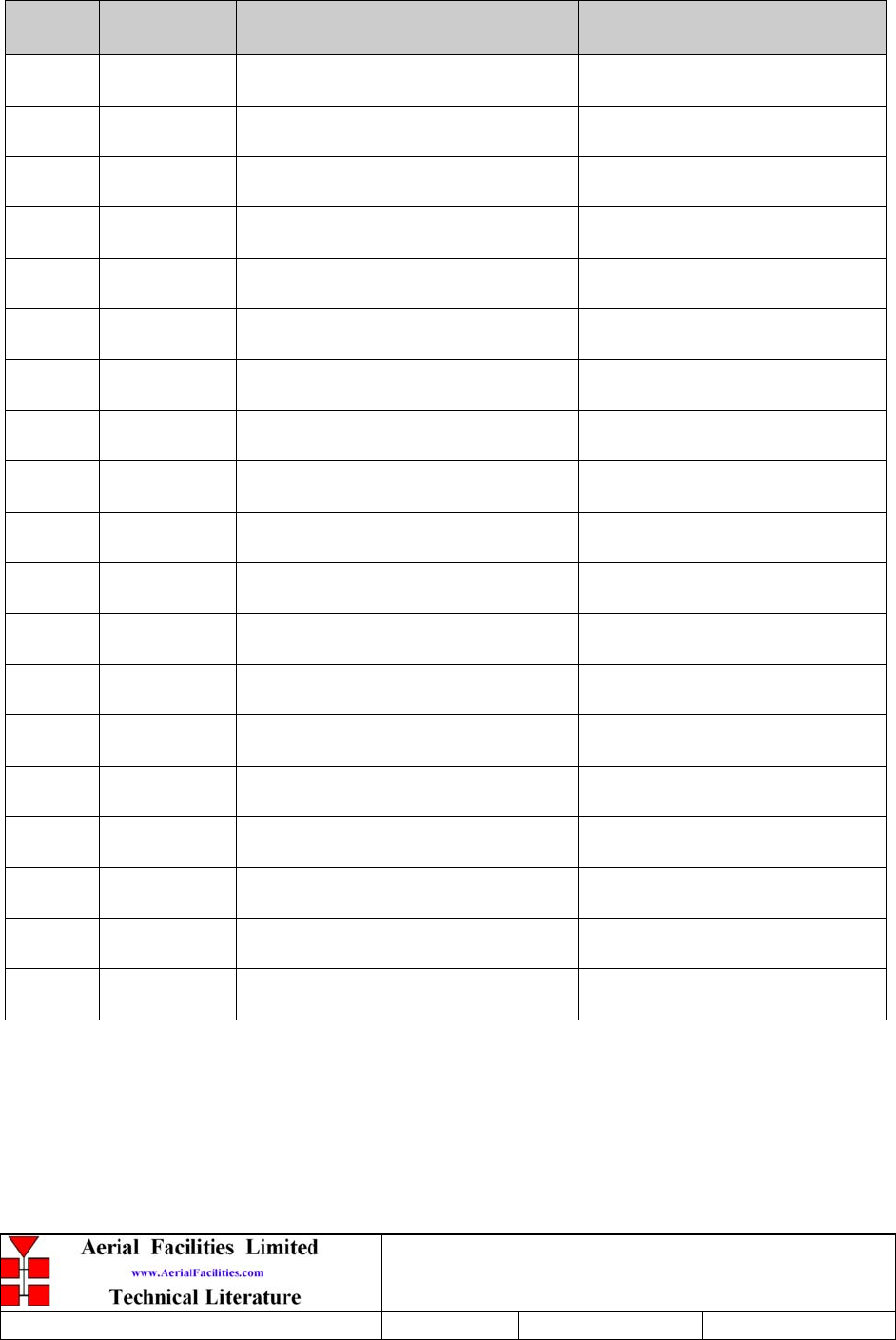
5-Way Channelised UHF Cell Enhancer
Maintenance Handbook
H/book Number:-50-060601HBKM Issue No:-1Date:-04/07/2003 Page:-4 of 54
AMENDMENT LIST RECORD SHEET
Issue
Nō.
Date Incorporated
by
Page No.’s
Amended
Reason for new issue
1 09/07/2003 CMH 1st Issue
Document Ref:-50-060601HBKM
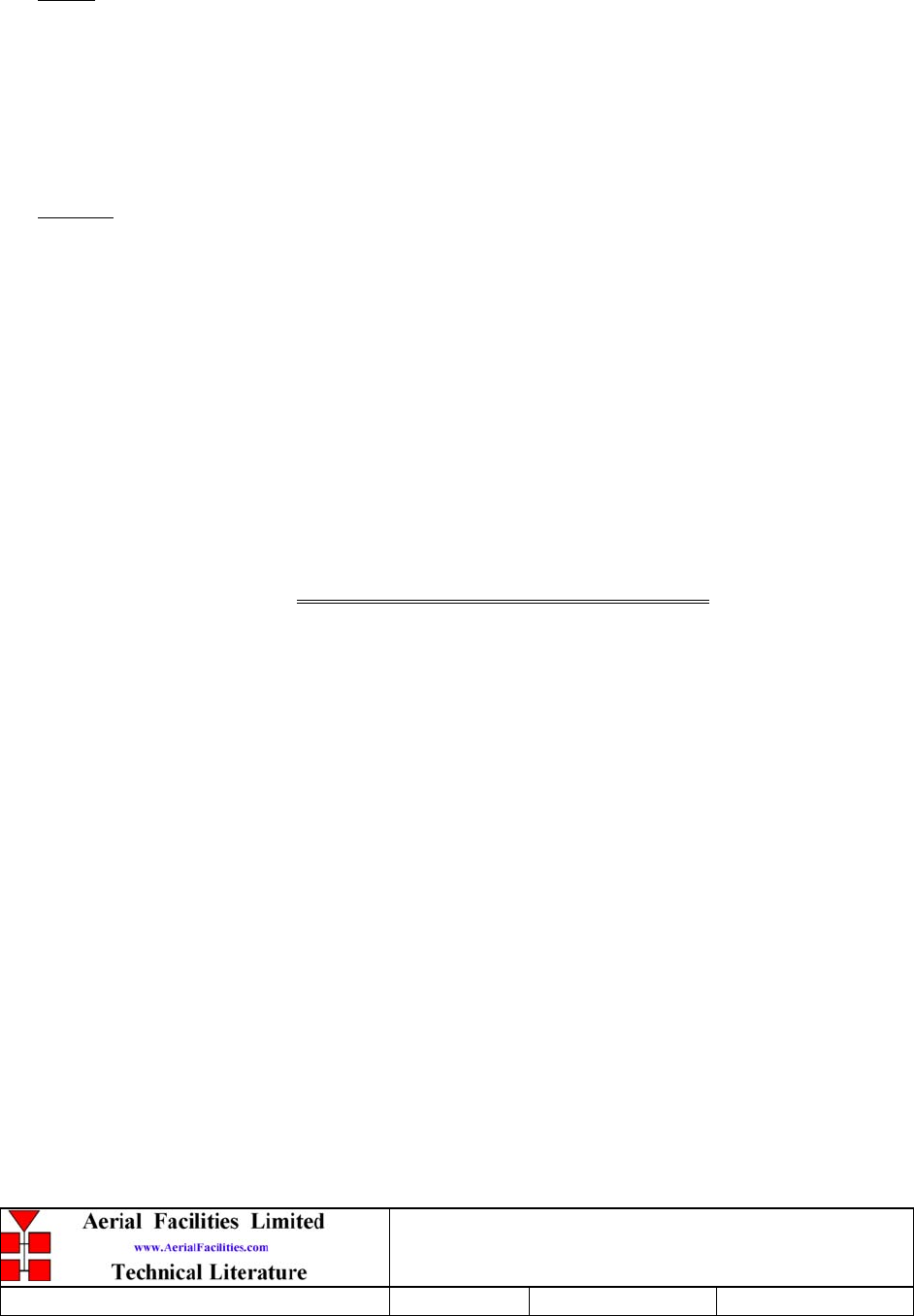
5-Way Channelised UHF Cell Enhancer
Maintenance Handbook
H/book Number:-50-060601HBKM Issue No:-1Date:-04/07/2003 Page:-5 of 54
INTRODUCTION
Scope
This handbook is for use solely with the equipment identified by the AFL Part Number
shown on the front cover. It is not to be used with any other equipment unless specifically
authorised by Aerial Facilities Limited. This is a controlled release document and, as such,
becomes a part of Aerial Facilities’ Total Quality Management System. Alterations and
modification may therefore only be performed by Aerial Facilities Ltd.
Purpose
The purpose of this handbook is to provide the user/maintainer with sufficient information
to service and repair the equipment to the level agreed. Maintenance and adjustments to any
deeper level must be performed by AFL, normally at the company’s repair facility in
Chesham, England.
This handbook has been prepared in accordance with BS 4884, and AFL’s Quality
procedures, which maintain the company’s registration to ISO 9001: 1994 and to the
R&TTE Directive of the European Parliament. Copies of the relevant certificates and the
company Quality Manual can be supplied on application to the Quality Manager.
This document fulfils the relevant requirements of Article 6 of the R&TTE Directive.
Limitation of Information Notice
This manual is written for the use of technically competent operators/service persons. No
liability is accepted by AFL for use or misuse of this manual, the information contained
therein, or the consequences of any actions resulting from the use of the said information,
including, but not limited to, descriptive, procedural, typographical, arithmetical, or listing
errors.
Furthermore, AFL does not warrant the absolute accuracy of the information contained
within this manual, or it’s completeness, fitness for purpose, or scope.
AFL has a policy of continuous product development and enhancement, and as such,
reserves the right to amend, alter, update and generally change the contents, appearance and
pertinence of this document without notice.
All AFL products carry a twelve month warranty from date of shipment. The warranty is
expressly on a return to base repair or exchange basis and the warranty cover does not
extend to on-site repair or complete unit exchange.
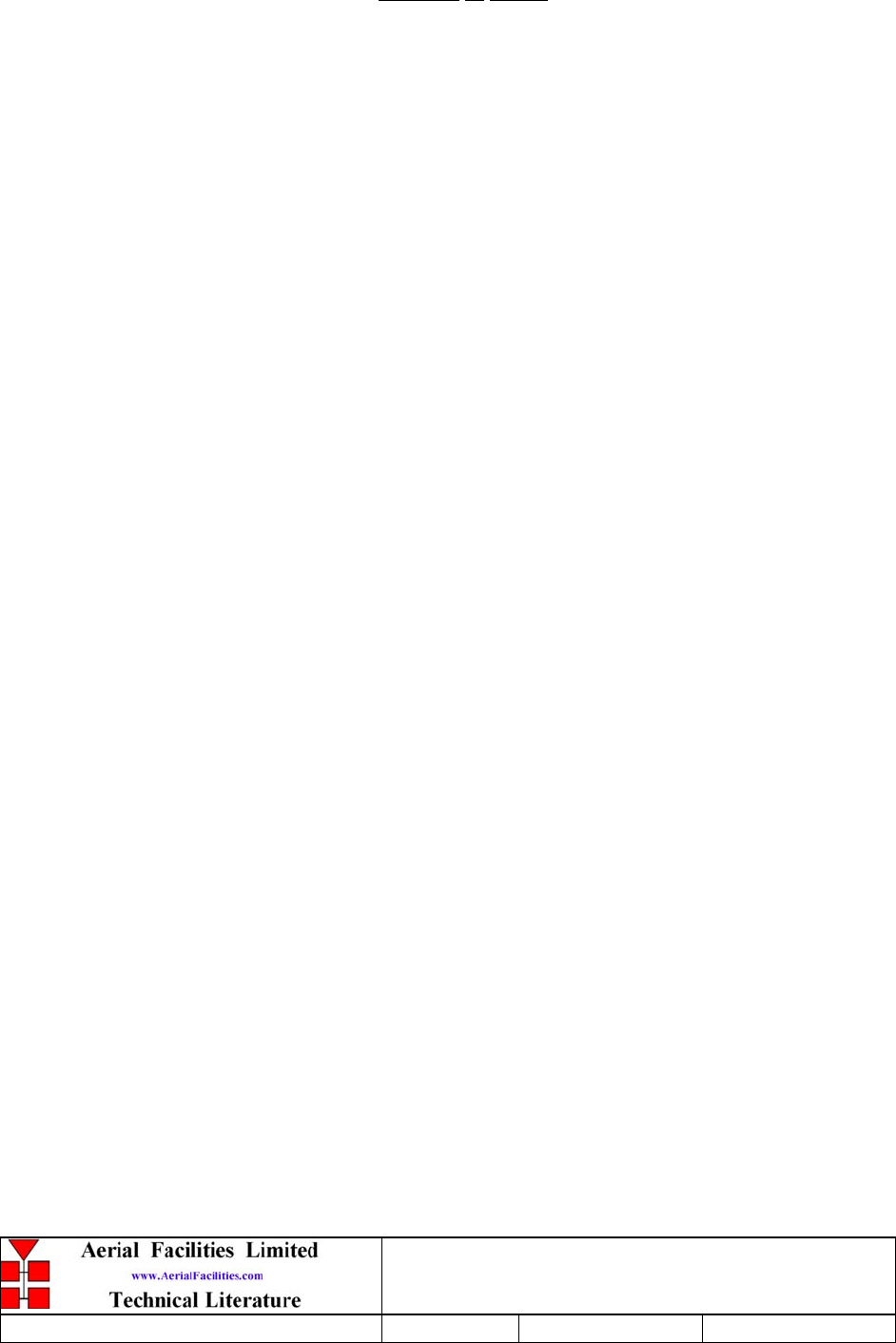
5-Way Channelised UHF Cell Enhancer
Maintenance Handbook
H/book Number:-50-060601HBKM Issue No:-1Date:-04/07/2003 Page:-6 of 54
Glossary of Terms
Repeater or
Cell Enhancer A Radio Frequency (RF) amplifier which can simultaneously
amplify and re-broadcast Mobile Station (MS) and Base
Transceiver Station (BTS) signals.
Band Selective Repeater A Cell Enhancer designed for operation on a range of channels
within a specified frequency band.
Channel Selective
Repeater A Cell Enhancer, designed for operation on specified channel(s)
within a specified frequency band. Channel frequencies may be
factory set, remotely set by computer, or on-site programmable.
BTS Base Transceiver Station
C/NR Carrier-to-Noise Ratio
Downlink (D.L.) RF signals transmitted from the BTS and to the MS
Uplink (U.L.) RF signals transmitted from the MS to the BTS
EMC Electromagnetic Compatibility
GND Ground
DC Direct Current
AC Alternating Current
ID Identification Number
OIP3 Output Third Order Intercept Point = RFout +(C/I)/2
LED Light Emitting Diode
M.S. Mobile Station
N/A Not Applicable
N/C No Connection
NF Noise Figure
RF Radio Frequency
Rx Receiver
Tx Transmitter
S/N Serial Number
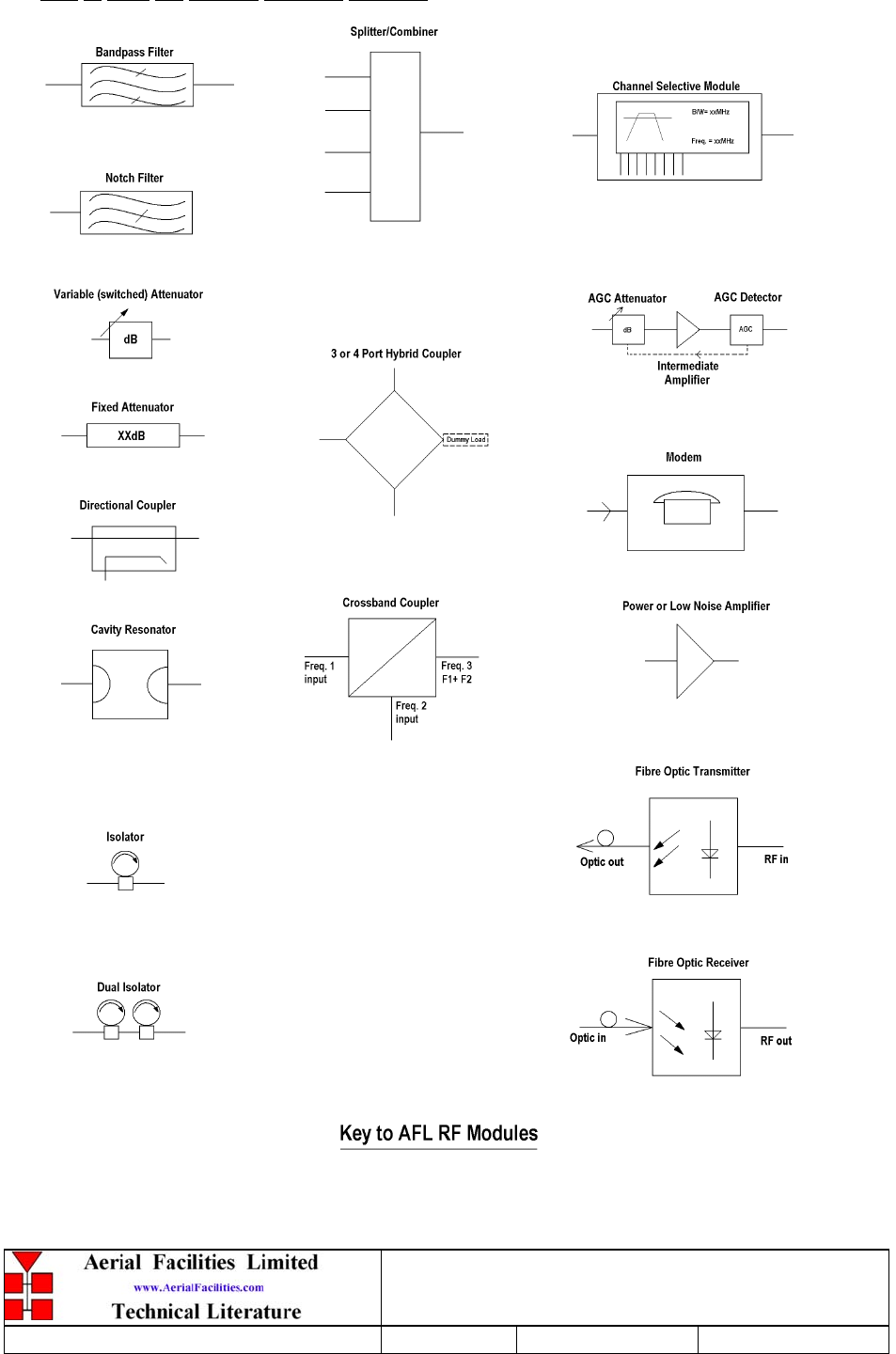
5-Way Channelised UHF Cell Enhancer
Maintenance Handbook
H/book Number:-50-060601HBKM Issue No:-1Date:-04/07/2003 Page:-7 of 54
Key to AFL RF Module Drawing Symbols
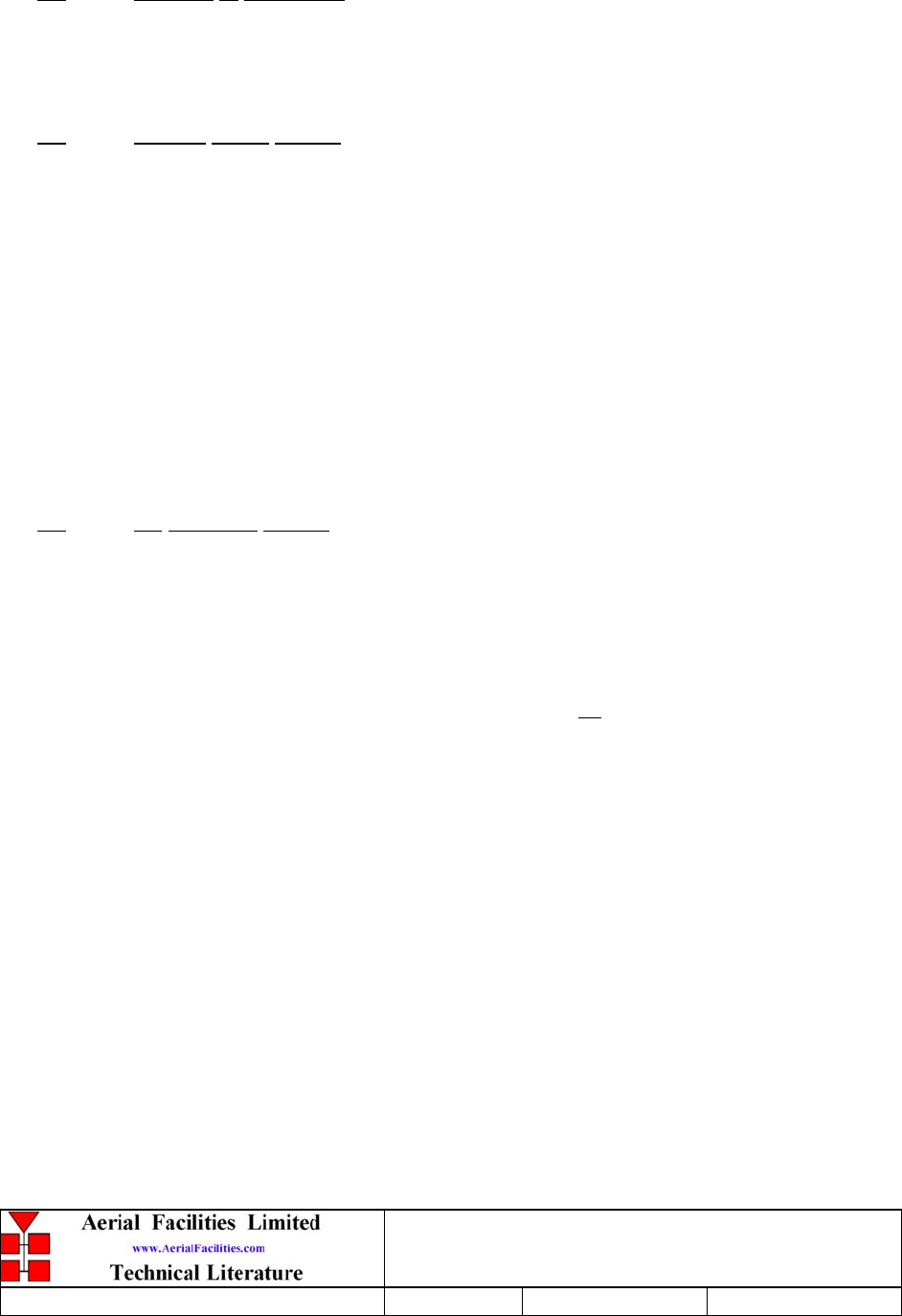
5-Way Channelised UHF Cell Enhancer
Maintenance Handbook
H/book Number:-50-060601HBKM Issue No:-1Date:-04/07/2003 Page:-8 of 54
1. SAFETY CONSIDERATIONS
1.1 Earthing of Equipment
Cell Enhancers supplied from the mains must be connected to grounded outlets and earthed in
conformity with appropriate local, national and international electricity supply and safety
regulations.
1.2 Electric Shock Hazard
Electrical shocks due to faulty mains driven power supplies.
Whilst ever potentially present in any electrical equipment, such a condition would be
minimised by quality installation practice and thorough testing at:
a) Original assembly.
b) Commissioning.
c) Regular intervals, thereafter.
All test equipment to be in good working order prior to its use. High current power supplies
can be dangerous because of the possibility of substantial arcing. Always switch off during
disconnection and reconnection.
1.3 RF Radiation Hazard
RF radiation, (especially at UHF frequencies) arising from transmitter outputs connected to
AFL’s equipment, must be considered a safety hazard.
This condition might only occur in the event of cable disconnection, or because a ‘spare’
output has been left unterminated. Either of these conditions would impair the system’s
efficiency. No investigation should be carried out until all RF power sources have been
removed. This would always be a wise precaution, despite the severe mismatch between the
impedance of an N type connector at 50, and that of free space at 377, which would
severely mitigate against the efficient radiation of RF power. Radio frequency burns could
also be a hazard, if any RF power carrying components were to be carelessly touched!
Antenna positions should be chosen to comply with requirements (both local & statutory)
regarding exposure of personnel to RF radiation. When connected to an antenna, the unit is
capable of producing RF field strengths, which may exceed guideline safe values especially if
used with antennas having appreciable gain. In this regard the use of directional antennas
with backscreens and a strict site rule that personnel must remain behind the screen while the
RF power is on, is strongly recommended.
Where the equipment is used near power lines, or in association with temporary masts not
having lightning protection, the use of a safety earth connected to the case-earthing bolt is
strongly advised.
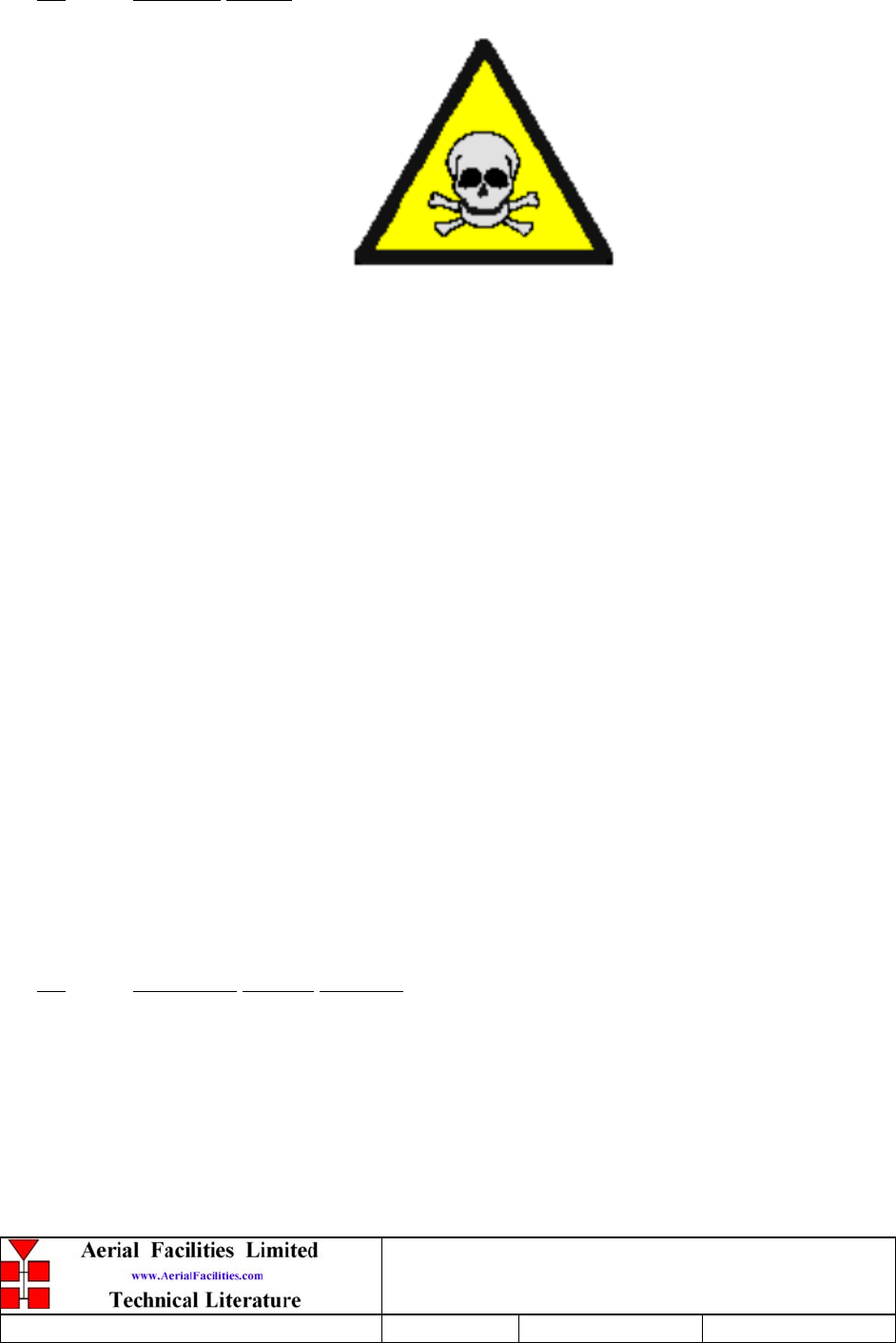
5-Way Channelised UHF Cell Enhancer
Maintenance Handbook
H/book Number:-50-060601HBKM Issue No:-1Date:-04/07/2003 Page:-9 of 54
1.4 Chemical Hazard
Beryllium Oxide, also known as Beryllium Monoxide, or Thermalox™, is sometimes used
in devices within equipment produced by Aerial Facilities Ltd. Beryllium oxide dust can be
toxic if inhaled, leading to chronic respiratory problems. It is harmless if ingested or by
contact.
Products that contain beryllium are load terminations (dummy loads) and some power
amplifiers. These products can be identified by a yellow and black “skull and crossbones”
danger symbol (shown above). They are marked as hazardous in line with international
regulations, but pose no threat under normal circumstances. Only if a component containing
beryllium oxide has suffered catastrophic failure, or exploded, will there be any danger of the
formation of dust. Any dust that has been created will be contained within the equipment
module as long as the module remains sealed. For this reason, any module carrying the
yellow and black danger sign should not be opened. If the equipment is suspected of failure,
or is at the end of its life-cycle, it must be returned to Aerial Facilities Ltd for disposal.
To return such equipment, please contact the Quality Department, who will give you a
Returned Materials Authorisation (RMA) number. Please quote this number on the packing
documents, and on all correspondence relating to the shipment.
PolyTetraFluoroEthylene, (P.T.F.E.) and P.T.F.E. Composite Materials
Many modules/components in AFL equipment contain P.T.F.E. as part of the RF insulation
barrier.
This material should never be heated to the point where smoke or fumes are evolved. Any
person feeling drowsy after coming into contact with P.T.F.E. especially dust or fumes
should seek medical attention.
1.5 Emergency Contact Numbers
The AFL Quality Department can be contacted on:
Telephone +44 (0)1494 777000
Fax +44 (0)1494 777002
e-mail qa@aerial.co.uk

5-Way Channelised UHF Cell Enhancer
Maintenance Handbook
H/book Number:-50-060601HBKM Issue No:-1Date:-04/07/2003 Page:-10 of 54
2. OVERVIEW/SYSTEM DESCRIPTION
The AFL Channel Selective Cell Enhancer is a 2-way on-band repeater. Various models are
available to cover frequency bands from 50MHz to 3000MHz. Its main sphere of
applications is in urban areas where the topology is such that shadows occur in the
propagation pattern (for example within large buildings, conference centres and tunnels,
etc.,)
The Channel Selective Cell Enhancer is a 2-port device for direct connection to two
antennas, usually a highly directional Yagi or similar aligned towards the base (donor) site
and an omni-directional antenna to cover the mobiles. The frequency bands that are passed
by the Cell Enhancer are set as per the specific customer requirements.
AFL manufacture a wide range of Cell Enhancers, configured for each customer's specific
requirements. Two basic physical variants are available, a rack mounted version to fit in a
standard 19" rack and an environmentally sealed wall mounted version which requires no
further enclosure.
The rack-mounted version is usually supplied in 3 units, a power supply unit and 2 RF units
(one containing each path). Each shelf/tray unit containing active modules has a ‘D.C. on’
indicator on the front panel and the PSU also has an ‘A.C. on’ indicator.
The wall-mounted version is supplied in a single environmentally-protected case. Handles
are provided for carrying the unit and the door is fitted with locks. A supply isolator switch
is fitted inside the unit and there are ‘.DC. on’ and ‘Alarm on’ indicators on the outside of
the door.
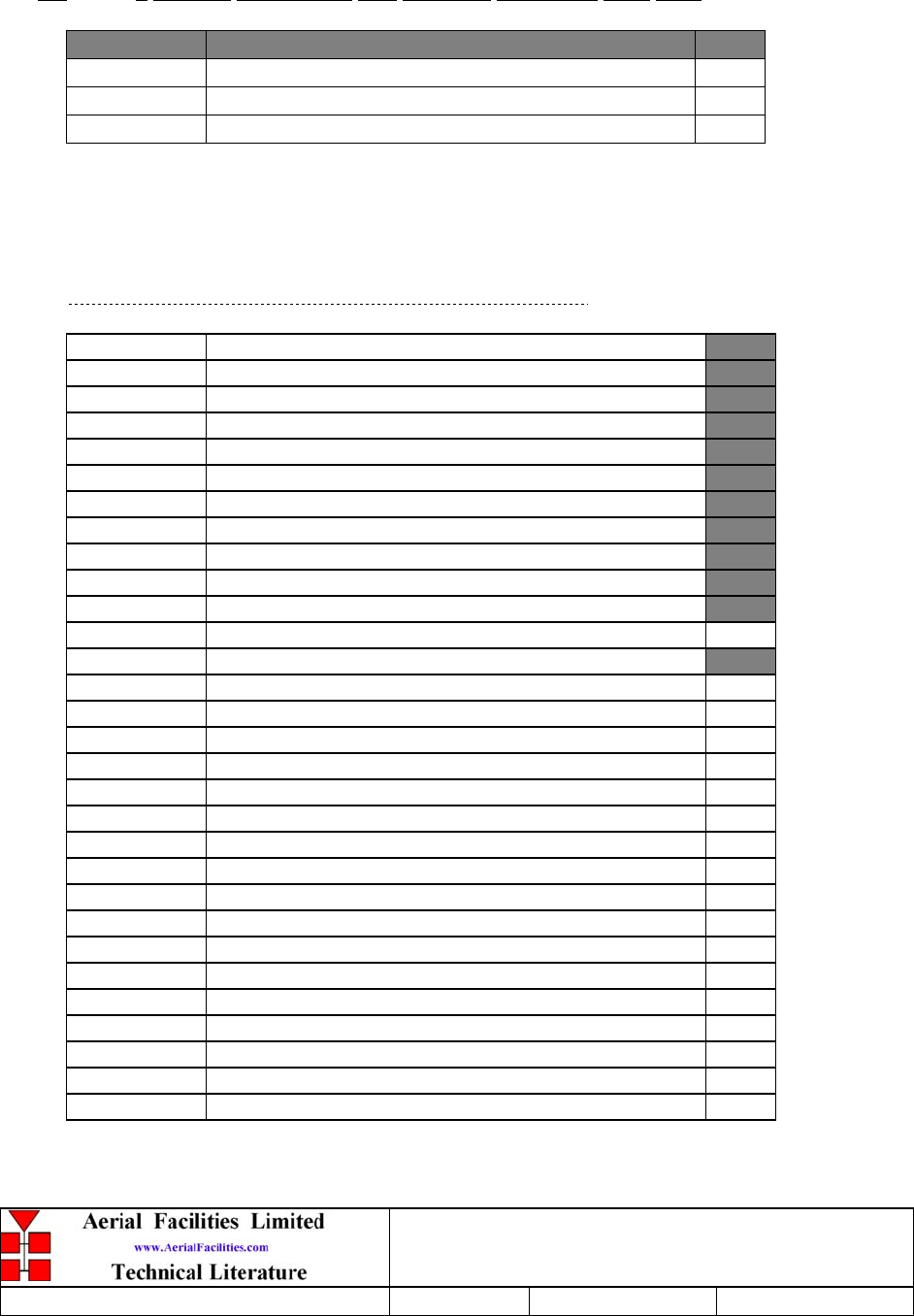
5-Way Channelised UHF Cell Enhancer
Maintenance Handbook
H/book Number:-50-060601HBKM Issue No:-1Date:-04/07/2003 Page:-11 of 54
3. SPECIFICATION
3.1 5 Channel Channelised Cell Enhancer 50-060601 Parts Lists
AFL Part N.Description Qty.
50-060602 D/L CCE 80dB 10W Q108330 1
50-060603 U/L CCE 80dB 10W Q108330 1
50-060604 PSU Q108330 1
Modules described in the text are shown as highlighted in the parts list in the quantity
column. All fuses used in this equipment must be replaced with identical types as
proscribed in the description column of the particular unit’s parts list.
3.1.1 Downlink Channelised CE 50-060602 Parts List
02-010701 5P 380MHz(V.B/W)X CPLING SMA POSTS 2
05-002603 UHF 3dB SPLITTER SMA 2
05-003803 3 WAY SPLITTER, UHF, ZINGER 4
10-000701 1/4W0-30dB SWITCHED ATTENUATOR 1
11-007302 LNA. 380-500MHz 20dB (C/W RELAY) GA 2
11-007402 LNA. 380-500MHz 30dB (C/W RELAY) GA 1
12-001901 PWR AMP.450MHz 20W GEN.ASSY 1
12-002201 3 STAGE AMPLIFIER ALARM BOARD 2
12-002220 3 STAGE ALARM PCB COVER 2
13-001803 DUAL DC/DC CONVERTER 24V-12V 1A 1
17-003012 CHAN MOD 450MHz, 15kHz (8p) BW 5
19-000826 2U,3U,4U 19" UNIT 400 DEEP LID 1
20-001602 24V RELAY BOARD 1
80-024420 5U CHASSIS FRONT PANEL 1
80-024421 5U CHASSIS 400mm DEEP 1
80-043320 HEATSINK 1
91-020004 N JACK PANEL UT-141 3
91-500001 POWER PLG 3 PIN PNL.MOUNT NC-X 1
91-510003 3 PIN R.ANGLE FREE SOC.NC-X. 1
91-600001 'D'TYPE 9 WAY PLUG S/B TERM 1
91-620001 'D' 25 WAY SOCKET S/B TERM 2
91-620006 'D' 25 WAY CONNECTOR SHELL 2
91-700017 ICD 15 WAY 0.1' CONNECTOR 4
92-340001 M3 x 8mm 'D'CONNECTOR SCREW LOCK 0
96-110001 FUSE HOLDER 20 x 5mm6.3A 1
96-110013 T 3.15 A ANTI SURGE FUSE 20mm 1
96-500005 DC INPUT FILTERS 1
96-600002 INSULATING BOOT SMALL 1
96-600003 INSULATING BOOT D.C. 1
97-400006 5U HANDLE [ALLOY] 2
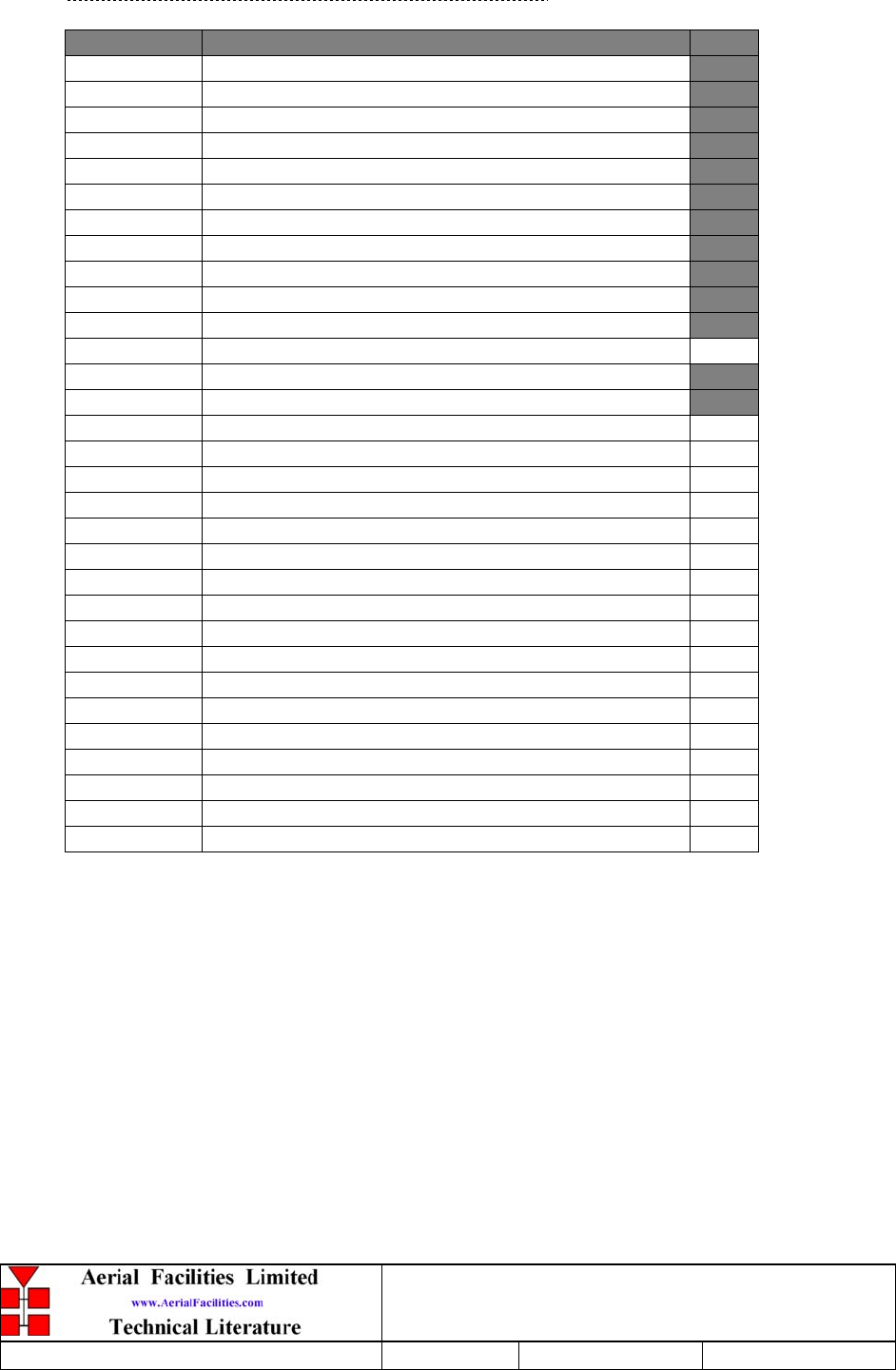
5-Way Channelised UHF Cell Enhancer
Maintenance Handbook
H/book Number:-50-060601HBKM Issue No:-1Date:-04/07/2003 Page:-12 of 54
3.1.2 Uplink Channelised CE 50-060603 Parts List
AFL Part N.Description Qty.
02-010701 5P 380MHz(V.B/W)X CPLING SMA POSTS 2
05-002603 UHF 3dB SPLITTER SMA 2
05-003803 3 WAY SPLITTER, UHF, ZINGER 4
10-000701 1/4W0-30dB SWITCHED ATTENUATOR 1
11-007302 LNA. 380-500MHz 20dB (C/W RELAY) GA 2
11-007402 LNA. 380-500MHz 30dB (C/W RELAY) GA 1
12-001901 PWR AMP.450MHz 20W GEN.ASSY 1
12-002201 3 STAGE AMPLIFIER ALARM BOARD 2
12-002220 3 STAGE ALARM PCB COVER 2
13-001803 DUAL DC/DC CONVERTER 24V-12V 1A 1
17-003012 CHAN MOD 450MHz, 15kHz (8p) BW 5
19-000826 2U,3U,4U 19" UNIT 400 DEEP LID 1
20-001602 24V RELAY BOARD 1
21-001701 DC TAP PT FREEPORT 1
80-024420 5U CHASSIS FRONT PANEL 1
80-024421 5U CHASSIS 400mm DEEP 1
80-043320 HEATSINK 1
91-020004 N JACK PANEL UT-141 3
91-500001 POWER PLG 3 PIN PNL.MOUNT NC-X 2
91-510003 3 PIN R.ANGLE FREE SOC.NC-X. 1
91-600001 'D'TYPE 9 WAY PLUG S/B TERM 1
91-620001 'D' 25 WAY SOCKET S/B TERM 2
91-620006 'D' 25 WAY CONNECTOR SHELL 2
91-700017 ICD 15 WAY 0.1' CONNECTOR 4
92-340001 M3 x 8mm 'D'CONNECTOR SCREW LOCK 0
96-110001 FUSE HOLDER 20 x 5mm6.3A 1
96-110013 T 3.15 A ANTI SURGE FUSE 20mm 1
96-500005 DC INPUT FILTERS 1
96-600002 INSULATING BOOT SMALL 1
96-600003 INSULATING BOOT D.C. 1
97-400006 5U HANDLE [ALLOY] 2
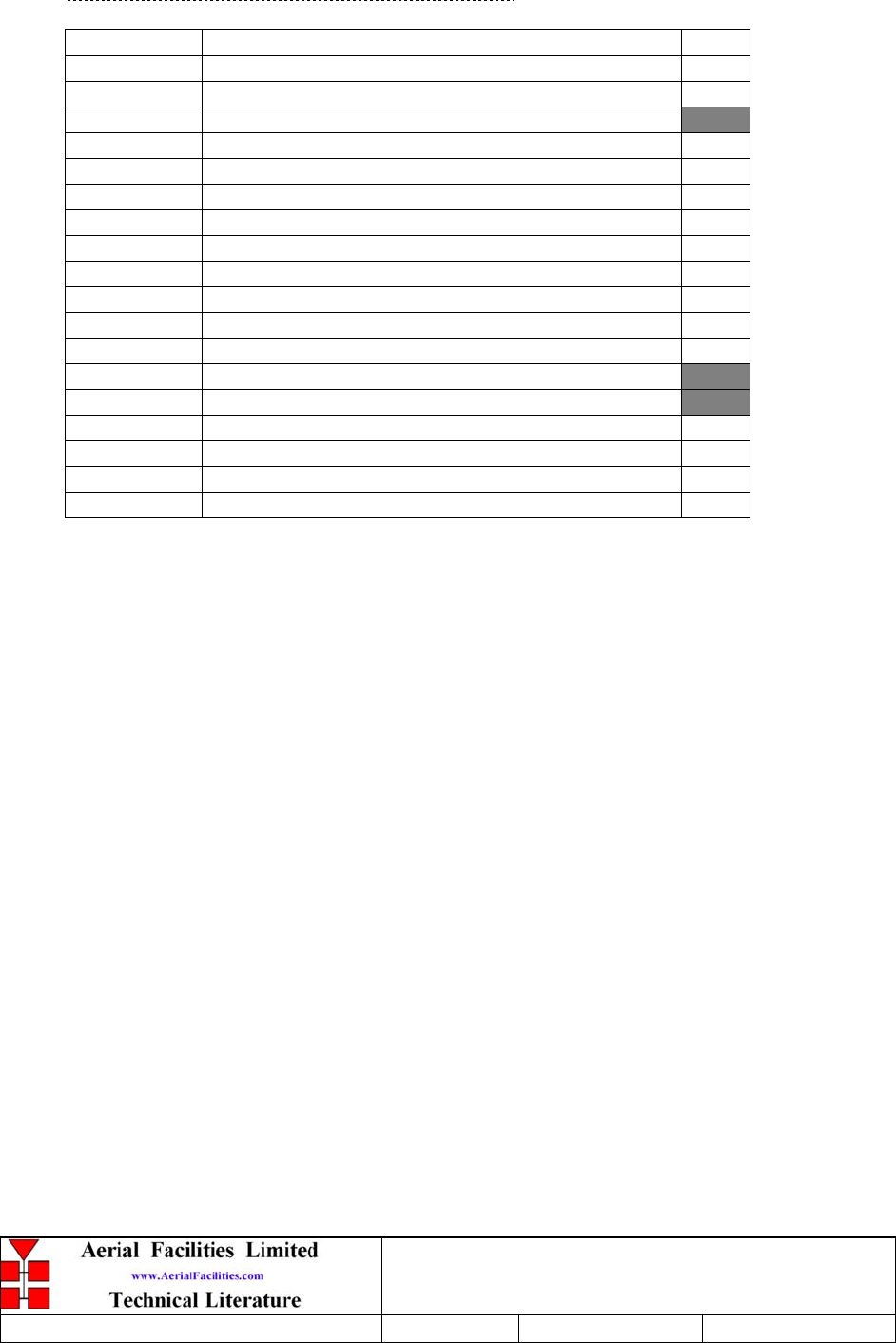
5-Way Channelised UHF Cell Enhancer
Maintenance Handbook
H/book Number:-50-060601HBKM Issue No:-1Date:-04/07/2003 Page:-13 of 54
3.1.3 Power Supply Shelf 50-060604 Parts List
19-000826 2U,3U,4U 19" UNIT 400 DEEP LID 1
19-001021 4U 19" UNIT 400 DEEP CHASSIS + BKT 1
19-001024 4U 19" UNIT FRONT PANEL FAB 1
20-001602 24V RELAY BOARD 1
80-064120 HEATSINK 4U FLATPAC 16A 10W 1
91-500025 3 PIN RIGHT ANGLE FREE PLUG NC-X 1
91-510003 3 PIN R.ANGLE FREE SOC.NC-X. 1
91-510004 3 PIN PNL.MOUNT SOCKET NC-X 3
91-520001 PWR MAINS INL FIXED/SOLD.TERMS 3
91-520004 POWER MAINS INL.FREE R/ANGLE 3
91-600001 'D'TYPE 9 WAY PLUG S/B TERM 1
92-340001 M3 x 8mm 'D'CONNECTOR SCREW LOCK 0
93-560001 VARISTOR V275LA20A 1
96-300054 24V 17A PSU 400W (XP BCC) 1
96-300056 48V 6A PSU DIN RAIL (TRACO) 1
96-700034 LED RED 5mm IP67 INTEGRAL RES. 24V 1
96-700035 LED GREEN 5mm IP67 INTEGRAL RES 24V 2
96-900018 AC TRIP SWITCH (5 AMP M.C.B.) 2
97-400002 HANDLE TYPE H6803 4U.[ALLOY] 2
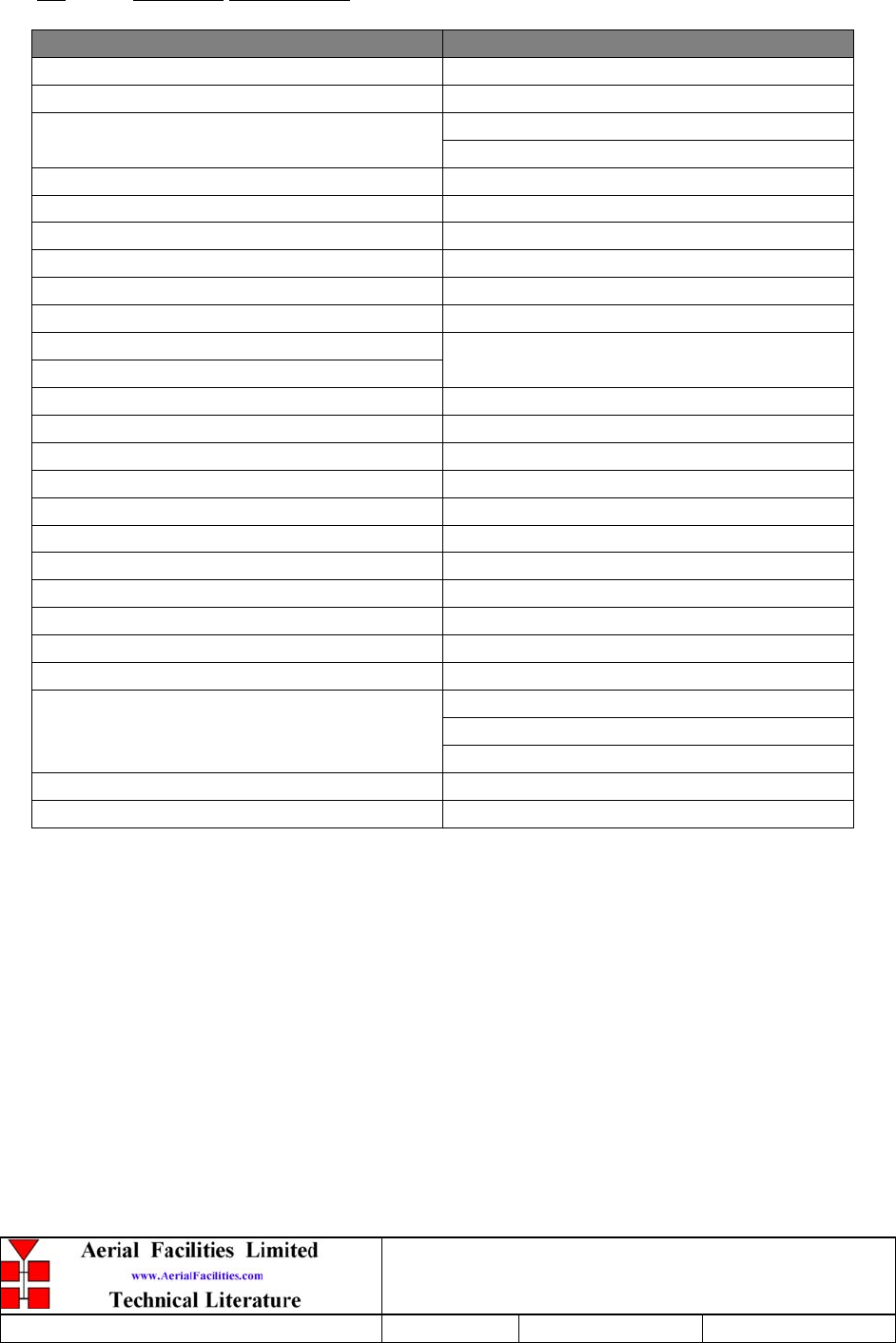
5-Way Channelised UHF Cell Enhancer
Maintenance Handbook
H/book Number:-50-060601HBKM Issue No:-1Date:-04/07/2003 Page:-14 of 54
3.2 Technical Specification
PARAMETER SPECIFICATION
Downlink Frequency Range: 453.30-453.75MHz
Uplink Frequency Range: 458.30-458.75MHz
12.5kHz adjacent channel >20dBChannel Bandwidth selectivity:
25kHz adjacent channel >80dB
Number of Channels: 5
Number of ports: 2
RF Connectors: N type, female
Impedance: 50
VSWR: Better than 1.5:1
Sensitivity: 0.35 microvolts @ 12dB SINAD
Downlink Output Power:
Uplink Output Power: 10 Watts
Uplink TOI: 50dBm
Downlink TOI: 50dBm
RF level per carrier: >+23dBm
Passband ripple: <±1.5dB
Noise figure: <6dB (@max gain)
Gain: 96dB
Gain adjustment: 0-30dB (in 2dB steps)
In band spurious: Better than –36dBm
Spurious up to 3GHz: Better than –90dBc
Input AC Supply: 120V AC
Consumption: 150 Watts
Volt-free relay contacts
Excessive VSWRAlarms:
Forward power drop
MTBF: 80,000 Hrs.
Housing: 19” Rack mounted
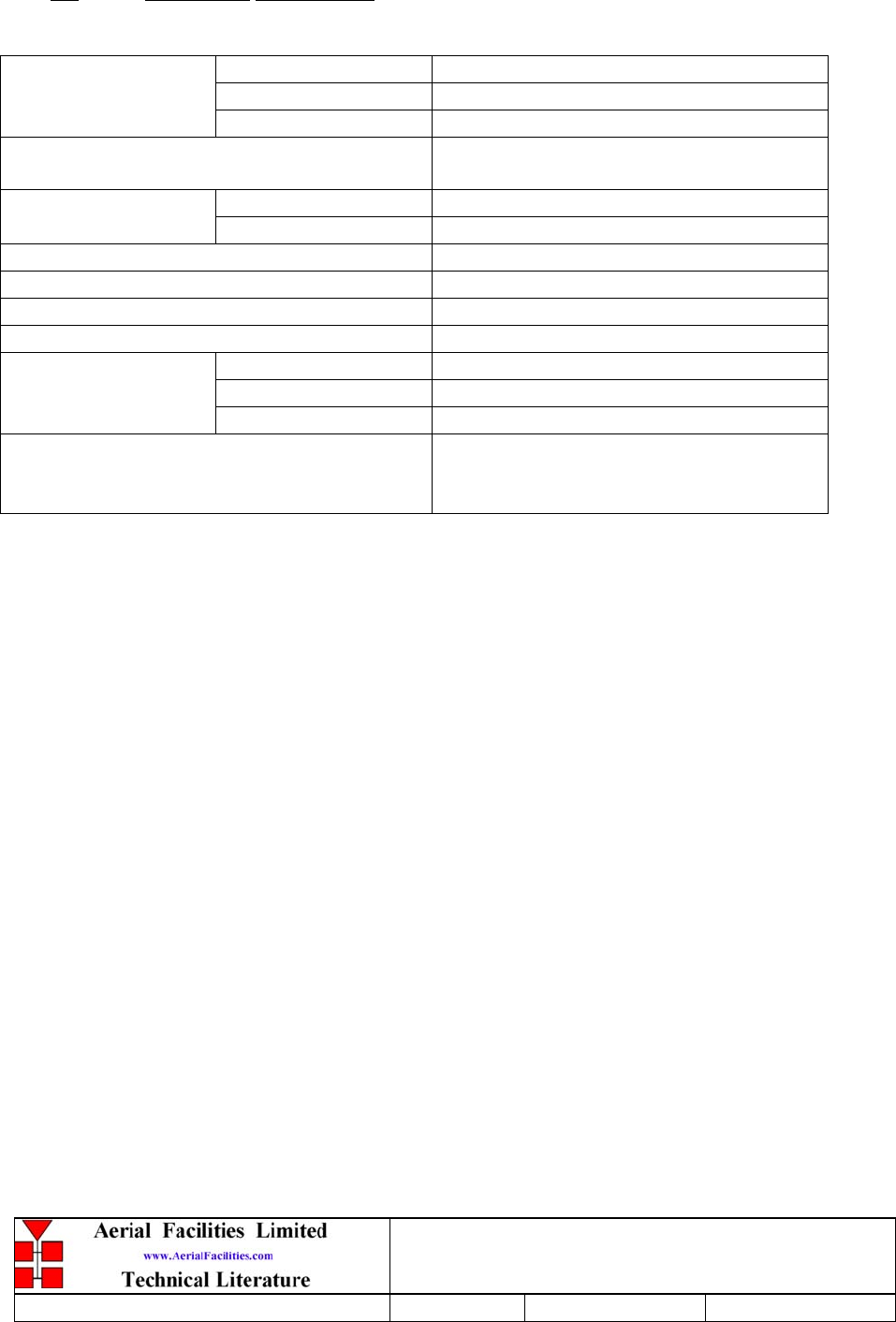
5-Way Channelised UHF Cell Enhancer
Maintenance Handbook
H/book Number:-50-060601HBKM Issue No:-1Date:-04/07/2003 Page:-15 of 54
3.3 Mechanical Specification
Height: Eurorack Shelves(1U=44.5mm)
Width: 19"Case Size:
Depth: <500mm
(excluding heatsinks, connectors, handles
and feet)
operational: -10°C to +55°C
Temperature Range: storage: -40°C to +70°C
Weight: <30kg* (approximately)
Humidity: 5 – 95% non-condensing
RF Connectors: N type female
Environmental Protection: IP54
Case: Alocrom
Heatsinks: Matt blackFinish:
Handles: Alocrom
Supply Cable:
Unit supplied with suitable supply input
leads with connector and specified length
of cable (where appropriate)
* Note: Individual shelf weights unspecified.
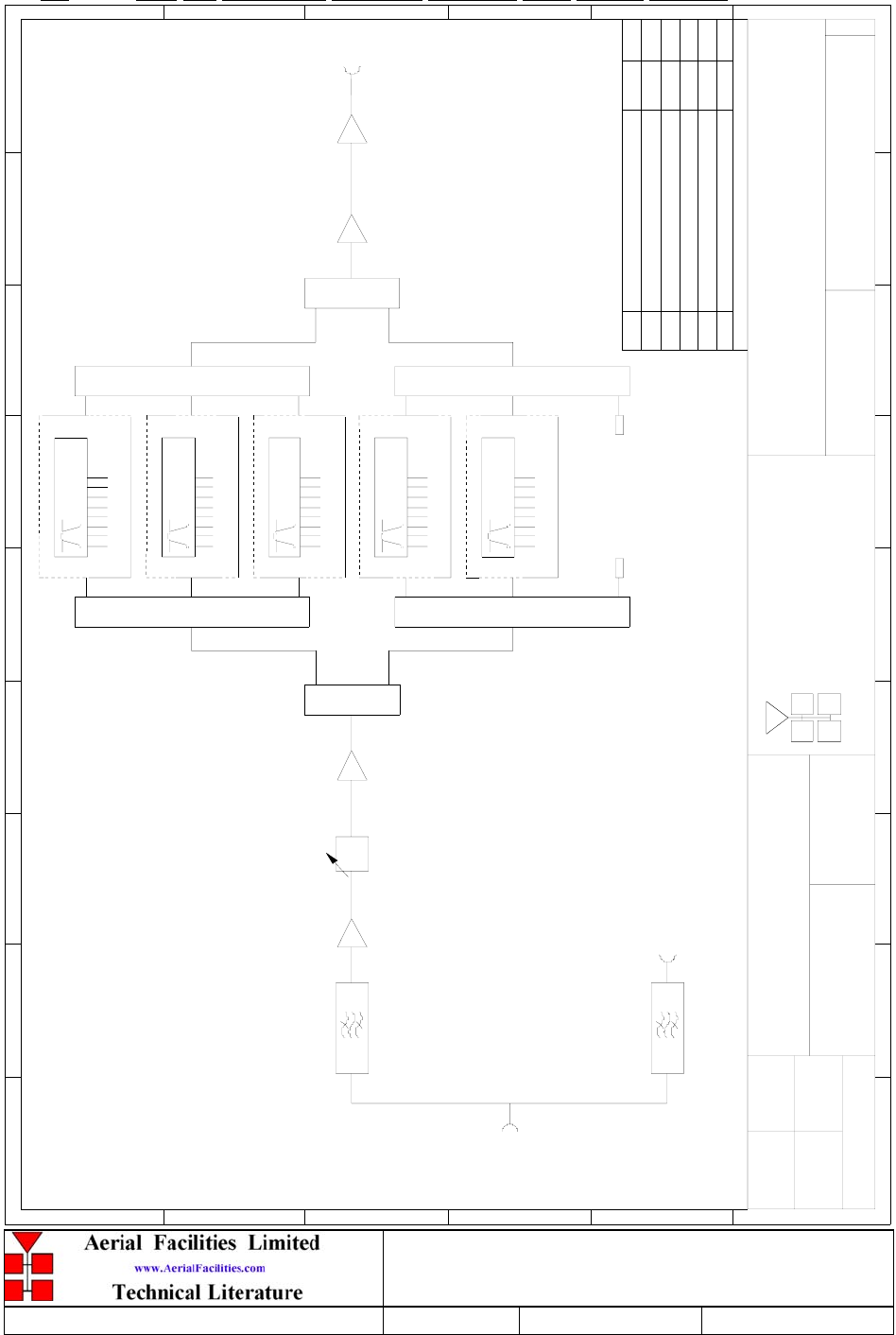
5-Way Channelised UHF Cell Enhancer
Maintenance Handbook
H/book Number:-50-060601HBKM Issue No:-1Date:-04/07/2003 Page:-16 of 54
4. SYSTEM DRAWINGS
4.1 Drg. N. 50-060682, Downlink Amplifier Shelf System Diagram
DOWNLINK CCE 80dB 10W
SYSTEM DIAGRAM
50-060682
1A
-
MNR 30/06/03
BYDAT EDESCRIPT IO NNo
ISSUE
12
3456789
A
B
C
D
E
F
1 23456789
A
B
C
D
E
F
Fax : 01494 777002
Tel : 01494 777000
Aerial Facilities Limited
THIS IS A PRO PRIETARY DESIG N O F AERIAL FACIL IT IES L TD.
REPRO DUCTION OR USE OF THIS DESIGN BY OTHERS IS
PERMISSIBL E O NL Y IF EXPRESSL Y AUTHORISED IN WRITING
BY AERIAL FACILITIES LTD.
NO DECIM AL PL ACE ± 1 mm
O NE DECIM AL PL ACE ± 0 .3 mm
TWO DECIMAL PLACES ± 0.1mm
AL L DIMENSIO NS ARE IN mm
UNLESS OTHERWISE STATED
CHKD
DRAWN
APPD
DAT E
TOLERANCES SCALE
England
CUSTO MER DRAWING .No
TITLE
3
A
dB
BANDPASS FILTER
02-010701
453-454MHz
LNA
11-007402
31dB GAIN
ATTENUATOR
0-30dB
10-000701 11-007302
31dB GAIN
LNA
SPLITTER
05-002603
05-003803
SPLITTER
05-003803
COMBINER
05-002603
COMBINER
11-007302
LNA
21dB GAIN 28dB GAIN
PA
12-001901
F REQ UENCY PRO G RAM MING DAT A
B/W=15kHz
F REQ UENCY PRO G RAM MING DAT A
B/W=15kHz
F REQ UENCY PRO G RAM MING DAT A
B/W=15kHz
F REQ UENCY PRO G RAM MING DAT A
B/W=15kHz
F REQ UENCY PRO G RAM MING DAT A
B/W=15kHz
5 x 17-003012
GAIN 20dB
ALC -15dB
CHANNEL MODULE
05-003803
SPLITTER COMBINER
05-003803
BANDPASS FILTER
458-459MHz
02-010701
BASE
A
B
P RODUCTION ISSUE MNR
30/06/03
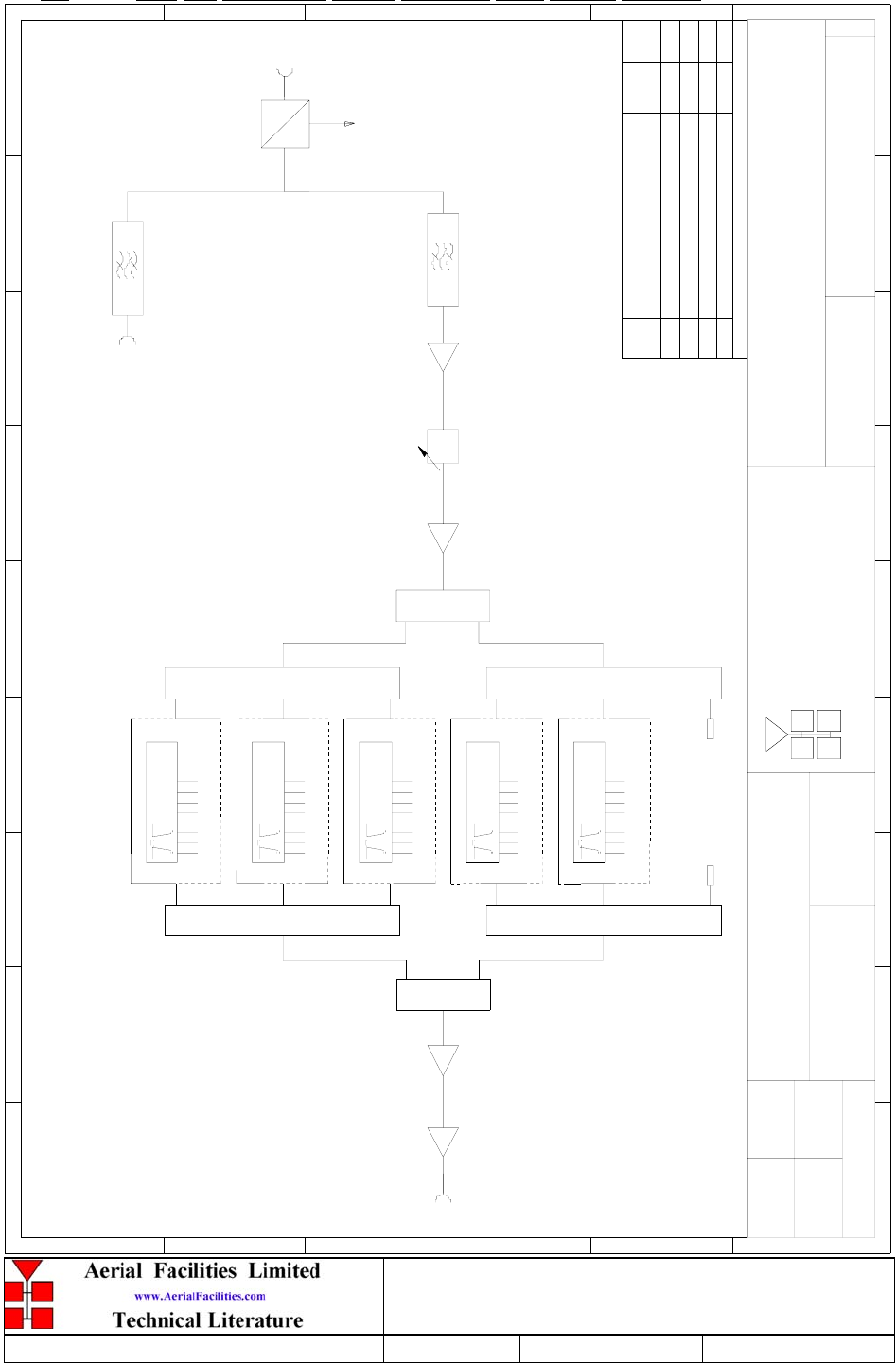
5-Way Channelised UHF Cell Enhancer
Maintenance Handbook
H/book Number:-50-060601HBKM Issue No:-1Date:-04/07/2003 Page:-17 of 54
4.2 Drg. N. 50-060683, Uplink Amplifier Shelf System Diagram
UPLINK CCE 80dB 10W
SYSTEM DIAGRAM
50-060683
1A
-
MNR 30/06/03
BYDAT EDES CRIP TIO NNo
ISSUE
12
3456789
A
B
C
D
E
F
1 23456789
A
B
C
D
E
F
Fax : 01494 777002
Tel : 01494 777000
Aerial Facilities Limited
THIS IS A PROPRIETARY DESIGN OF AERIAL FACILITIES L TD.
REP RO DUCT IO N O R USE O F THIS DESIG N BY O THERS IS
PERMISSIBLE O NL Y IF EXPRESSL Y AUTHORISED IN WRITING
BY AERIAL FACIL ITIES L TD.
NO DECIM AL PL ACE ± 1 mm
ONE DECIMAL PL ACE ± 0 .3mm
TWO DECIMAL PL ACES ± 0 .1mm
AL L DIMENSIO NS ARE IN m m
UNL ESS OTHERWISE STATED
CHKD
DRAWN
APPD
DATE
TO LERANCES SCALE
England
CUST O MER DRAWING .No
TITLE
3
A
dB
BANDPASS FILTER
02-010701
458-459MHz
LNA
11-007402
31dB GAIN
ATTENUATOR
0-30dB
10-000701
11-007302
31dB GAIN
LNA
SPLITTER
05-002603
05-003803
SPLITTER
05-003803
COMBINER
05-002603
COMBINER
11-007302
LNA
21dB GAIN28dB GAIN
PA
12-001901
FREQ UENCY PRO G RAM MING DAT A
B/W=15kHz
FREQ UENCY PRO G RAM MING DAT A
B/W=15kHz
FREQ UENCY PRO G RAM MING DAT A
B/W=15kHz
FREQ UENCY PRO G RAM MING DAT A
B/W=15kHz
FREQ UENCY PRO G RAM MING DAT A
B/W=15kHz
5 x 17-003012
GAIN 20dB
ALC -15dB
CHANNEL MODULE
05-003803
SPLITTER COMBINER
05-003803
BANDPASS FILTER
453-454MHz
02-010701
A
PRODUCTION ISSUE MNR
30/06/03
B
MOBILE
DC INJECTOR
21-001701
48V
DC
453.750MHz
453.200MHz
453.500MHz
453.600MHz
453.300MHz
SS GD
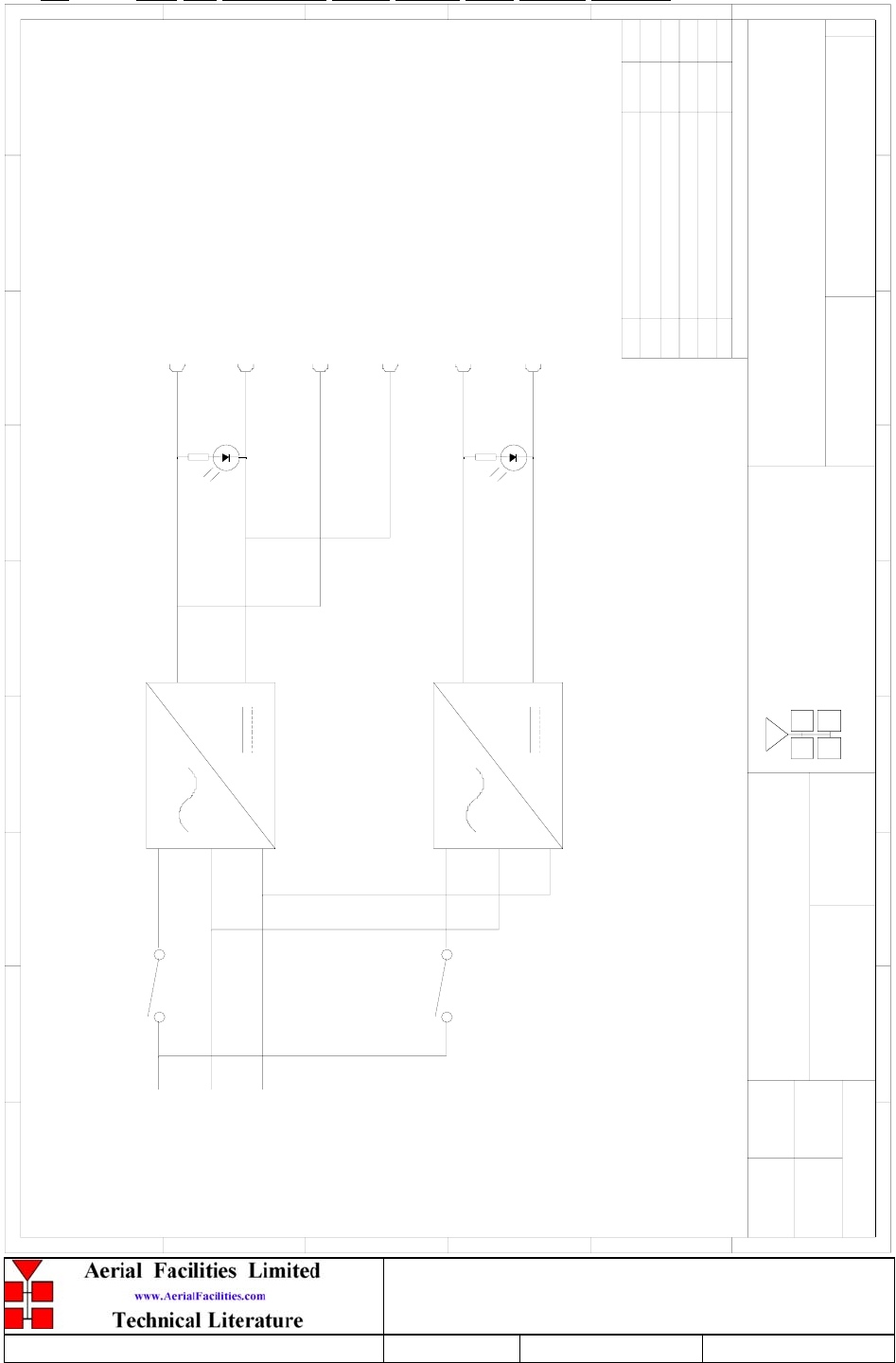
5-Way Channelised UHF Cell Enhancer
Maintenance Handbook
H/book Number:-50-060601HBKM Issue No:-1Date:-04/07/2003 Page:-18 of 54
4.3 Drg. N. 50-060684, Power Supply Shelf System Diagram
PSU FOR 50-060602 AND 50-060603
SYSTEM DIAGRAM
50-060684
1A
-
MNR 30/06/03
BYDAT EDES CRIP TIO NNo
ISSUE
12
3456789
A
B
C
D
E
F
1 23456789
A
B
C
D
E
F
Fax : 01494 777002
Tel : 01494 777000
Aerial Facilities Limited
THIS IS A PROPRIETARY DESIGN OF AERIAL FACILITIES L TD.
REP RO DUCT IO N O R USE O F THIS DESIG N BY O THERS IS
PERMISSIBLE O NL Y IF EXPRESSL Y AUTHORISED IN WRITING
BY AERIAL FACIL ITIES L TD.
NO DECIM AL PL ACE ± 1 mm
ONE DECIMAL PL ACE ± 0 .3mm
TWO DECIMAL PL ACES ± 0 .1mm
AL L DIMENSIO NS ARE IN m m
UNL ESS OTHERWISE STATED
CHKD
DRAWN
APPD
DATE
TO LERANCES SCALE
England
CUST O MER DRAWING .No
TITLE
3
A
110V AC
24V DC
PSU 96-300054
PSU 96-300056
110V AC
48V DC
L
N
E
110V AC
24V DC TO 50-060602
24V DC TO 50-060603
48V DC TO 50-060603
FOR DC INJECTORS
PRODUCTION ISSUE MNR
30/06/03
L
N
E
+
-
E
N
L
+
-
1 +
2 -
2 -
1 +
2 -
3 +
CB1
3A
3A
CB2
SS GD
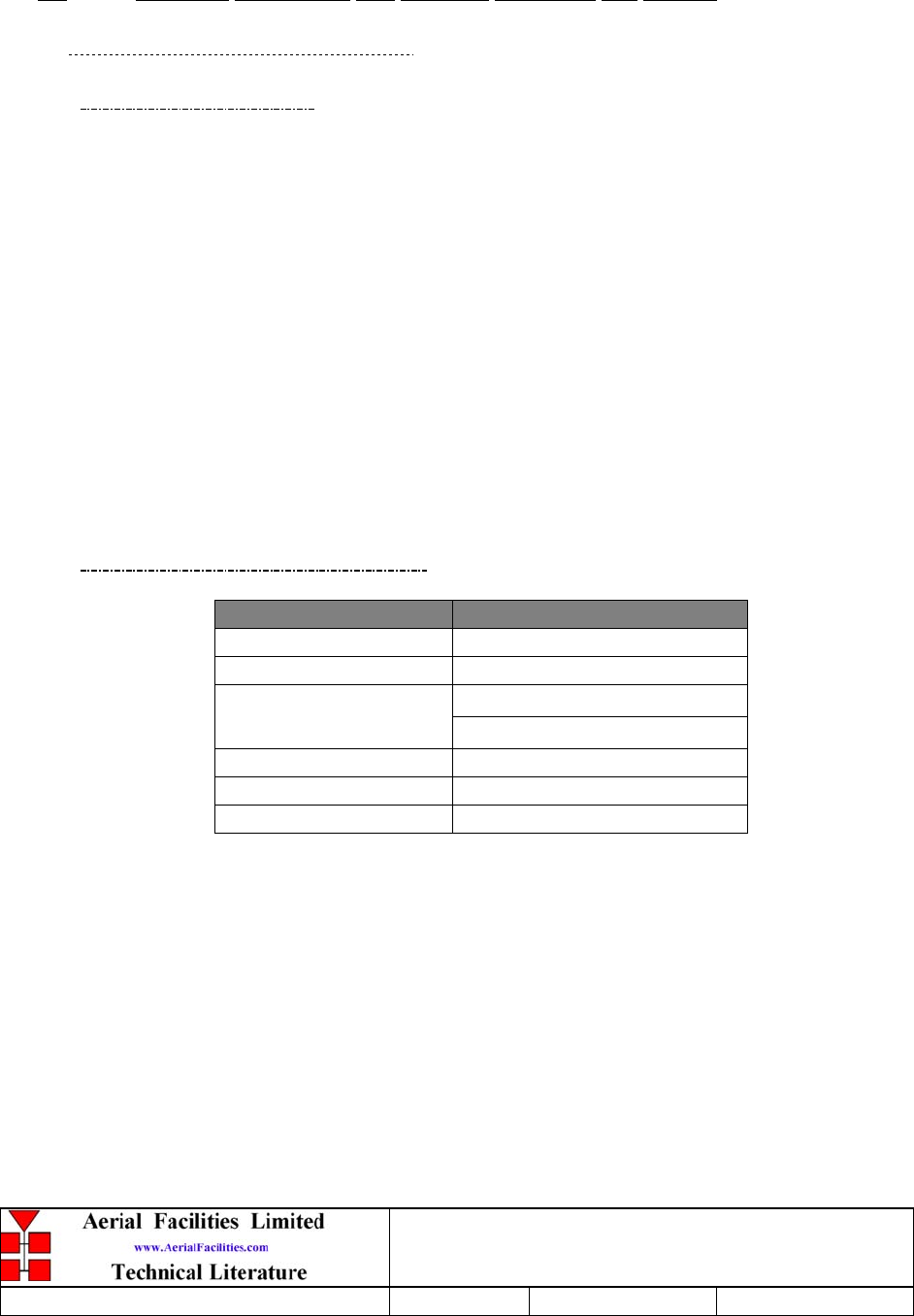
5-Way Channelised UHF Cell Enhancer
Maintenance Handbook
H/book Number:-50-060601HBKM Issue No:-1Date:-04/07/2003 Page:-19 of 54
5. SUB-UNIT MODULES
5.1 Downlink Channelised Cell Enhancer 60-060602 (5U chassis)
5.1.1 Bandpass Filters (02-010701)
5.1.1.1 Description
The bandpass filters are multi-section designs with a bandwidth dependent upon the
passband frequencies, (both tuned to customer requirements). The response shape is
basically Chebyshev with a passband design ripple of 0.1dB. The filters are of combline
design, and are carefully aligned during manufacture in order to optimise the insertion loss,
VSWR and intermodulation characteristics of the unit. The tuned elements are silver-plated
to reduce surface ohmic losses and maintain a good VSWR figure and 50 load at the input
and output ports.
Being passive devices, the bandpass filters should have an extremely long operational life
and require no maintenance. Should a filter be suspect, it is usually most time efficient to
replace the module rather than attempt repair or re-tuning.
No adjustments should be attempted without full network sweep analysis facilities to
monitor both insertion loss and VSWR simultaneously.
5.1.1.2 Technical Specification
PARAMETER SPECIFICATION
Passband 453-454 MHz
Insertion Loss 1.9 dB typical
> 456 MHz > 55 dB
Rejection > 458-459 MHz > 60 dB
Power Rating 50 Watt
Impedance 50 ohm
VSWR Better than 1.2:1
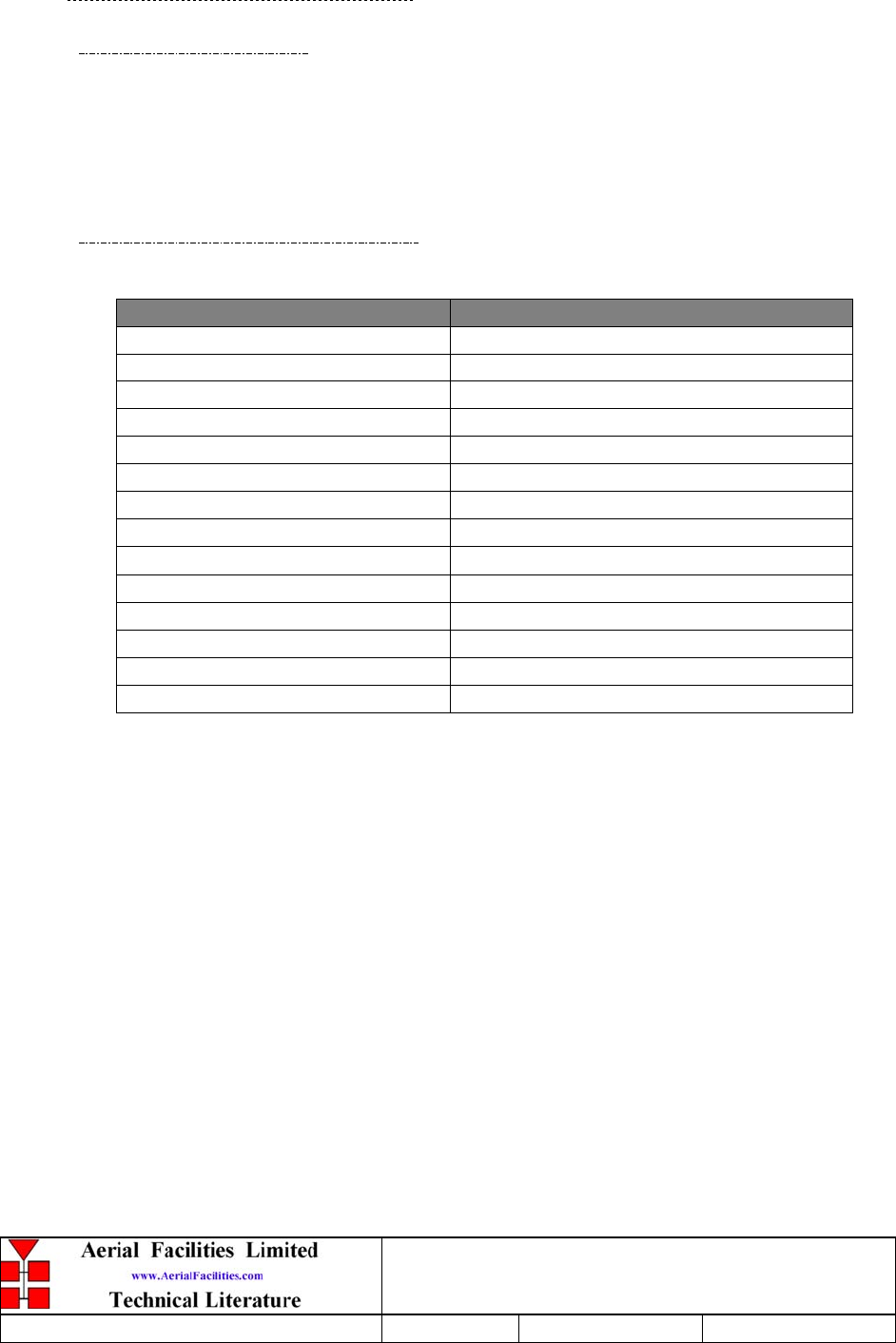
5-Way Channelised UHF Cell Enhancer
Maintenance Handbook
H/book Number:-50-060601HBKM Issue No:-1Date:-04/07/2003 Page:-20 of 54
5.1.2 UHF 3dB Splitter (05-002603)
5.1.2.1 Description
The 3dB Splitter/Combiner used is a device for accurately matching two or more RF signals
to single or multiple ports, whilst maintaining an accurate 50Ω load to all inputs/outputs and
ensuring that the VSWR and insertion losses are kept to a minimum. Any unused ports will
be terminated with an appropriate 50Ω load.
5.1.2.2 Technical Specification
PARAMETER SPECIFICATION
Frequency Range: 380 - 520 MHz
Bandwidth: 140 MHz
Inputs: 1
Outputs: 2
Insertion Loss: 3.5 dB (typical)
Isolation: >18 dB
Return Loss (VSWR) – Input: Better than 1.3:1
Return Loss (VSWR) – Output: Better than 1.3:1
Impedance: 50 ς
Power Rating – Splitter: 20 Watts
Power Rating – Combiner: 0.5 Watt
Connectors: SMA female
Size: 54 x 44 x 21 mm (including connectors)
Weight: 200 g
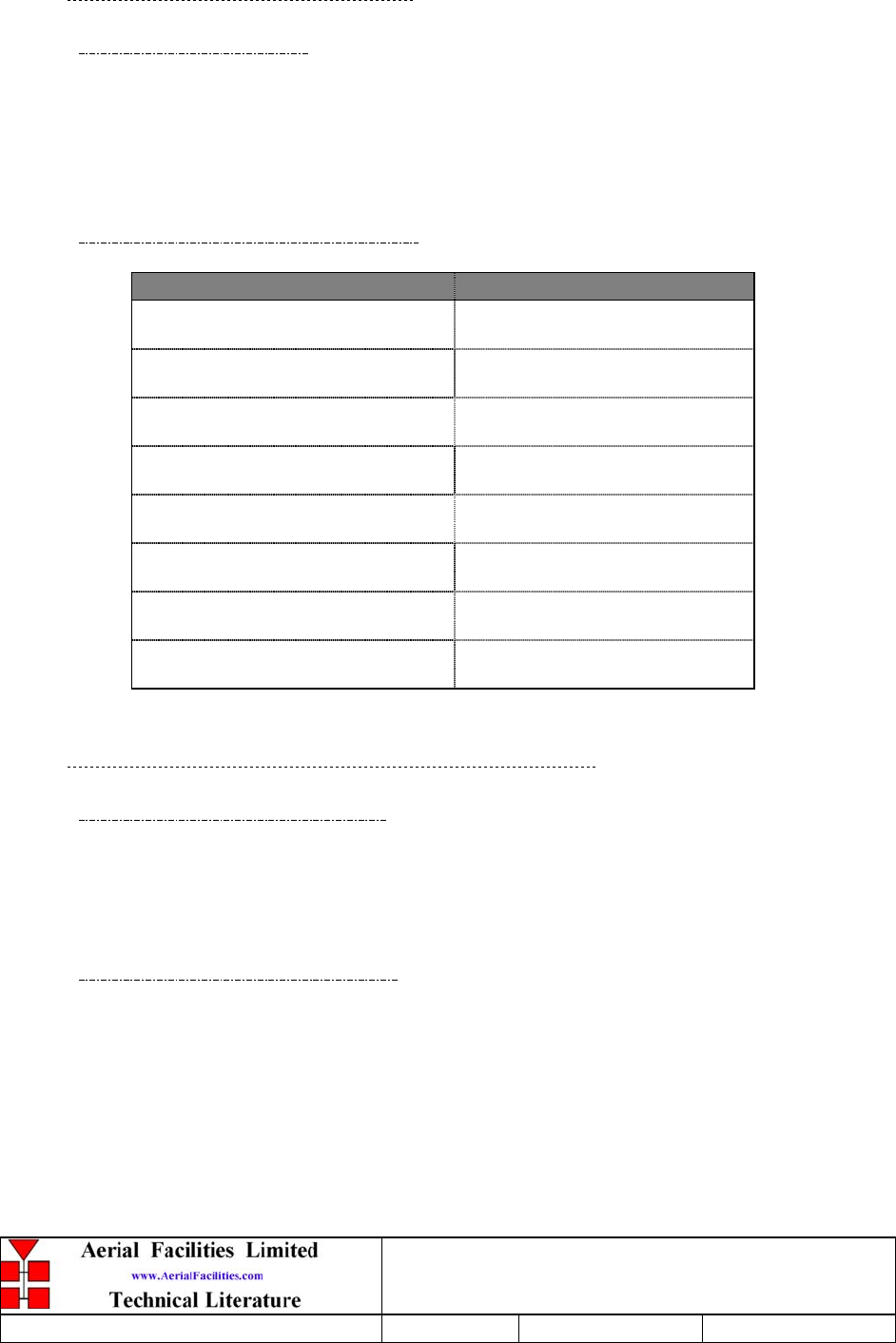
5-Way Channelised UHF Cell Enhancer
Maintenance Handbook
H/book Number:-50-060601HBKM Issue No:-1Date:-04/07/2003 Page:-21 of 54
5.1.3 3dB UHF Splitter (05-002603)
5.1.3.1 Description
The 3dB Splitter/Combiner used is a device for accurately matching two or more RF
signals to single or multiple ports, whilst maintaining an accurate 50Ω load to all
inputs/outputs and ensuring that the VSWR and insertion losses are kept to a minimum.
Any unused ports will be terminated with an appropriate 50Ω load.
5.1.3.2 Technical Specification
PARAMETER SPECIFICATION
Frequency Range: 400-500 MHz
Power Rating: 5 Watts
Insertion Loss: 5.2dB Typical
VSWR: 1.2:1
Impedance: 50 Ohms
Connectors: SMA
Weight: <0.5Kgs
Mechanical: Drawing No. 07-003890
5.1.4 ¼Watt 0- -30dB Switched Attenuator (10-000701)
5.1.4.1 General Application
In many practical applications for Cell Enhancers etc., the gain in each path is found to be
excessive. Therefore, provision is made within the unit for the setting of attenuation in
each path, to reduce the gain.
5.1.4.2 Switched Attenuators
The AFL switched attenuators are available in two different types; 0 – 30dB in 2 dB steps
(as in this case), or 0 – 15dB in 1 dB steps. The attenuation is simply set using the four
miniature toggle switches on the top of each unit. Each switch is clearly marked with the
attenuation it provides, and the total attenuation in line is the sum of the values switched
in. They are designed to maintain an accurate 50 impedance over their operating
frequency at both input and output.
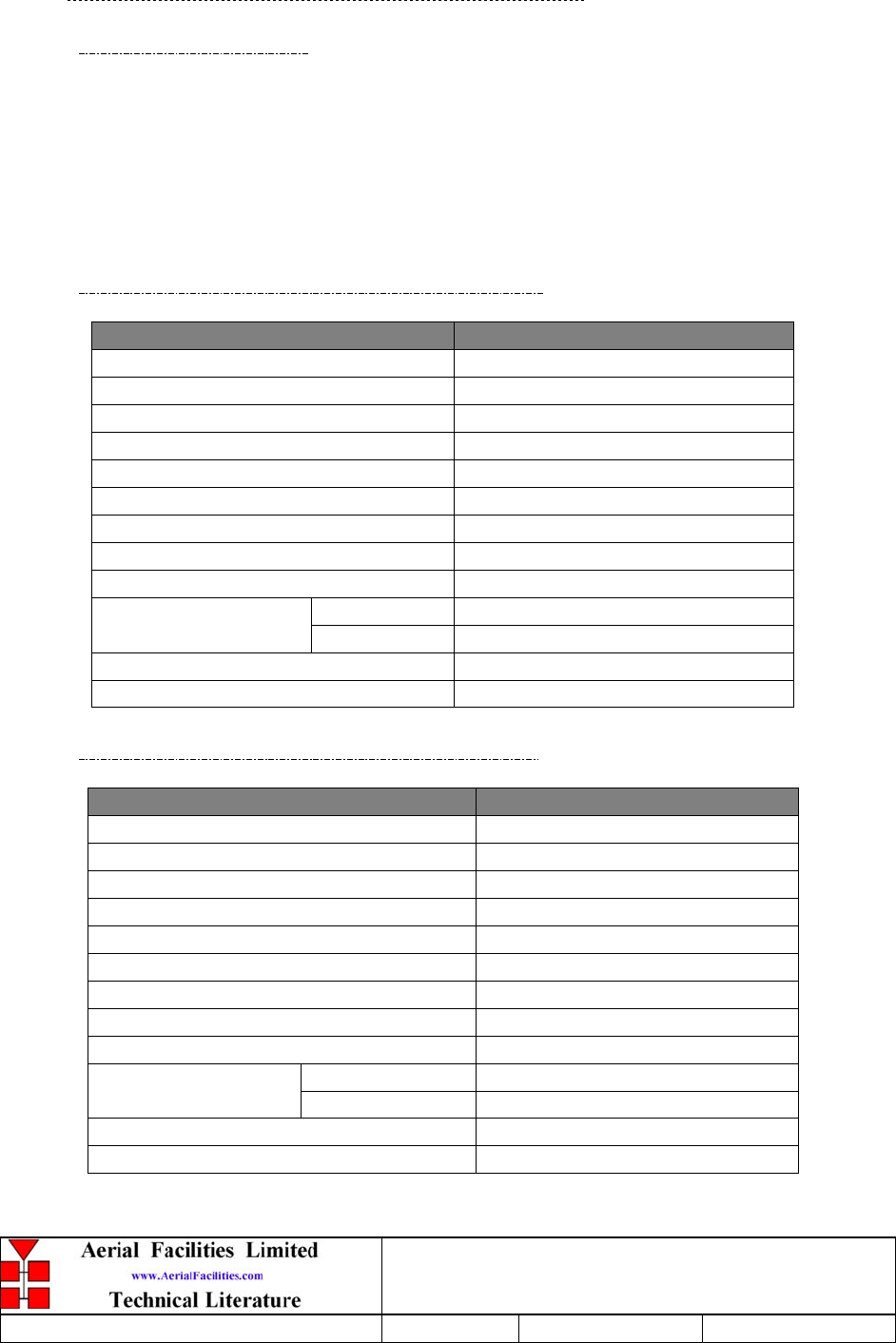
5-Way Channelised UHF Cell Enhancer
Maintenance Handbook
H/book Number:-50-060601HBKM Issue No:-1Date:-04/07/2003 Page:-22 of 54
5.1.5 Low Noise Amplifiers (11-007302 & 11-007402)
5.1.5.1 Description
The low noise amplifiers used are double stage solid-state low-noise amplifiers. Class A
circuitry is used in the units to ensure excellent linearity over a very wide dynamic range.
The active devices are very moderately rated to provide a long trouble-free working life.
There are no adjustments on these amplifiers, and in the unlikely event of failure then the
entire amplifier should be replaced. The two amplifiers are very similar in construction,
the only difference is the biasing, which changes the gain figure, see tables below.
5.1.5.2 Technical Specification, (11-007302)
PARAMETER SPECIFICATION
Frequency range: 380-500MHz
Bandwidth: <140MHz
Gain: 20-22dB
1dB Compression Point: +23.5dB (typical)
3rd order intercept: +36dB (typical)
Input/Output return loss: >20dB
Noise figure: <1.3dB
Connectors: SMA female
Supply: 200-230mA @ 24V DC
operational: -10°C to +55°C
Temperature range: storage: -30°C to +70°C
Weight: <300gms
Size: 90 x 55 x 30.2 (case only)
5.1.5.3 Technical Specification (11-007402)
PARAMETER SPECIFICATION
Frequency range: 380-500MHz
Bandwidth: <140MHz
Gain: 30-32dB
1dB Compression Point: +22dBm (typical)
3rd order intercept: +34-35dBm (typical)
Input/Output return loss: >20dB
Noise figure: <1.3dB
Connectors: SMA female
Supply: 300-330mA @ 24V DC
operational: -10°C to +55°C
Temperature range: storage: -30°C to +70°C
Weight: <300gms
Size: 90 x 55 x 30.2 (case only)
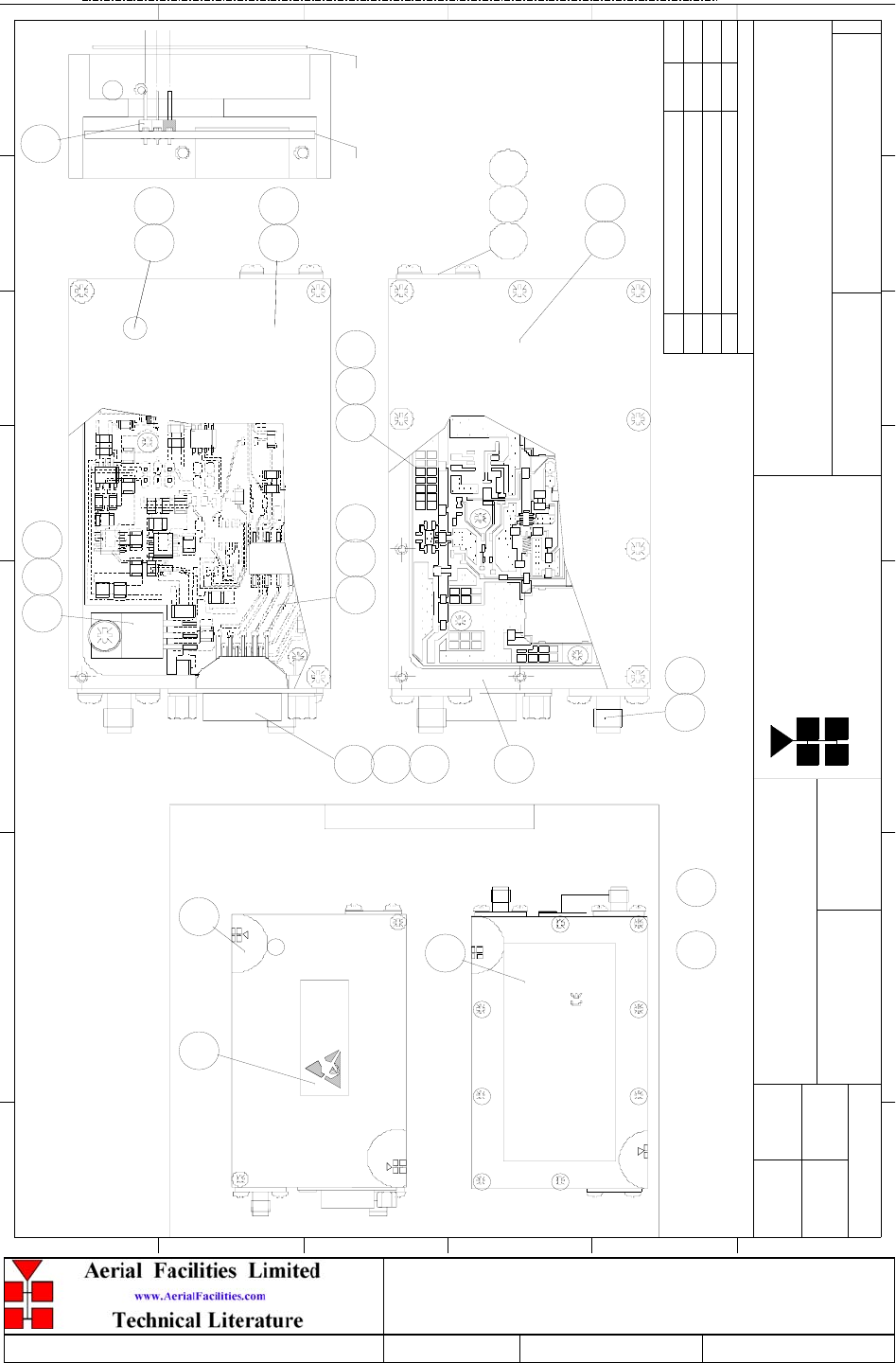
5-Way Channelised UHF Cell Enhancer
Maintenance Handbook
H/book Number:-50-060601HBKM Issue No:-1Date:-04/07/2003 Page:-23 of 54
5.1.5.3 Drg. N. 11-007302, LNA Assembly With Alarm Relay
BYDAT EDES CRIPTIO NNo
ISSUE
1 23 456 78 9
A
B
C
D
E
F
1
2
3
4
5
6
7
8
9
F
E
D
A
B
C
Fax : 01494 777002
Tel : 01494 777000
Aerial Facilities Ltd
TWO DECIMAL PLACES ± 0.1mm
ONE DECIMAL PL ACE ± 0 .3 mm
NO DECIMAL PL ACE ± 1 mm
BY AERIAL F ACIL IT IES L TD.
PERMISSIBLE ONLY IF EXPRESSL Y AUTHORISED IN WRITING
REPRO DUCTION OR USE OF THIS DESIGN BY O THERS IS
THIS IS A PROPRIETARY DESIGN OF AERIAL FACILITIES LTD.
DRAWN
CHKD
AL L DIM ENSIO NS ARE IN mm
UNL ESS O THERWISE STAT ED
APPD
DAT E
T O L ERANCES SCALE
England
CUSTO MER DRG.No
TITLE
A
3
LOW NOISE AMPLIFIER 380-500MHz
(20dB) ASSEMBLY DRAWING (WITH RELAY)
11-007302
1A
1.5:1
DBS 9/7/02
PRODUCTION ISSUE
9/7/02
DBS
COMPONENTS TO BE ADDED TO 11-003912,ITEM 15,DC PCB SUB-ASSEMBLY
AFL
SENSITIV E
DEVICES
E LE C TR O S TA TI C
OBSERVE PRECAUTIONS
ATTENTION
FOR HA NDLIN G
AFL
AFL
********
11-007302
380-500MHz
20dB 10-24V DC
**/**/20**
REF .
FREQ.
GAIN
S/N
DAT E
0086
IN
34
see note 2
LABEL DETAILS - SCALE 1:1
35
see note 2
see note 2
31
IN 4 PLACES
2. LIDS,ITEMS 2 & 3 AND LABELS,ITEMS 31,34 & 35,TO BE FITTED ON TEST
1. SOLDER JOINTS TO BE MADE USING OR
2819
OUT
6
IN 3 PLACES
3
DC PCB
25
4
732
RF PCB
15
W6
21
2
C2
1
22
2
CPL 1
R1
C1
RF O UT
R1 9
W7
C2 1
5
C9
R2
R1 6
C5
L1
L3
C4 C8
+
R4
TR1
L5 C1 2
J31 J32
W5
W2 W1
225
10
17 24
2
33
2
27
5
27
2
20
2
16 23
5
24
2
IN 2 PLACES
4
26830
R3 9
REG 3
J3 J1J2
R5 0 R4 9
R4 4R4 3
RL 1
CO N1
CB IB
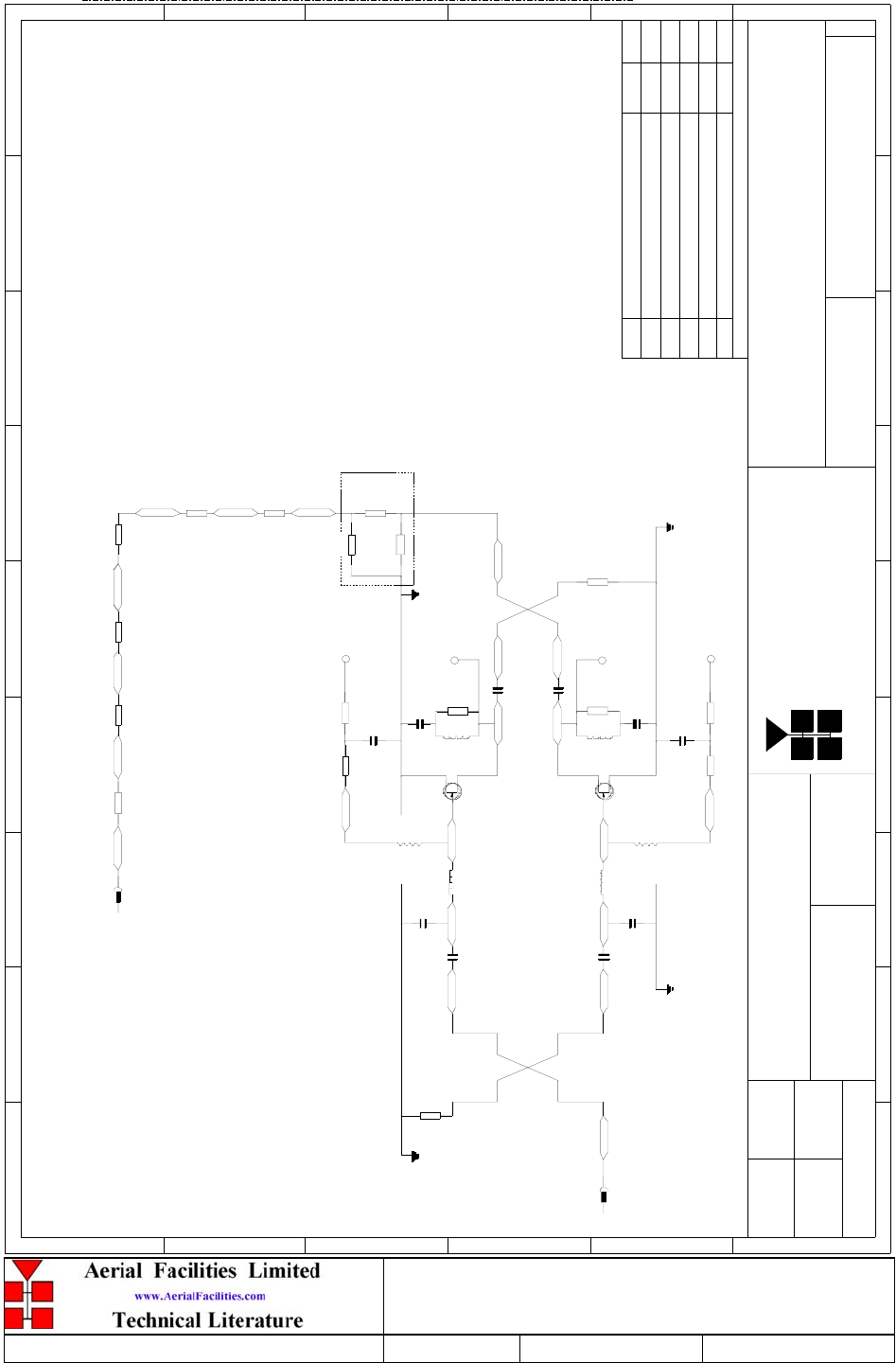
5-Way Channelised UHF Cell Enhancer
Maintenance Handbook
H/book Number:-50-060601HBKM Issue No:-1Date:-04/07/2003 Page:-24 of 54
5.1.5.4 Drg. N. 11-007370, LNA RF Circuit Diagram
BYDAT EDES CRIP TIO NNo
ISSUE
12
3456789
A
B
C
D
E
1 23456789
A
B
C
D
E
F
Fax : 01494 777002
Tel : 01494 777000
Aerial Facilities Limited
THIS IS A PROPRIETARY DESIGN OF AERIAL FACILITIES L TD.
REP RO DUCT IO N O R USE O F THIS DESIG N BY O THERS IS
PERMISSIBLE O NL Y IF EXPRESSL Y AUTHORISED IN WRITING
BY AERIAL FACIL ITIES L TD.
NO DECIM AL PL ACE ± 1 mm
ONE DECIMAL PL ACE ± 0 .3mm
TWO DECIMAL PL ACES ± 0 .1mm
AL L DIMENSIO NS ARE IN m m
UNL ESS OTHERWISE STATED
CHKD
DRAWN
F
APPD
DAT E
T O L ERANCES SCALE
England
CUST O MER DRAWING .No
TITLE
3
A
LOW NOISE AMPLIFIER 380-500MHz
(20dB) RF PCB CIRCUIT DIAGRAM
11-007370
1A
-
DBS 5/7/02
CLY2
TR 2
RF INPUT
R1
51R
11303- 3
CPL1
1nF
C3
Ø1.6x6 turns
L2
3. 3pF
C7
L4
330nH
R3
100R 10K
R6
1nF
C6
1nF
C1
C4
3. 3pF
Ø1.6x6 turns
L1
330nH
L3
100R
R2 R5
10K
J31
C5
1nF
TR 1
CLY2
560R
R7
100nH
L6
C10
1nF
C9
1nF
R4
560R
100nH
L5
1nF
C13
1nF
C12
51R
R8
11303- 3
CPL2
R9
R11
0R 0
R10
0R 0
W1
W5
0R 0
RF OUTPUT
0R 0
W6
0R 0
R19
HEADER PIN
HEADER PIN
J32
HEADER PIN
J12
HEADER PIN
J11
PRODUCTION ISSUE
5/7/02
DBS
0R 0
W2
0R 0
W7
ATTENUATOR GROUP
(Select values on Test)
D
G S
D
GS
ECN2718 DBS
19/9/02
2A
CB IB
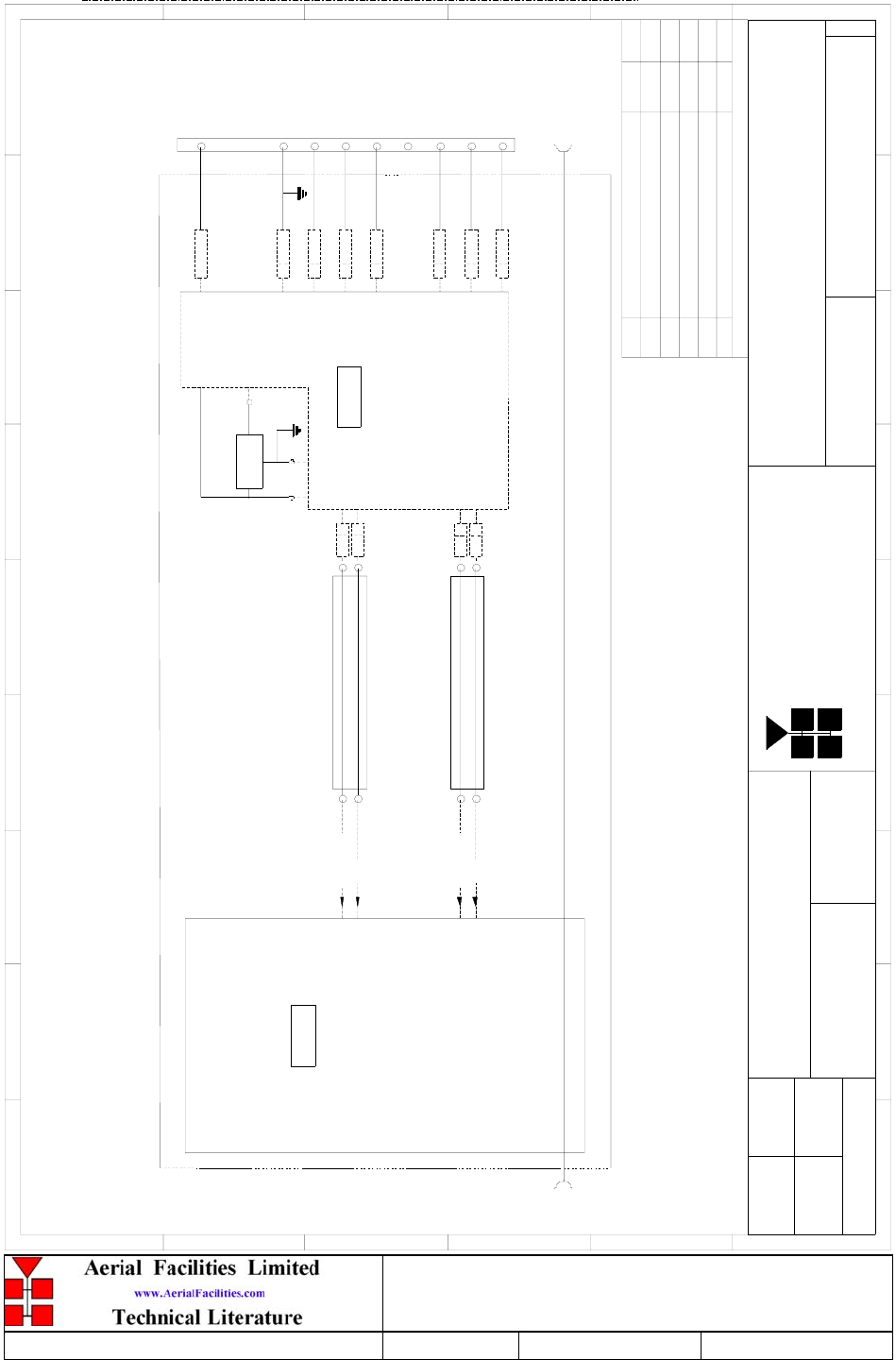
5-Way Channelised UHF Cell Enhancer
Maintenance Handbook
H/book Number:-50-060601HBKM Issue No:-1Date:-04/07/2003 Page:-25 of 54
5.1.5.5 Drg. N. 11-007371, LNA DC Wiring Diagram
BYDA T EDES CRIP TIO NNo
ISSUE
12
3456789
A
B
C
D
E
F
1 23456789
A
B
C
D
E
F
Fax : 01494 777002
Tel : 01494 777000
Aerial Facilities Limited
THIS IS A PROPRIETARY DESIGN OF AERIAL FACIL ITIES L TD.
REP RO DUCT IO N O R USE O F THIS DESIG N BY O THERS IS
PERMISSIBLE O NL Y IF EXPRESSLY AUTHORISED IN WRITING
BY AERIAL FACIL ITIES L TD.
NO DECIM AL PL ACE ± 1 mm
ONE DECIMAL PL ACE ± 0 .3mm
TWO DECIMAL PL ACES ± 0 .1mm
AL L DIMENSIO NS ARE IN m m
UNL ESS OTHERWISE STATED
CHKD
DRAWN
APPD
DATE
T O L ERANCES SCALE
England
CUST O MER DRAWING .No
TITLE
3
A
LOW NOISE AMPLIFIER. 380-500MHz
(20dB) RF SCHEMATIC DIAGRAM
11-007371
1A
-
DBS 8/7/02
LM7808CT
REG 3
G
IO
-ve
J11 - J12
DC INPUT DC O UT PUT
RF PCB
FOR CIRCUIT DIAGRAM
SEE 11-007370
SEE 11-003971
FOR CIRCUIT DIAGRAM
DC PCB
+8V C
BA
RF
IN
PRODUCTION ISSUE
8/7/02
DBS
OUT
RF
OC GOOD/0v BAD9 CON1
9
REL AY CO NTACT G O O D
REL AY COM MO N
RELAY CONTACT BAD
PIN OUTS
9 WAY 'D'
TTL VO LTAG E SET
TTL AL ARM/0v GOOD
GROUND
10-24V DC I/P
7 CON1
8 CON1
5 CON1
4 CON1
6
8
7
5
4
A
3 CON1
2 CON1
3
2
CO N1
1
5V 75mA
-ve
J31 - J32
J31 1
J32 2
J12 2
J11 15V 75mA
CB IB
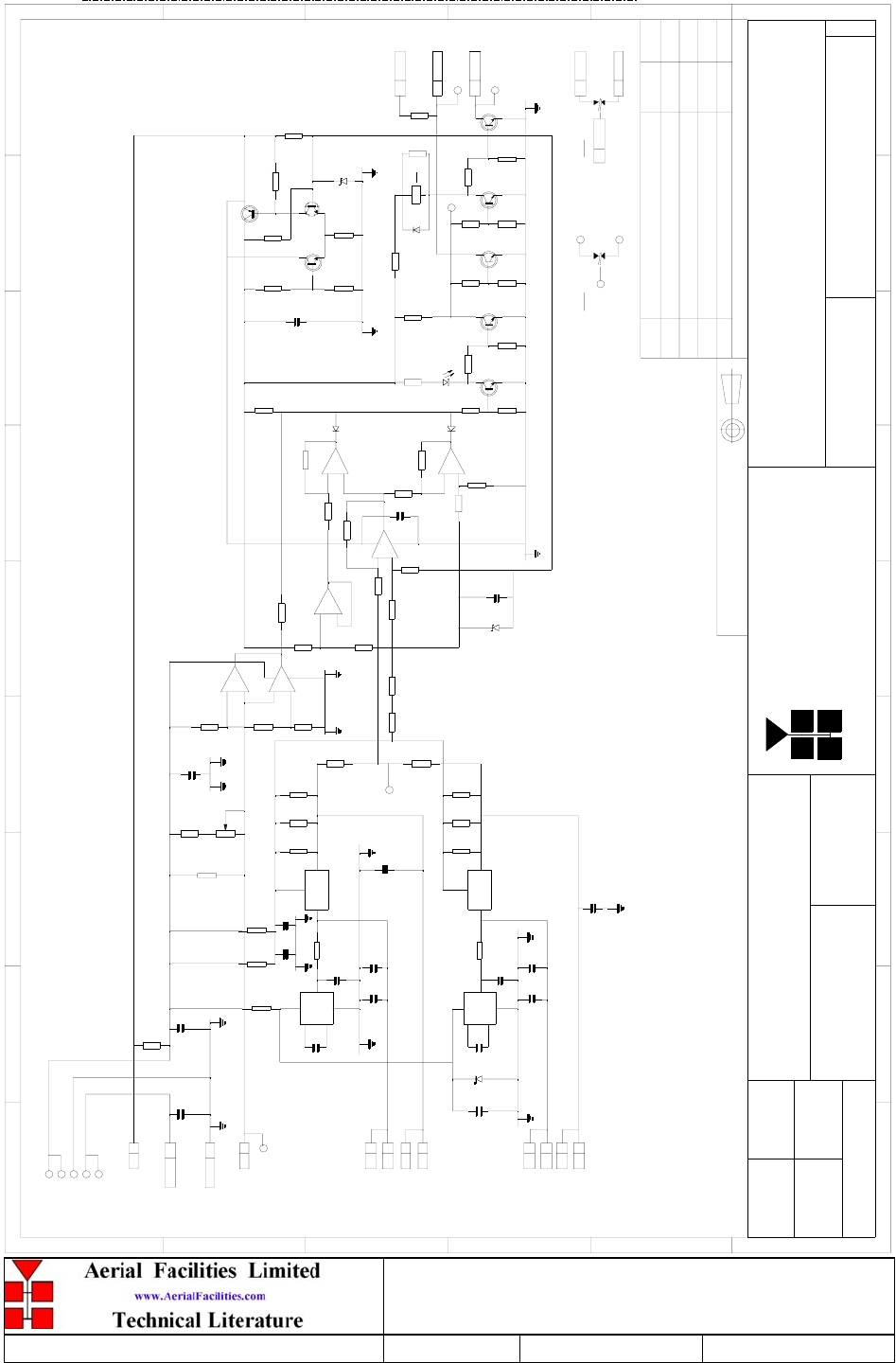
5-Way Channelised UHF Cell Enhancer
Maintenance Handbook
H/book Number:-50-060601HBKM Issue No:-1Date:-04/07/2003 Page:-26 of 54
5.1.5.6 Drg. N. 11-003971, LNA DC Circuit Diagram
BYDA T EDES CRIP TIO NNo
ISSUE
12
3456789
A
B
C
D
E
F
1 23456789
A
B
C
D
E
F
Chesham(01494)778301
Fax (01494)778910
Aerial Facilities Limited
TWO DECIMAL PL ACES ± 0 .1mm
ONE DECIMAL PL ACE ± 0 .3mm
NO DECIM AL PL ACE ± 1 mm
BY AERIAL FACIL ITIES L TD.
PERMISSIBLE O NL Y IF EXPRESSLY AUTHORISED IN WRITING
REP RO DUCT IO N O R USE O F THIS DESIG N BY O THERS IS
THIS IS A PROPRIETARY DESIGN OF AERIAL FACIL ITIES L TD.
DRAWN
CHKD
UNL ESS OTHERWISE STATED
AL L DIMENSIO NS ARE IN m m
APPD
DATE
T O L ERANCES SCALE
England
CUST O MER DRAWING .No
TITLE
A
3
DC PCB FOR LNA's AND LPA's,
CIRCUIT DIAGRAM
11-003971
DJL 24/09/01
PROTOTYPE ISSUEAA
2 4 /9 /0 1
DJL
THIRD ANGL E PROJECTION
R33
4K 7
TR 7
BCW71
R32
10K
BCW71
R31
4K 7
TR 8
R34
10K
R21
4K 7
R20
10K
TR 1
R24
BCW71
TR 2
R23
4K 7
R22
10K
TR 3
R25
4K 7
10K
BCW71
R11
120R
R12
3K 6
270K
R10
R9
1K
C2
100n
R6
100K
R4
100K
R8
270K
1K
R7
2
+C8
REG1
IO
A
1K
R47
+C4 +C5
R43 R44 R45
+C10
100n
C11
IC2
8
5
3
4
C15
10u
C17 +C16
100n
R52
+C14
3
4
IC3
28
5
R49
1K REG2
IO
A
R51 R50
+C13
R46
1K
R48
1K
R39 R40
R38
100R
R42
VR1
R41
+
-
1
2
3
-
+
5
6
7
-
2
+
3
1
R53
R54
R55
RL1
1
R35
1K
TR 4
TR 6
R16
1K
R17
2K 2
22K
R18
R19
560R
R15
2K 4
+
C3
R14
3K
R3
100K
R2
120R
100K
R5
R29
0R
1K 8
R1
4K 7
R36
56R
R27
R13
4K 7
TR 5
FZT751
BCW71
1U
BCW71
3V 3
D3
9-
+
10
8
12
+
-
13
14
6-
+
5
7
IC1:C
IC1:B
IC1:D
11
4
LM 324M
LM 324M
LM 324M
IC1:A
LM324M
ZD 1
1. 23V
LL4148
D2 LE D 1
IC4:B
IC4:A
+
C12
1u
10u
+
C9
10u
1u 1u
>12V DC I/P
10u
ZD 3
5. 1V 10u
470R
R56
R57
D1
LL4148
CON 1 1
J2 2
9CON 1
CON 18
4CON 1
5CON 1
CON 13
RL1/1
ZD 2
C19
100n
4
8
LM 337LM
10u
10u
LL4148
1. * IF APPLICABLE, VALUES WILL BE DETERMINED AT A HIGHER LEVEL BOM
I C L7660C
I C L7660C
LM 337LM
2
J2 1
1J1
2J5
2J1
1J5
1J3
2J4
2J3
1J4
CON 1
+
C1
1u
C7
470p
+
C6
10u
+
C18
1u
2. CONNECTORS J1-5 TO BE FITTED AS NECESSARY
PRODUCTION ISSUE(ECN2359)
26/11/01
TAS1A
V_OUT
V_IN
B
C
A
*
**
***
***
*
P3
*
R58
7CON 1
R59
1K
CB IB
2A ECN2518
1 7 /4 /0 2
DJL
P5
P4
RL1/2 P8
P6
P7
P1
P2
R28
0R
*
*
*
*
*
*
*
*
3A ECN2686
2 5 /7 /0 2
DJL
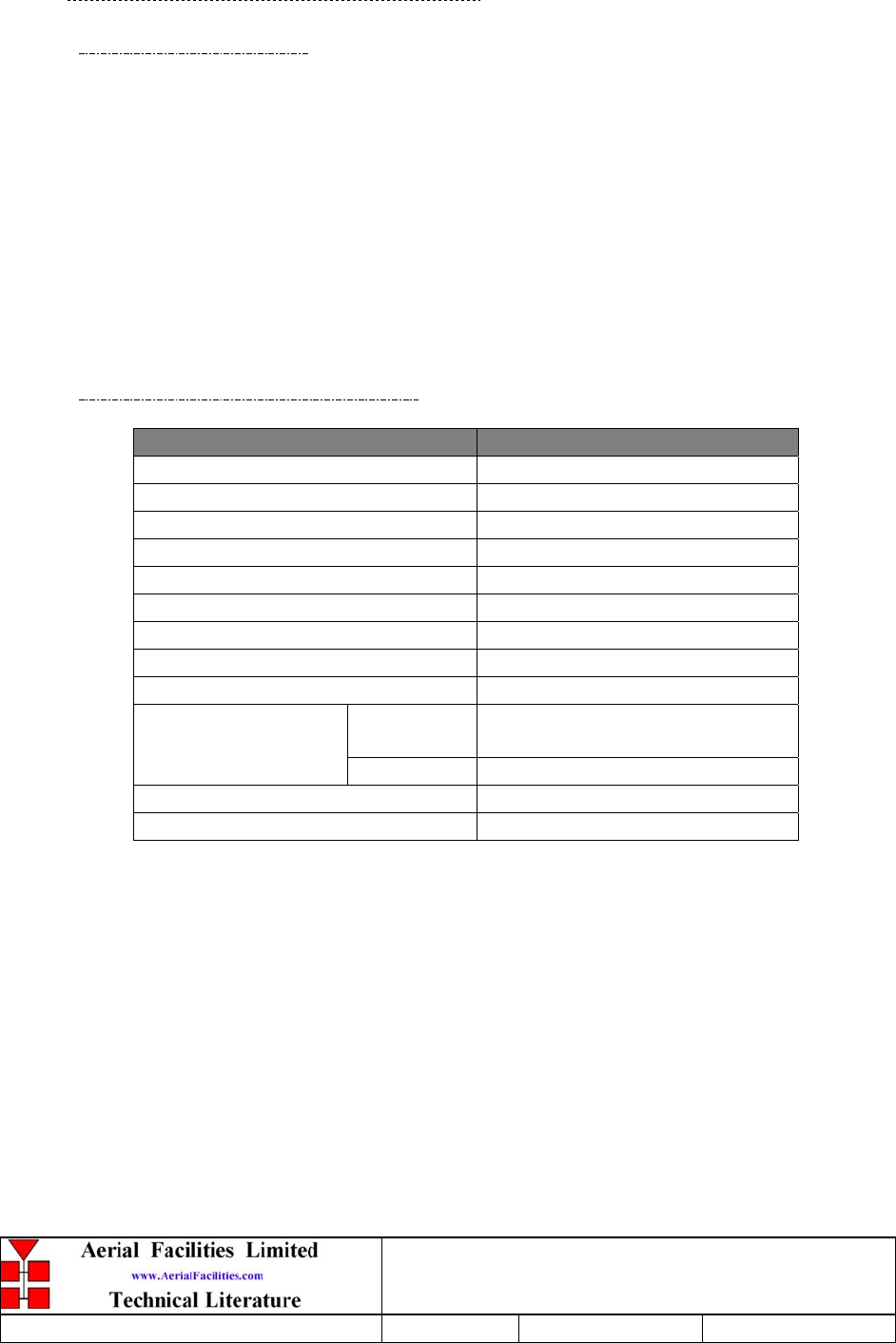
5-Way Channelised UHF Cell Enhancer
Maintenance Handbook
H/book Number:-50-060601HBKM Issue No:-1Date:-04/07/2003 Page:-27 of 54
5.1.6 10Watt Power Amplifier (12-001901)
5.1.6.1 Description
The power amplifier fitted to this unit is a multi-stage, solid state class A power
amplifier. All the semi-conductor devices are very conservatively rated to ensure low
device junction temperatures and a long, trouble free working lifetime. The amplifier was
originally designed to have a 20W power output, but in this instance, the biasing is
changed to give the device a 10W rating.
The power amplifier should require no maintenance over its operating life. Under no
circumstances should the cover be removed or the side adjustments disturbed unless it is
certain that the amplifier has failed; since it is critically aligned during manufacture and
any re-alignment will require extensive test equipment.
5.1.6.2 Technical Specification
PARAMETER SPECIFICATION
Frequency Range: 400 - 500MHz (tuned to spec.)
Bandwidth: 20MHz (typical, tuneable)
Maximum Output Power: >10W
Gain: 28dB
3rd Order Intercept Point: <+51dBm
1dB Compression Point: <+40dBm
VSWR: better than 1.45:1
Connectors: SMA female
Supply: 2.5A @ 24V DC
operational
:
-10°C to +55°C
Temperature range:
storage: -40°C to +70°C
Size: 276 x 78 x 40mm (case only)
Weight: 1.5 kg (excluding heatsink)
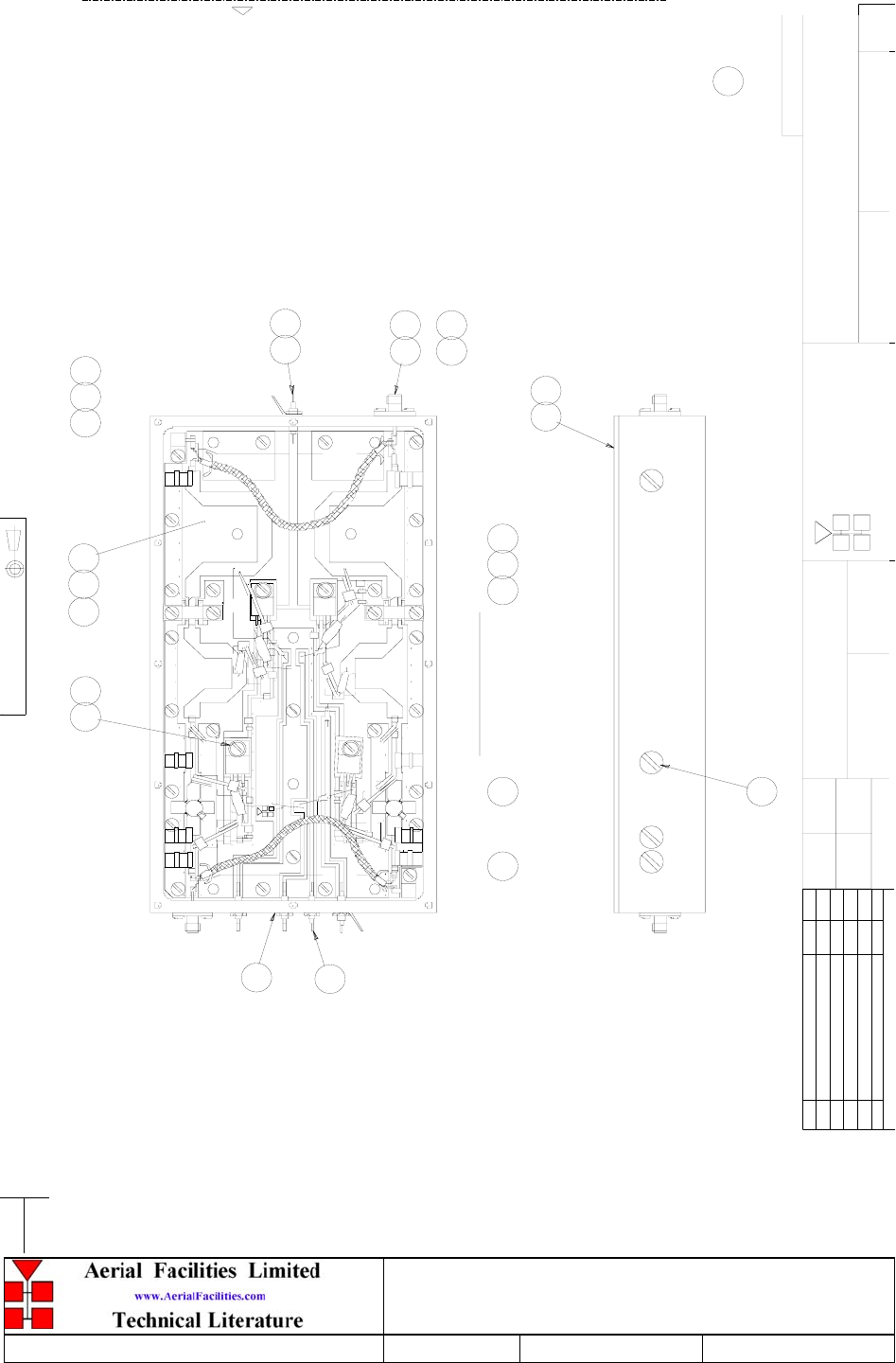
5-Way Channelised UHF Cell Enhancer
Maintenance Handbook
H/book Number:-50-060601HBKM Issue No:-1Date:-04/07/2003 Page:-28 of 54
5.1.6.3 Drg. N. 12-001901, 10W PA PCB Sub-Assembly
ASS0 1 3 0
POWER AMPLIFIER,450MHz,20W
GENERAL ASSEMBLY
12-001901 2A
1:1
DBS 17/09/92
15
1
14
1
20
1
4 P0 SNS
24
1
6
8
1
18
4
9
1
18
4
20
2
24
2
12
1
23
24
18
24
1
4
519
21
1
IN 4 PO SNS
26
10
1
2 P0 SNS
18
1
23
1
11
IN 2 PL ACES
11
IN 3 PLACES
DATEDESCRIP TIONNo
ISSUE
THIRD ANGLE PROJECTION
USE D O N
STO CK REF :
DRAWN DATE
CHKD APPD
ALL DIMENSIONS ARE IN mm
UNLESS OTHERWISE STATED
THIS IS A PROPRIETARY DESIGN OF AERIAL FACILITIES LTD.
RE PRODUCTION OR USE OF THIS DES IGN B Y OTHE RS I S
PERMISSIBLE ONLY IF EXPRESSLY AUTHORISED IN WRITING
BY AERIAL FACILITIES LTD.
TO LE R A N C E S
NO DECIMAL PLA CE ± 1mm
ONE DECIMAL PLACE ± 0.3mm
TWO DECIMAL PLACES ± 0.1mm
SCALE
TI TLE
CUSTOME R DRG.No ISS
Aerial Facilities Ltd
England
Little Chalfont(0494)763636
Fax (0494)764838
2
A
TRIM 2 TABS
TO SUIT PCB.
FIT WITH CHAMFERED
T AB IN DIRECTIO N
SHOWN -->
FIT WITH CHAMFERED
TAB IN DIRECTIO N
SHOWN -->
IN 2 PO SNS
OR
PLAN VIEW WITH LID REMO VED
1 PRO DUCTIO N ISS UE
16/9/92
DBS
COMPL ETE AL L SOL DERING USING ITEM
EA CH SIDE
IN 2 POSNS
IN 2 PO SNS
IN 2 POSNS
R107
L101
FB 10 1
C102
G
R101
C101
C 104
C 103
B
C120
COUPLER 1
C112
C110
C111
C113
+
+
TR 10 1
E
CC105
FB 10 2
L102
R102
E
C114
+
+
C115
REG101
C106 C107
L103
R104
L104
L105
FB 10 5
/L106
C118
E
E
B
E
C
E
TR 10 2
R 103
R105
+
C117
FB 106
C119
++
C4
C122
C121
C123
+
C12
C11
+
C13
+
C10 +
L1
FB 1
C2
G
INPUT
C1
C3
B
DETAIL D
12- 1925- 2
Issue 3
Aerial Facilities
Li m i t ed
R106
C14
R2
E
L2
FB 2
REG1
C17
C18
+
+
C15
C16
+
+
FB 5
L5
TR 1
C
C5
L3
C6 C7
R E G 102
REG2
C116
+
R108
C20
TR 2
L4
R3
FB 6
L6
E
E
B
E
C
E
OUTP UT
C109
C108 G
COUPLER 2
24V DC INPUT
C8
R1
C9 G
13/ 6/ 94
DJL2 CR0521
2A PRODUCTION ISSUE (CR0962)
23/ 12/ 98
SEW
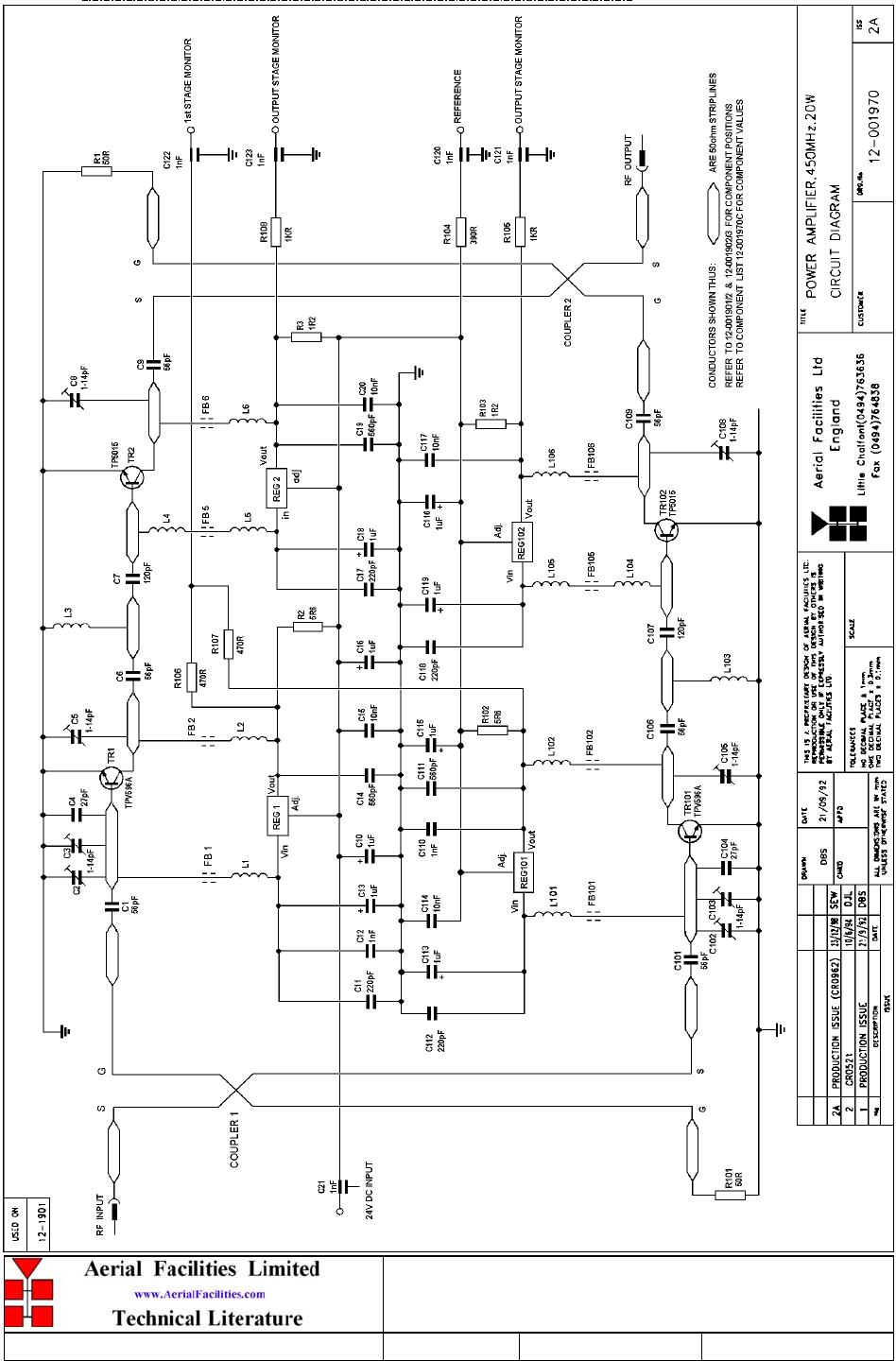
5-Way Channelised UHF Cell Enhancer
Maintenance Handbook
H/book Number:-50-060601HBKM Issue No:-1Date:-04/07/2003 Page:-29 of 54
5.1.6.4 Drg. N. 12-001970, 10W PA Circuit Diagram
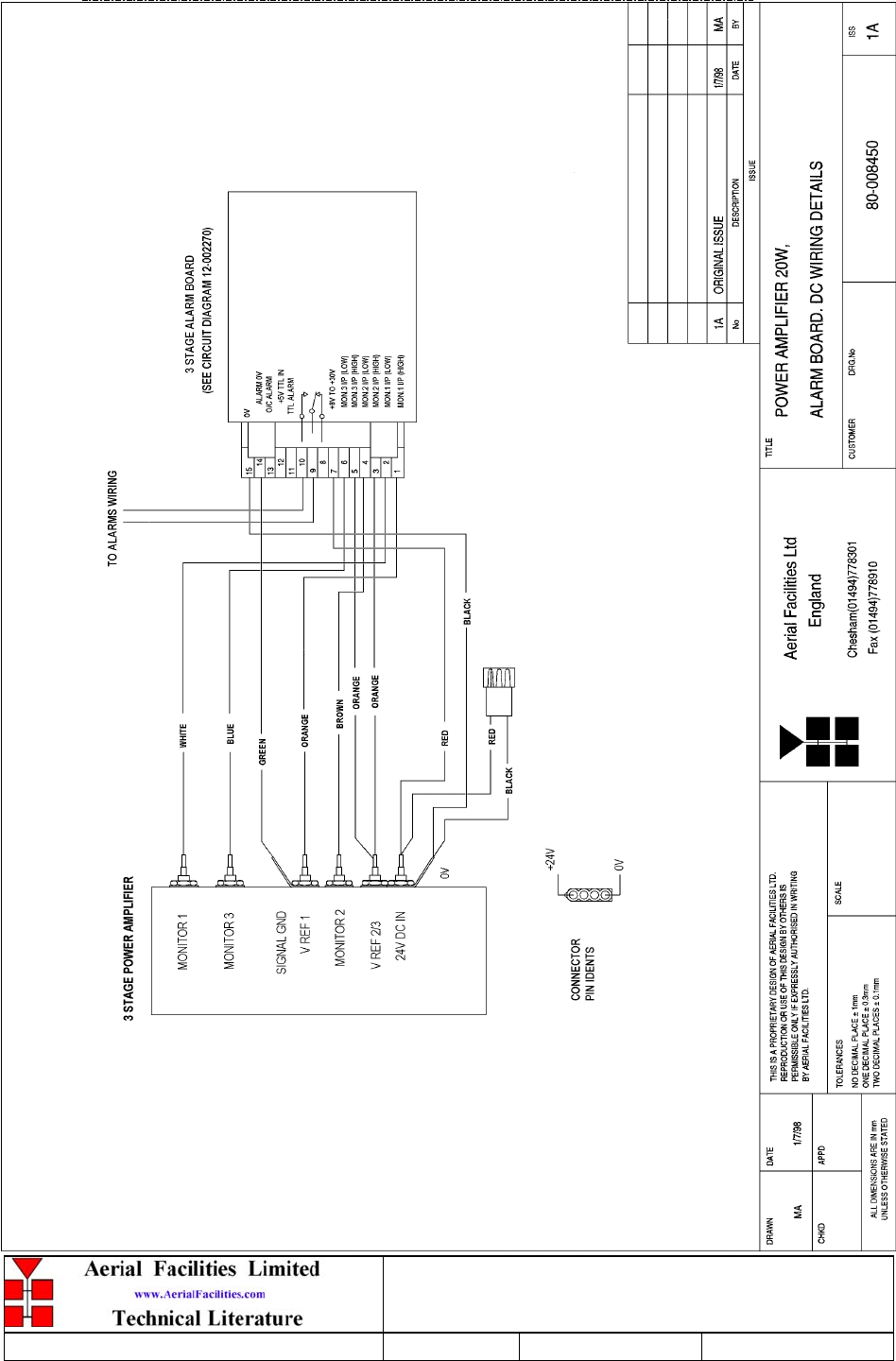
5-Way Channelised UHF Cell Enhancer
Maintenance Handbook
H/book Number:-50-060601HBKM Issue No:-1Date:-04/07/2003 Page:-30 of 54
5.1.6.5 Drg. N. 80-008450, PA to Alarm Board DC Wiring Details
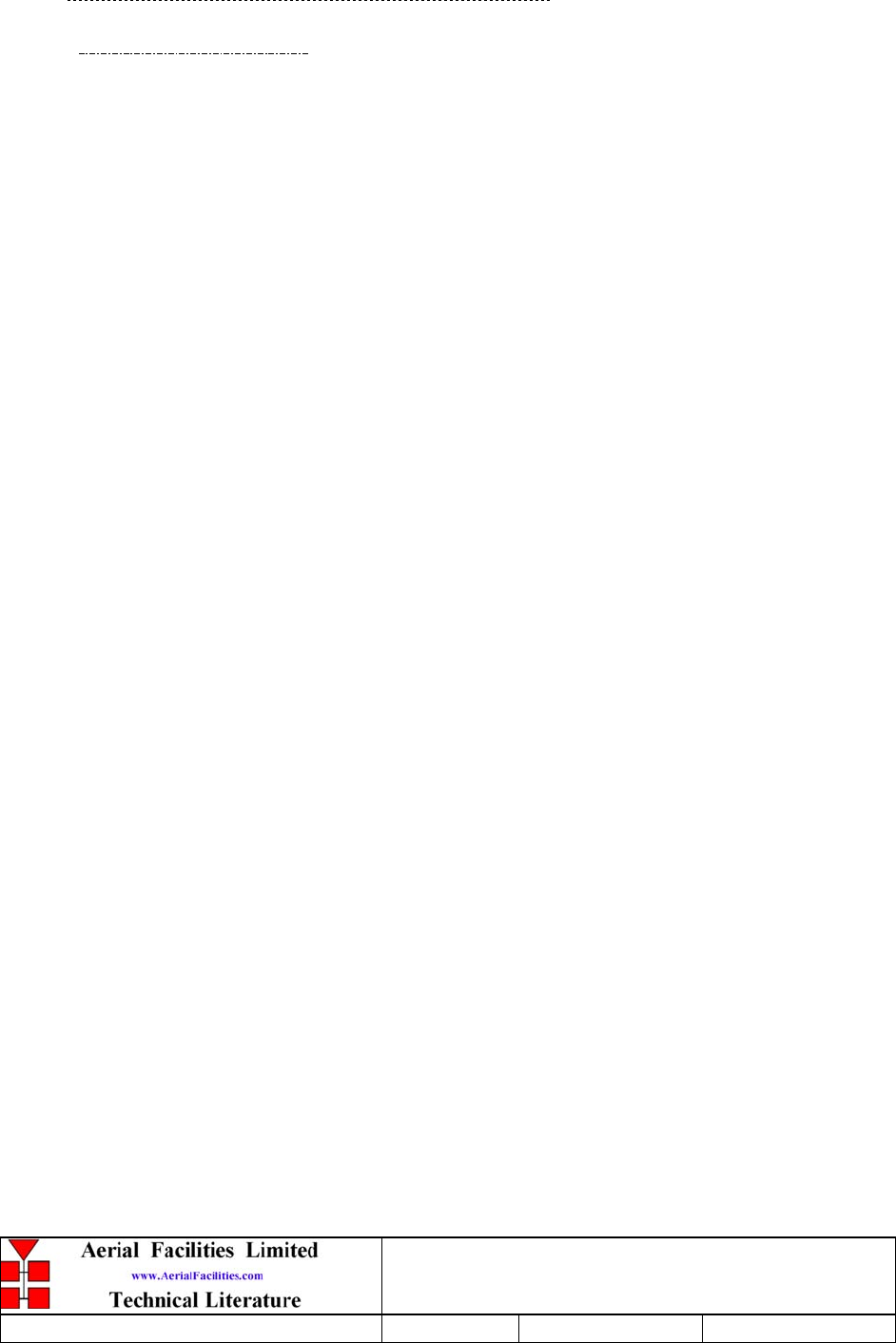
5-Way Channelised UHF Cell Enhancer
Maintenance Handbook
H/book Number:-50-060601HBKM Issue No:-1Date:-04/07/2003 Page:-31 of 54
5.1.7 3 Stage Amplifier Alarm Boards (12-002201)
5.1.7.1 Description
Amplifier Alarm Boards are fitted to monitor the bias conditions of AFL Class A
amplifiers which remain constant in normal operation. Any departure from normal bias
conditions is a result of device failure, excess temperature, over-driving or oscillation
(excessive power).
In normal operation, the Class A bias circuit of the amplifier develops a constant voltage
of 1.20V across the collector current setting resistor. The Amplifier Alarm Board is a
window comparator device, which is adjusted to sense a departure from this condition.
Several different alarm outputs are provided to simplify interfacing, (Relay Contact, Open
Collector, and TTL Logic Levels)
The basic version of the Alarm Board (12-002801) monitors a single amplifier stage. A
three-stage version (12-002201) is used on complex amplifiers where three separate
comparators have their outputs logically combined to a common output stage. Failure of
any one stage will activate the alarms.
Note that the alarm board has a green Light Emitting Diode located near to the centre of
the printed circuit board, which is illuminated on ‘Good’, and extinguished on ‘Alarm’. It
is therefore a simple matter to identify an active module failure, by searching for an
Alarm Board which has its green LED extinguished. A simple test of the alarm board is
possible by shorting across the monitor inputs, pins 1 and 2, 3 and 4 or across pins 5 and
6. This last monitor input is inactive if the board has been converted to a two way alarm
board. (Refer to relevant amplifier alarm wiring diagram.)
1) Volt-free change over relay contacts.
2) Open collector NPN transistor pulls low on alarm.
3) TTL driver.
The use of precision voltage sources and resistors has eliminated the need for initial
adjustment or calibration, and the board will function correctly with a wide variation in
power supply voltage (8 to 30 volts, nominal supply is 12 or 24Volts).
There are two selectable link options on the three-way board:
LINK1 - Removed to convert to two-way alarm board.
LINK2 - Removed to isolate 0V from chassis earth.
The one way alarm board only has the 0V isolation link (LINK2) fitted.
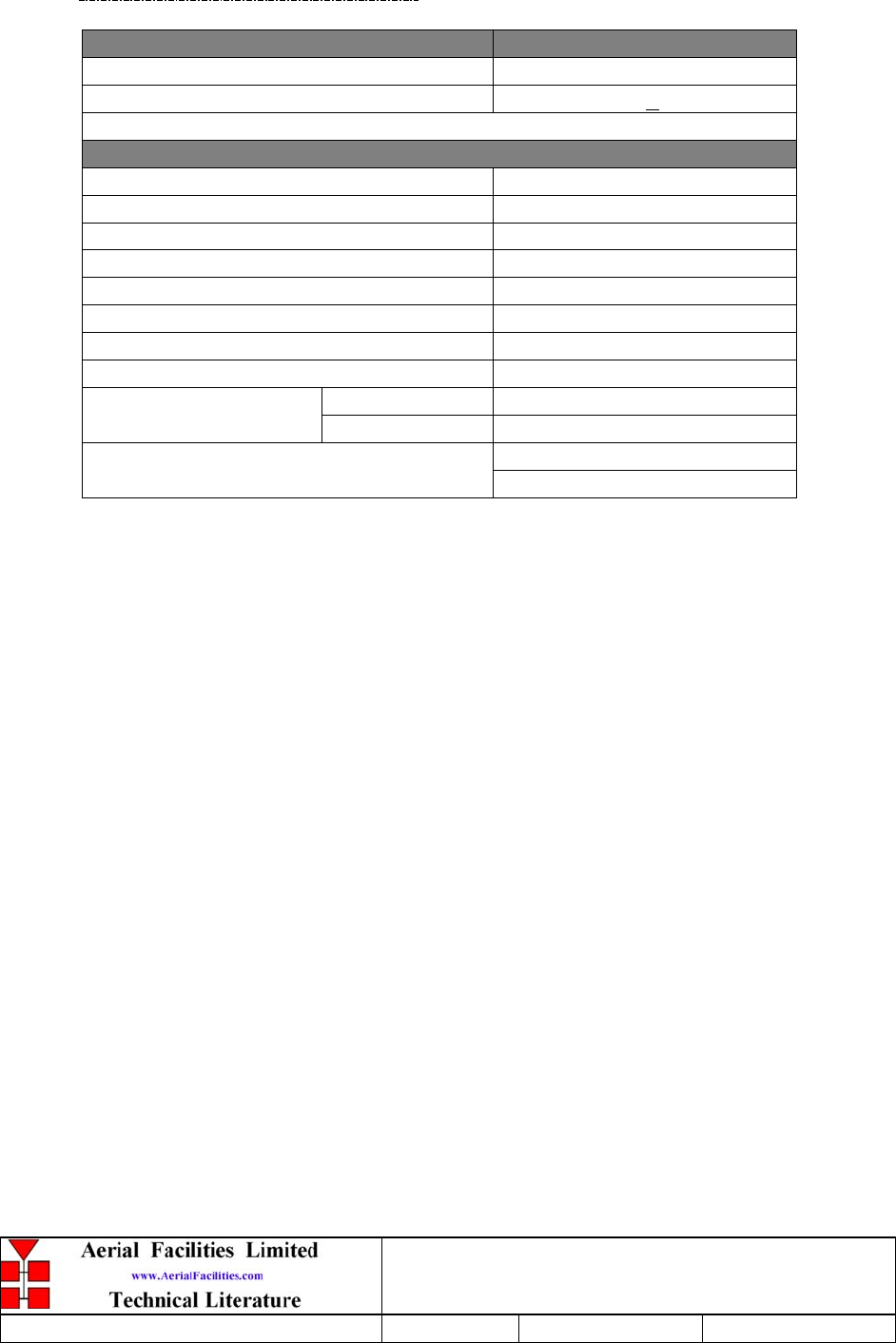
5-Way Channelised UHF Cell Enhancer
Maintenance Handbook
H/book Number:-50-060601HBKM Issue No:-1Date:-04/07/2003 Page:-32 of 54
5.1.7.2 Technical Specification
PARAMETER SPECIFICATION
Operating voltage: 8 to 30V (floating earth)
Alarm Threshold: Vcc - 1.20 volt +15%
Alarm output relay contacts:
Max. switch current: 1.0Amp
Max. switch volts: 120Vdc/60VA
Max. switch power: 24W/60VA
Min. switch load: 10.0µA/10.0mV
Relay isolation: 1.5kV
Mechanical life: >2x107 operations
Relay approval: BT type 56
Connector details: 15-way 0.1" pitch
operational: -10°C to +55°C
Temperature range: storage: -40°C to +70°C
74 x 56mm (3 stage)
PCB Size: 54 x 56mm (1 stage)
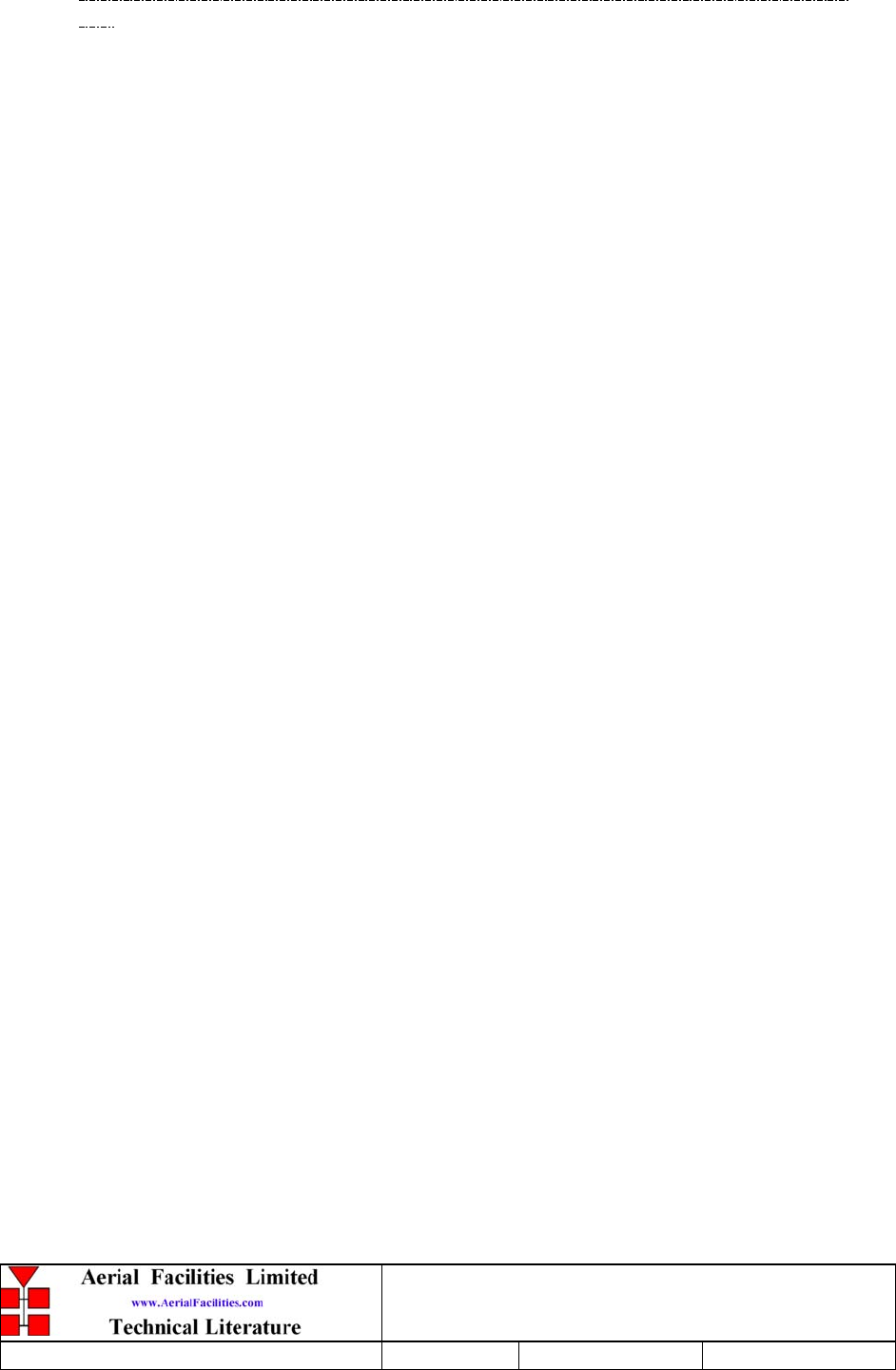
5-Way Channelised UHF Cell Enhancer
Maintenance Handbook
H/book Number:-50-060601HBKM Issue No:-1Date:-04/07/2003 Page:-33 of 54
5.1.7.3 Drg. N. 12-002201, 3 Stage Alarm Board Assembly Drawing & Parts
List
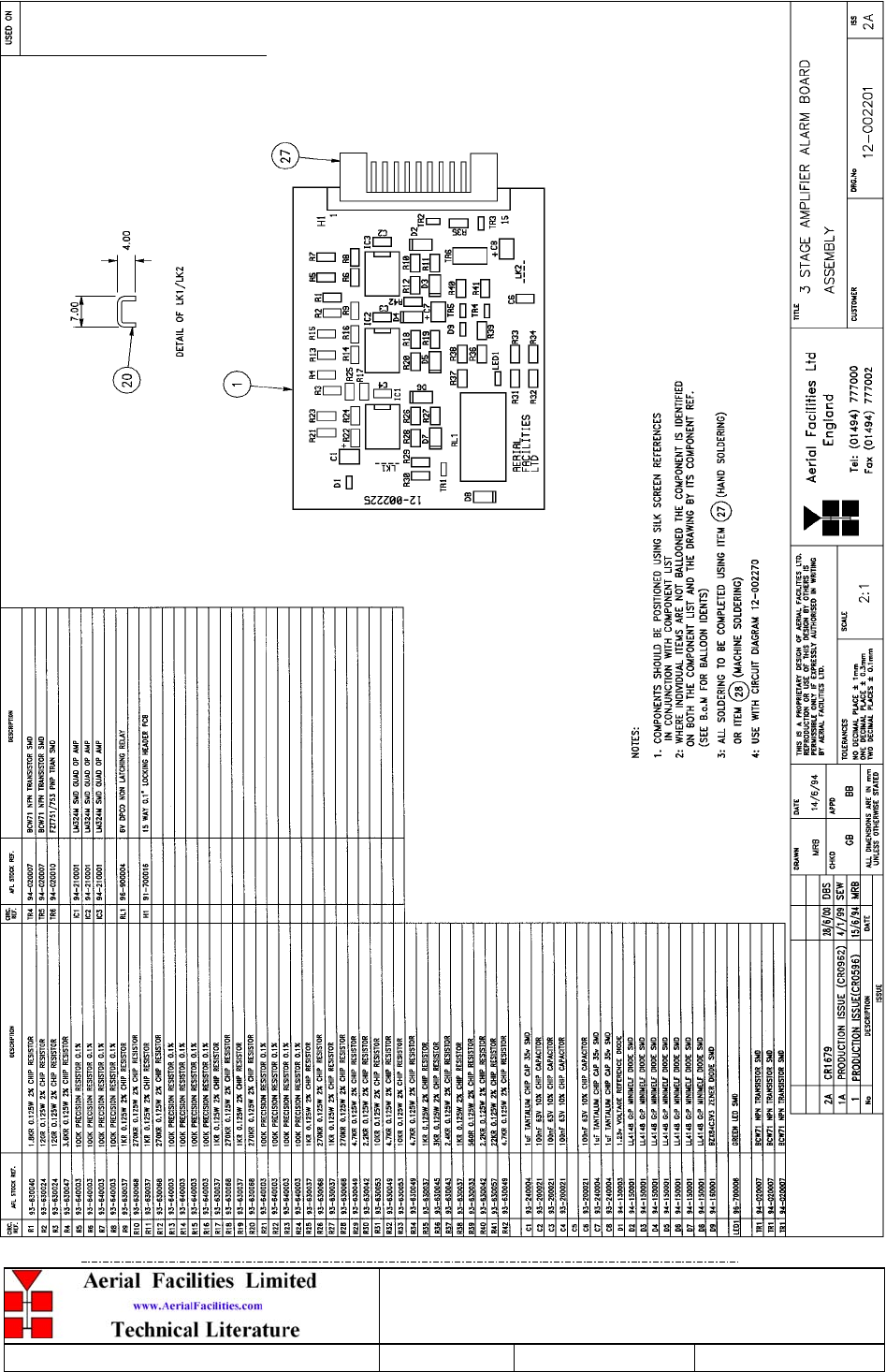
5-Way Channelised UHF Cell Enhancer
Maintenance Handbook
H/book Number:-50-060601HBKM Issue No:-1Date:-04/07/2003 Page:-34 of 54
5.1.7.4 Drg. N. 12-002270, 3 Stage Alarm Board Circuit Diagram
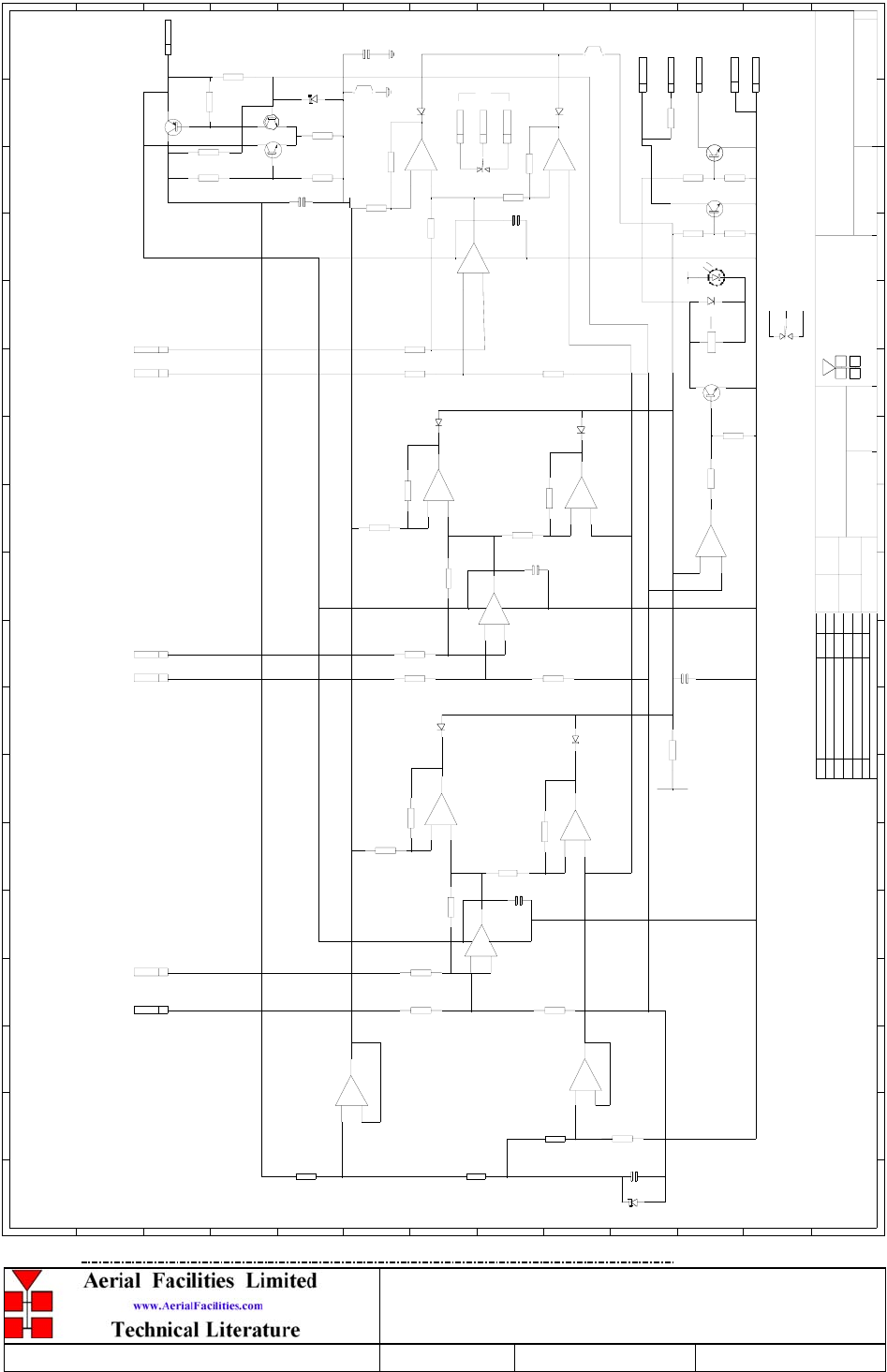
5-Way Channelised UHF Cell Enhancer
Maintenance Handbook
H/book Number:-50-060601HBKM Issue No:-1Date:-04/07/2003 Page:-35 of 54
3 STAGE AMPLIFIER ALARM BO ARD
CIRCUIT DIAG RAM
12-002270
1
N.T .S
M R B 11/ 8/ 93
BYDATEDESCRIP TIONNo
ISSUE
1234 5 678 9
10 11 12 13 14 15 16 17 18
A
B
C
D
E
F
G
H
I
J
K
L
M
A
B
C
D
E
F
G
H
I
J
K
L
1 2 3 4 5 6 7 8 9 101112 13 1415 16
17 18
M
UNLESS OTHERWISE STATED
ALL DIMENSIONS ARE IN mm
DRAWN
CHKD
CUSTOMER DRAWING No
PERMISSIBLE ONLY IF EXPRESSLY AUTHORISED IN WRITING
THIS IS A PROPRIETARY DESIGN OF AERIAL FACILITIES LTD.
NO DECIMAL P LA CE ± 1mm
TWO DECIMAL PLACES ± 0.1mm
ONE DECIMAL PLA CE ± 0.3mm
BY AERIAL FACILITIES LTD.
REPRODUCTI ON OR USE OF THIS DESIGN BY OTHERS IS
APPD
DATE
TOLE RANCES SCA LE
Tel : 01494 777000
Fax : 01494 777002
Ae ria l Fa cilitie s Lim ite d
Eng land
TI TLE
1
A
+
-
IC1
+
-
IC1
+
-
IC1
+
-
IC1
CONN11
TTL A LA R M
CONN
+5v TTL I N
12
CONN
0V
15
CONN
ALARM 0v
14
CONN
O/C ALARM
13
7
+8v TO +30v
CONN
1CONN
CONN2
CONN3
CONN4
CONN5
CONN6
MONITOR 1
INPUT
HI LOW HI
MONITOR 2
INPUT
LO W HI
MON I TOR 3
INPUT
LO W
9CONN
CONN10
CONN8
CONTACTS
ALARM
R1
1K 8
+
-
IC3
5
6
7
R2
120R
R3
120R
R4
3K 6
R6
100K
R5
100K
R7
100K
R9
1K
2
3
1
+
-
IC3
4
11
R11
1K
100K
R15
1K
R17
100K
R23
100K
R22
1K
R19
100K
R14
100K
R13
100K
R21
R25
1K
R27
1K
R37
2K 4
R39
560R
R26
270K
270K
R18
R24
100K
R28
270K
R20
270K
R16
100K
R10
270K
R8
100K
R12
270K
R42
4K 7
R29
4K 7
R35
1K
R40
2K 2
R41
22K
R38
1K
R36
3K
2K 2
R30
4K 7
R32
4K 7
R34
10K
R33
10K
R31
TR 3
BCW71BCW71
TR 2
BCW71
TR 1
6
5
7
+
-
IC2
10
9
8
+
-
IC3
3
2
4
11
1
12
13
14
+
-
IC3
+
-
IC2
12
13
14
10
9
8
3
2
4
1
11
+
-
IC2
+
-
IC2
5
6
7
10
9
8
12
13
14
D1
1. 23v
SR12D
+
C1
1uF
C2
100n
1u
C7
100n
C3
100n
C4
1. 0
C8
3v3
D9
TR 6
FZT751
TR 4
BCW71 BCW71
TR 4
100n
C6
LK 2
D7
D6
LK 1
D4
D5
D2
D3
D8
LE D 1
REL
-
RL1
+
OP AMP
6
7
RL1/2
8
+7. 5v
+7. 5v
2
+7. 5v +7. 5v
VCC VCC
0v 0v
CR0508 14/1/94 MRB
I C 1 , I C 2 & I C 3 = LM 324A M
A LL D I O D E S = LL4148 U N LE S S M A R K E D O TH E R W I S E
4
RL2/2 3
2
NOT USED
VCC
PRODUCTION ISSUE 11/ 9/93 MRB
PRODUCTION ISSUE 29/8/00 MNR
2
2A
0v
RB RB
5.1.7.5 Generic Rack Shelf Enclosure Alarm Wiring Sketch
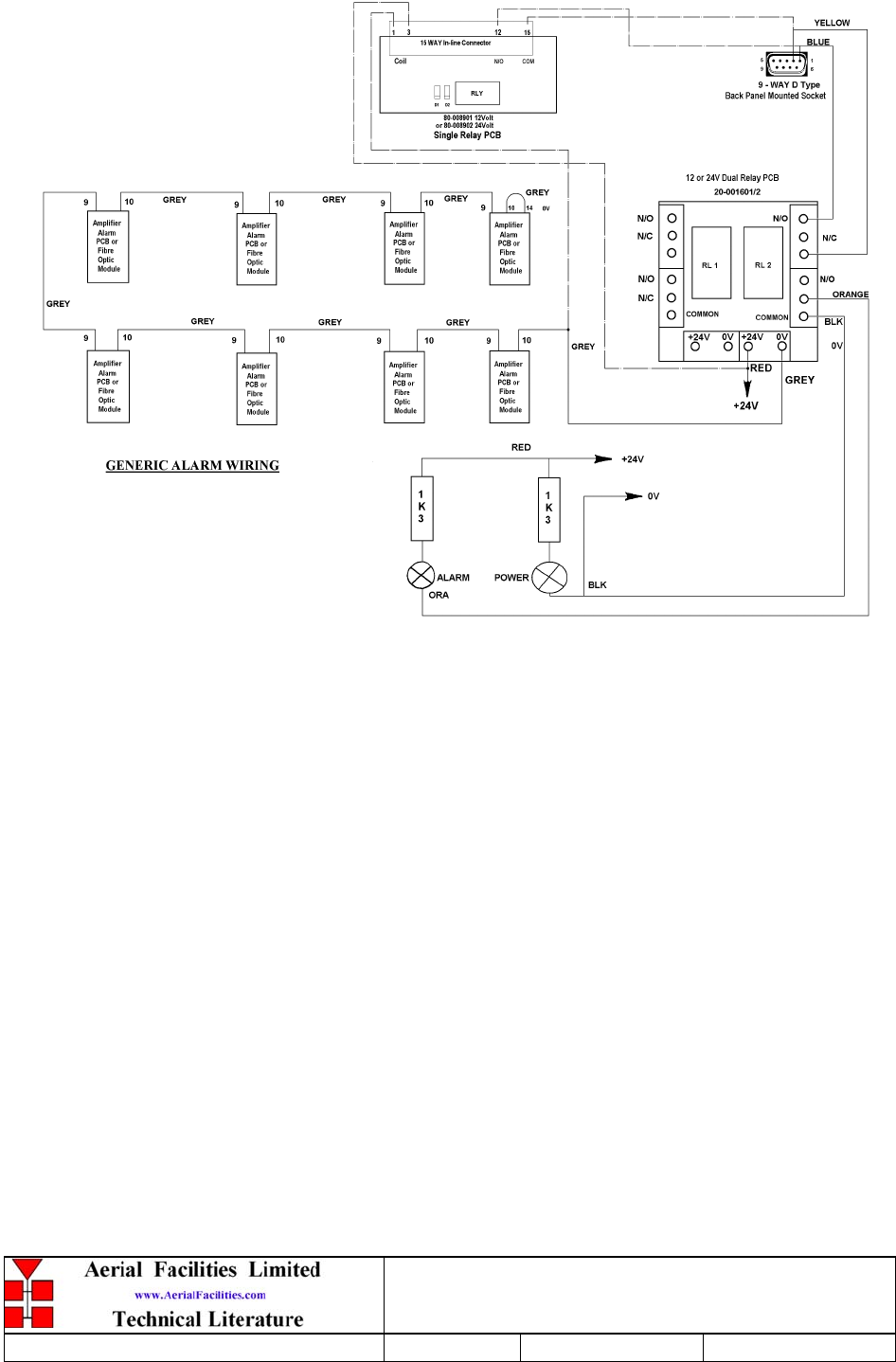
5-Way Channelised UHF Cell Enhancer
Maintenance Handbook
H/book Number:-50-060601HBKM Issue No:-1Date:-04/07/2003 Page:-36 of 54
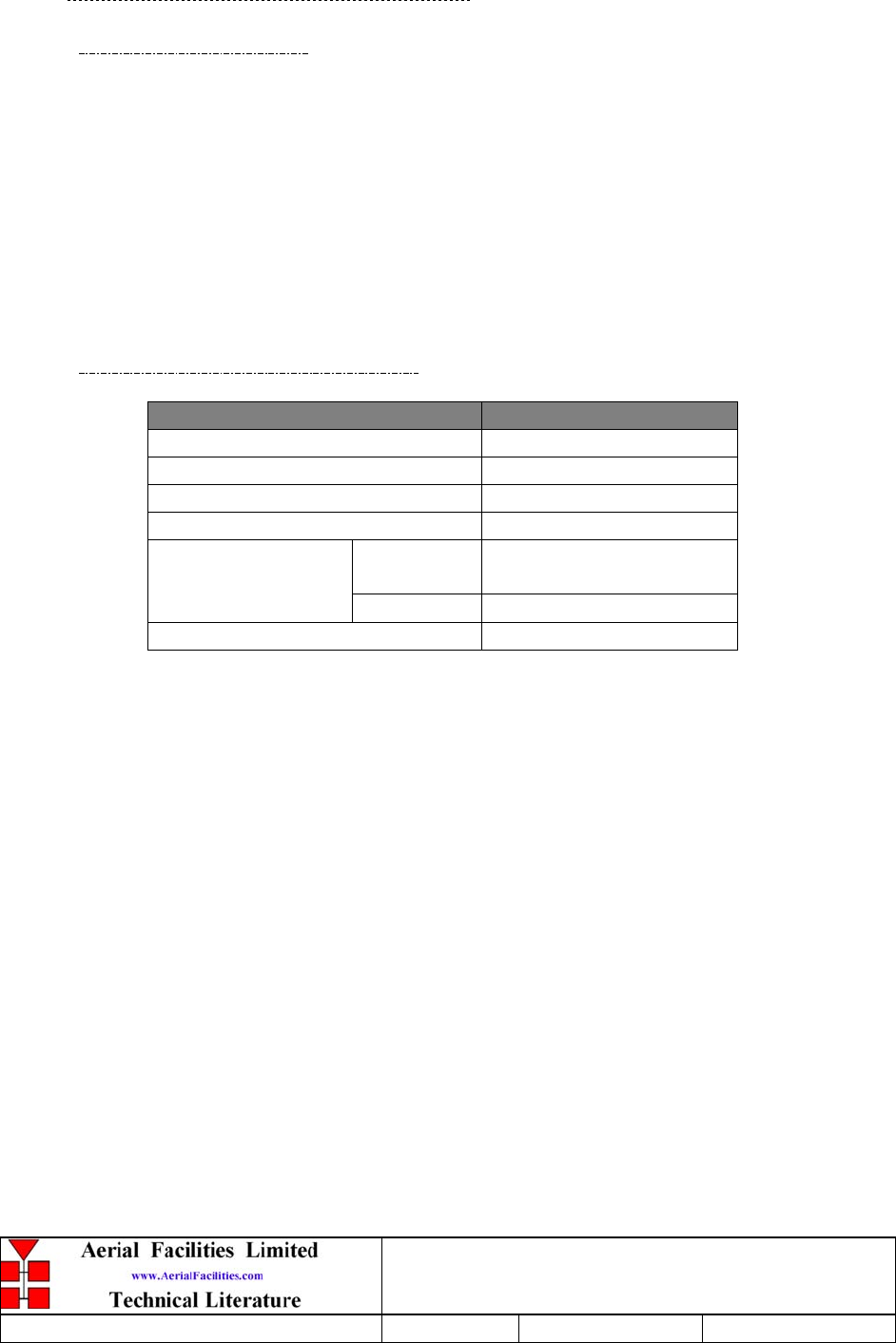
5-Way Channelised UHF Cell Enhancer
Maintenance Handbook
H/book Number:-50-060601HBKM Issue No:-1Date:-04/07/2003 Page:-37 of 54
5.1.8 Dual DC/DC Converter (13-001803)
5.1.8.1 Description
This unit is employed where it is necessary to derive two fixed voltage power supply rails
from some higher voltage. Typically it is used to derive 5, 8, 12 or 15V from a 24V input.
The circuit is based upon a pair of LM257 series variable voltage regulators (LM2576, 12
& 15V & LM2575, 5V), which are each capable of supplying an absolute maximum of
1.5A output current. Note that at full output current, the dissipation of the device must
remain within design limits, bearing in mind the voltage which is being dropped across it.
The maximum allowable dissipation will also depend on the efficiency of the heatsink on
which the device is mounted.
5.1.8.2 Technical Specification
PARAMETER SPECIFICATION
Operating Voltage: 21 – 27V DC
Output Voltages: 12.0V & 12.0V (typical)
Output Current: 1.0A (maximum per o/p)
Connections: Screw Terminal Block
operational
:
-10ΒC to +55ΒC
Temperature range:
storage: -40ΒC to +70ΒC
PCB Size: 85 x 63mm
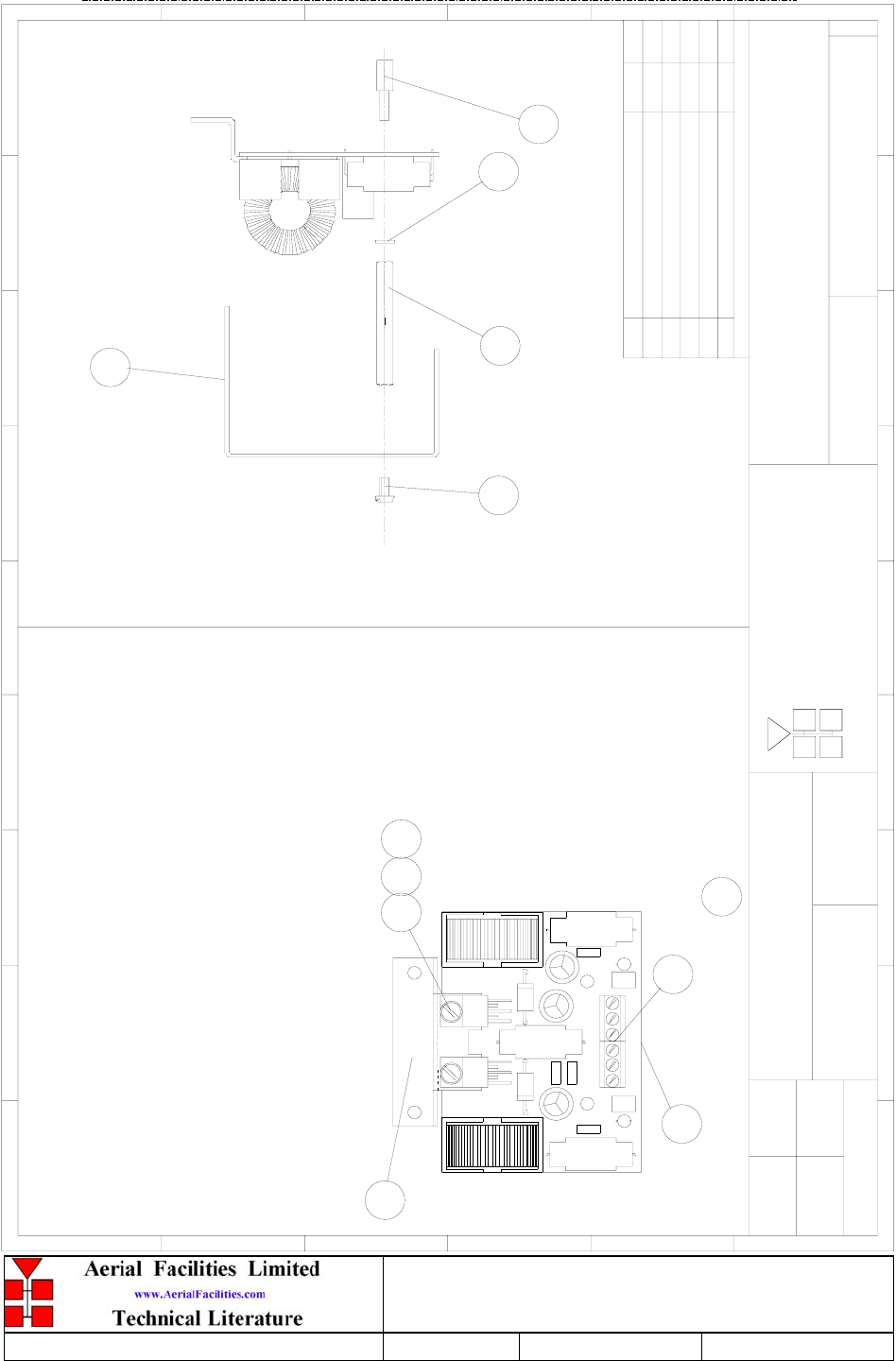
5-Way Channelised UHF Cell Enhancer
Maintenance Handbook
H/book Number:-50-060601HBKM Issue No:-1Date:-04/07/2003 Page:-38 of 54
5.1.8.3 Drg. N. 13-001803, Dual DC/DC Converter Assembly Drawing
DUAL DC-DC CONVERTER(24V-12V/12V)
PCB SUB-ASSEMBLY
13-001803
1A
1:1
MNR 07/03/02
3
IN 2 PLACES
1
2
4 6 5
IN 2 PLACES
8
10
9
6
7
BYDAT EDESCRIPTIO NNo
ISSUE
1 2345678 9
A
B
C
D
E
F
1 2345678 9
A
B
C
D
E
F
Fax : 01494 777002
Tel : 01494 777000
Aerial Facilities Limited
THIS IS A PROPRIETARY DESIG N OF AERIAL FACILITIES LTD.
REPRO DUCTIO N O R USE O F T HIS DESIG N BY OT HERS IS
PERMISSIBLE ONLY IF EXPRESSLY AUTHORISED IN WRITING
BY AERIAL FACILITIES LTD.
NO DECIM AL PL ACE ± 1 mm
ONE DECIMAL PLACE ± 0 .3mm
TWO DECIMAL PL ACES ± 0.1mm
AL L DIM ENSIO NS ARE IN mm
UNL ESS OTHERWISE STATED
CHKD
DRAWN
APPD
DAT E
T OL ERANCES SCA L E
England
CUSTO MER DRAWING.No
TITL E
3
A
PRODUCTION ISSUE MNR
07/03/02
+
C1
+
L3
0v+15v
C1 0C7
C4
+24v0v 0v
L4
C5
C8
D1
k
+
C9
C6
+5v
C1 1
L5
+
C2
C3
D2 k
+
IC2IC1
L1
1515
L2
ALL SOLDER JOINTS TO BE MADE USING 16 .
STAGE 1
STAGE 2
IN 2 PLACES IN 2 PLACES IN 2 PLACES
IN 2 PLACES
GB BB
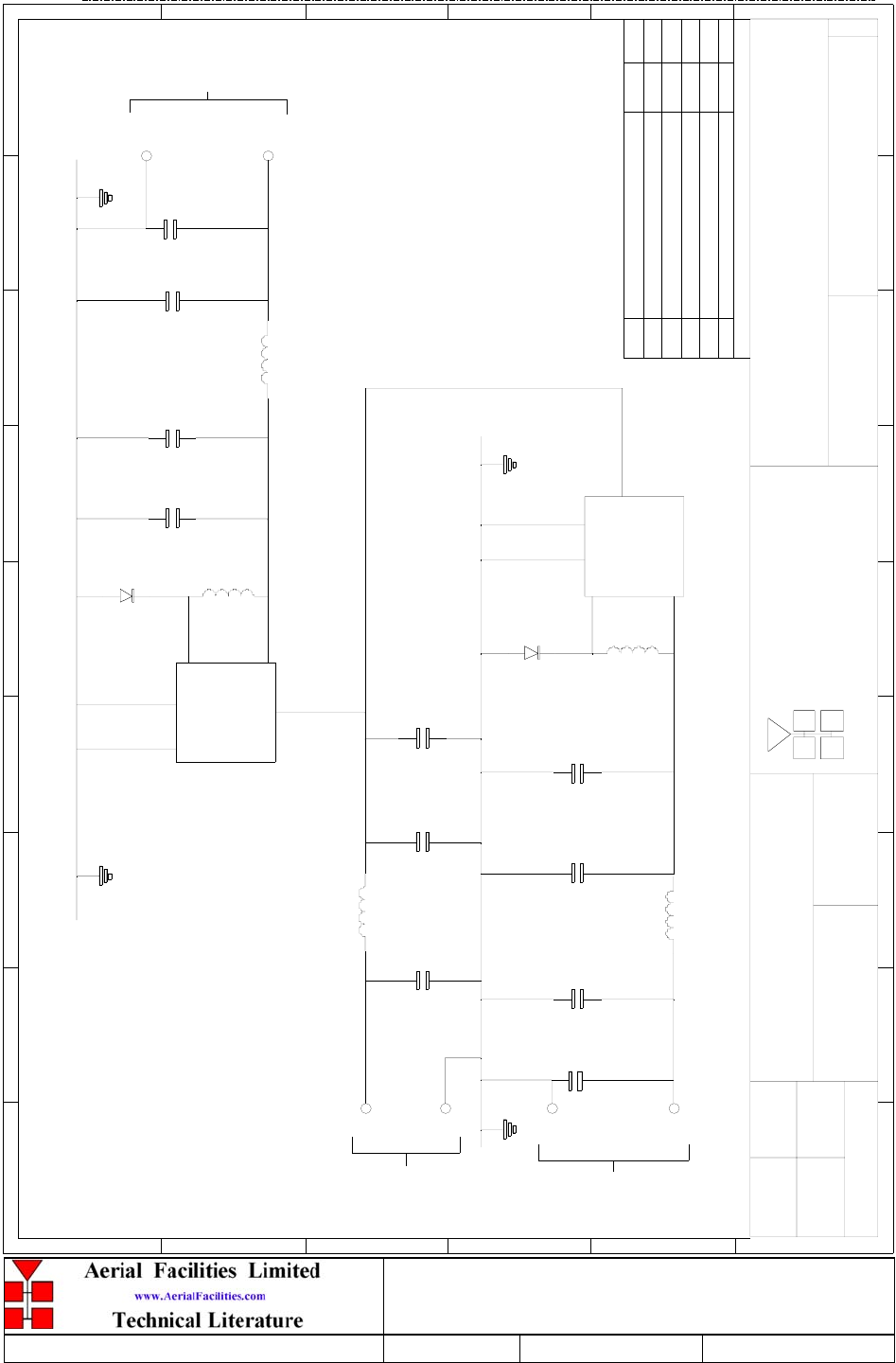
5-Way Channelised UHF Cell Enhancer
Maintenance Handbook
H/book Number:-50-060601HBKM Issue No:-1Date:-04/07/2003 Page:-39 of 54
5.1.8.4 Drg. N. 13-001872, Dual DC/DC Converter Circuit Diagram (12V/12V)
C3
L5
C2
C1
L3
C4
L1
L2
C6
L4
C8 C5
D2
D1
C11
C10
C7
C9
DUAL DC-DC CONVERTOR (24V-12V/12V)
CIRCUIT DIAGRAM
13-001872
1A
N.T.S
MNR 11/03/02
1
2
4
35
2
4
5
1
3
0V
+12V
OUTPUT
(1 Amp)
0V
+12V
+24V
0V
OUTP U T
INPUT
IC1
LM2576T12
IC2
LM2576T12
UF5400
330uH
470uF 100nF
UF5400
470uF
100uF
USE IN CONJUNCTION WITH ASSEMBLY DRAWING 13-001803
Vin
O/P
O n /O ffGnd
F/Bk
Gnd On/Off
Vin
F/Bk
O/P
+
+
+
100u
330uH
100nF
100uH
100uH
100nF 100nF
0.47uF
0.47uF
+
2.2uF
2.2uF
+
BYDATEDESCRIPTIONNo
ISSUE
1 234 5 678 9
A
B
C
D
E
F
123
456789
A
B
C
D
E
F
Fax : 01494 777002
Tel : 01494 777000
Aerial Facilities Limited
THIS IS A PROPRIETARY DESIGN OF AERIAL FACILITIES LTD.
REPRODUCTIO N O R USE O F THIS DESIGN BY O THERS IS
PERMISSIBLE ONLY IF EXPRESSLY AUTHORISED IN WRITING
BY AERIAL FACIL IT IES L TD.
NO DECIMAL PL ACE ± 1 m m
ONE DECIMAL PLACE ± 0.3mm
TWO DECIMAL PL ACES ± 0 .1 m m
AL L DIMENSIO NS ARE IN mm
UNLESS O THERWISE STATED
CHKD
DRAWN
APPD
DAT E
T OL ERANCES SCAL E
England
CUSTO M ER DRAWING.No
TITLE
3
A
PRODUCTION ISSUE
11/03/02
MNR
12V
12V
ECN2581 MNR
28/06/02
2A
CH BB
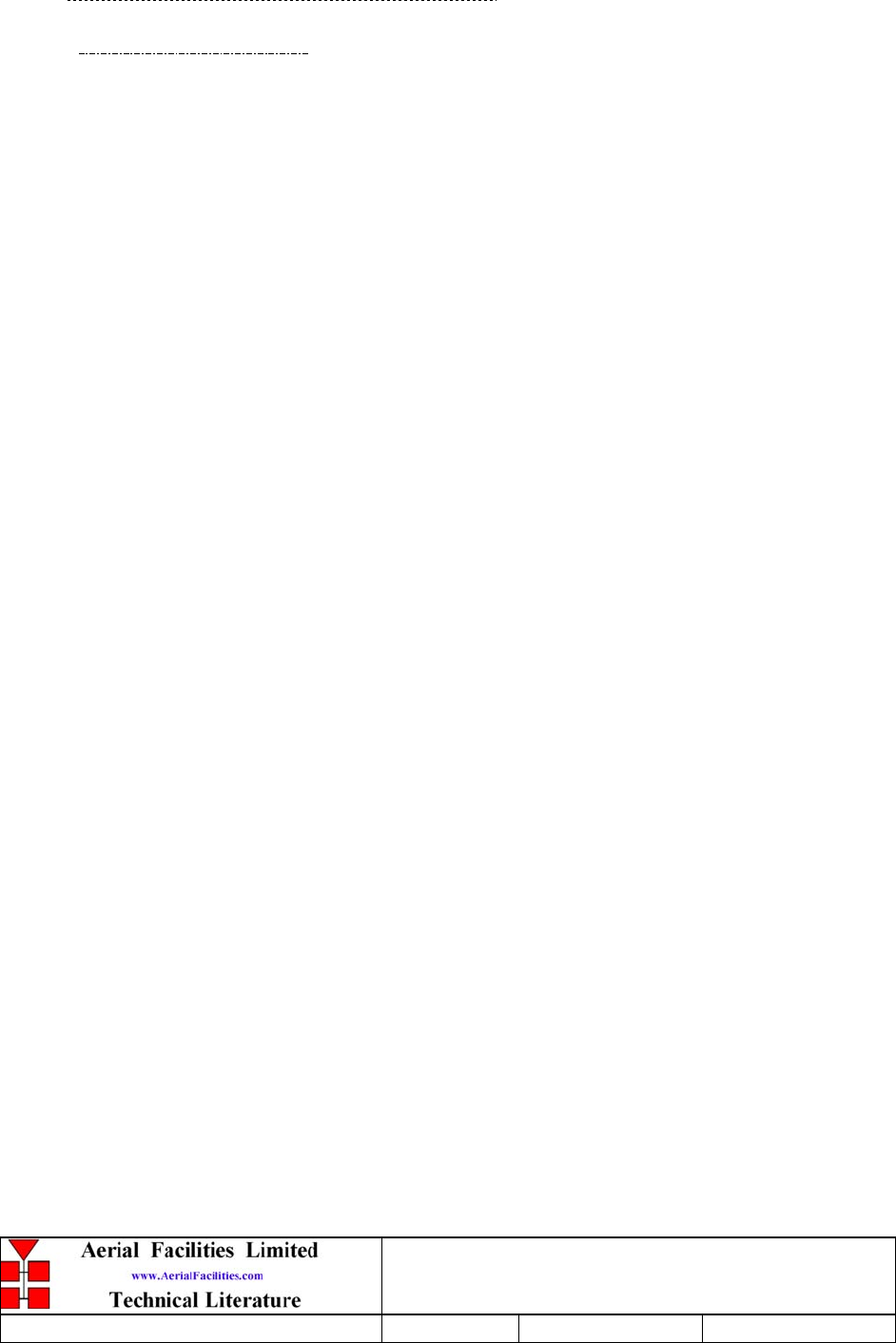
5-Way Channelised UHF Cell Enhancer
Maintenance Handbook
H/book Number:-50-060601HBKM Issue No:-1Date:-04/07/2003 Page:-40 of 54
5.1.9 Channel Selective Module (17-003012)
5.1.9.1 Description
The channel selectivity module is employed when the Cell Enhancer requirement dictates
that very narrow bandwidths (single operating channels), must be selected from within
the operating passband. One channel selectivity module is required for each channel.
The Channel Selectivity Module is an Up/Down frequency converter that mixes the
incoming channel frequency with a synthesised local oscillator, so that it is down-
converted to an Intermediate Frequency (IF) in the upper HF range. An eight pole crystal
filter in the IF amplifier provides the required selectivity to define the operating passband
of the Cell Enhancer to a single PMR channel. The same local oscillator then converts the
selected IF signal back to the channel frequency.
Selectivity is obtained from a fixed bandwidth block filter operating at an intermediate
frequency (IF) in the low VHF range. This filter may be internal to the channel selectivity
module (Crystal or SAW filter) or an externally mounted bandpass filter, (LC or Helical
Resonator). Various IF bandwidths can therefore be accommodated. A synthesized Local
Oscillator is employed in conjunction with high performance frequency mixers, to
translate between the signal frequency and IF.
The operating frequency of each channel selectivity module is set by the programming of
channel selectivity module frequencies and is achieved digitally, via hard wired links,
banks of DIP switches, or via an onboard RS232 control module, providing the ability to
remotely set channel frequencies.
Automatic Level Control (ALC) is provided within each channel selectivity module such
that the output level is held constant for high level input signals. This feature prevents
saturation of the output mixer and of the associated amplifiers.
Alarms within the module inhibit the channel if the synthesised frequency is not locked.
The synthesiser will not usually go out of lock unless a frequency far out of band is
programmed.
The channel selectivity module is extremely complex and, with the exception of channel
frequency programming within the design bandwidth, it cannot be adjusted or repaired
without extensive laboratory facilities and the necessary specialised personnel. If a fault
is suspected with any channel selectivity module it should be tested by substitution and
the complete, suspect module should then be returned to AFL for investigation.
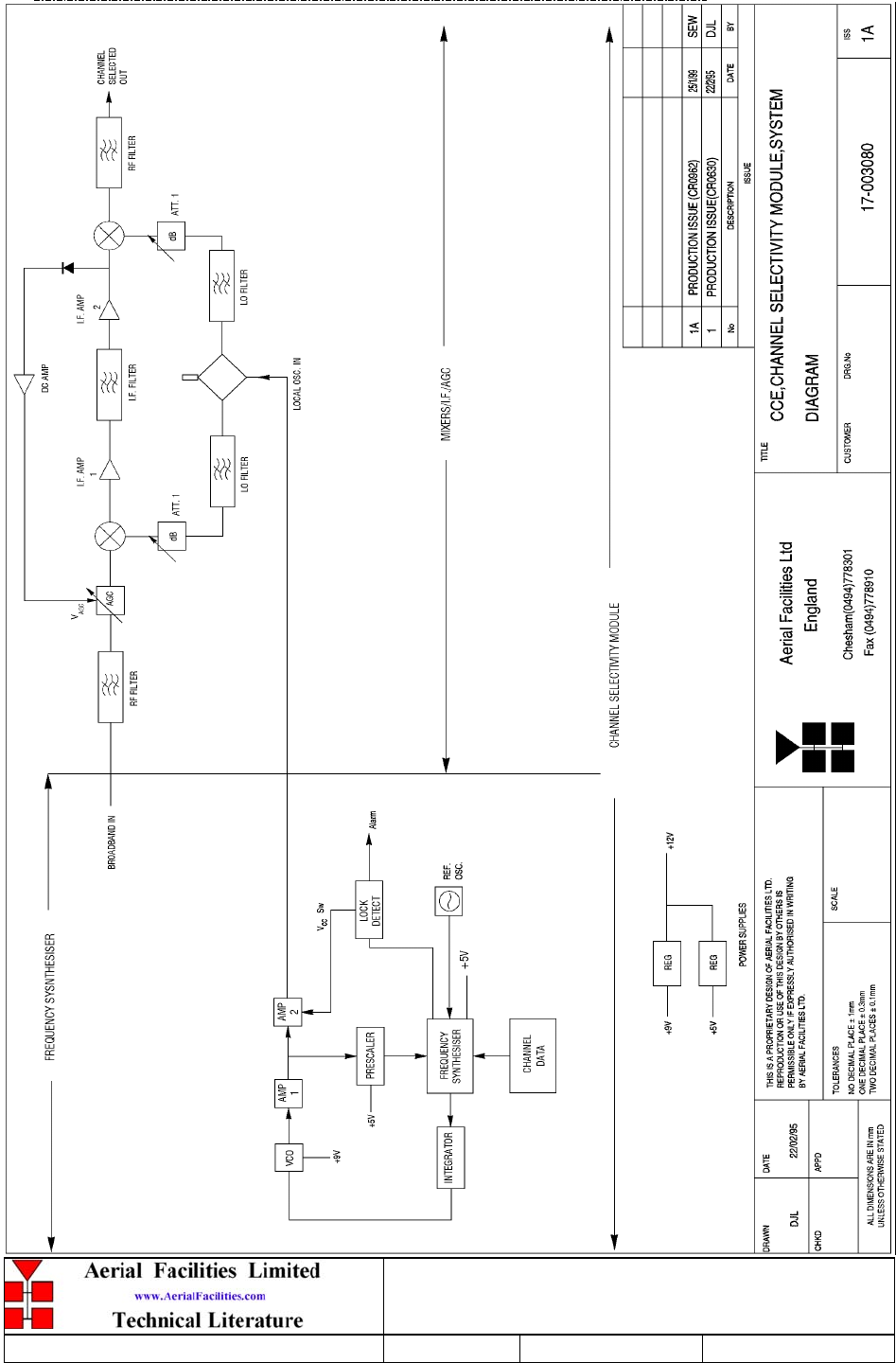
5-Way Channelised UHF Cell Enhancer
Maintenance Handbook
H/book Number:-50-060601HBKM Issue No:-1Date:-04/07/2003 Page:-41 of 54
5.1.9.2 Drg. N. 17-003080, Generic Channel Module Block Diagram
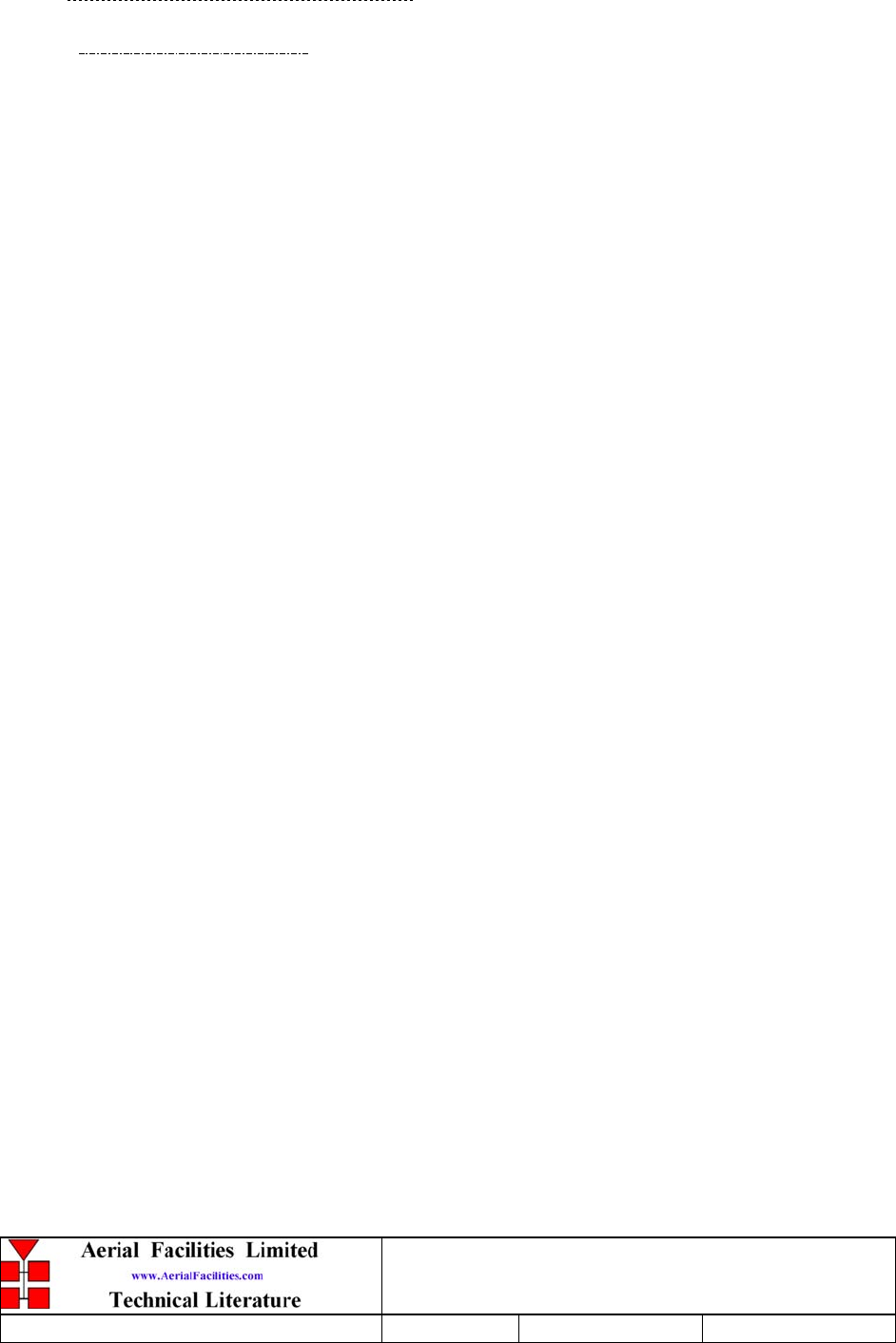
5-Way Channelised UHF Cell Enhancer
Maintenance Handbook
H/book Number:-50-060601HBKM Issue No:-1Date:-04/07/2003 Page:-42 of 54
5.1.10 24V Relay Board (20-001602)
5.1.10.1 Description
The General Purpose Relay Board allows the inversion of signals and the isolation of
circuits. It is equipped with two dual pole change-over relays RL1 and RL2, with
completely isolated wiring, accessed via screw terminals.
Both relays are provided with polarity protection diodes and diodes for suppressing the
transients caused by "flywheel effect" which can destroy switching transistors or induce
spikes on neighbouring circuits. It’s common use is to amalgamate all the alarm signals into
one, volts-free relay contact pair for the main alarm system.
Note that the board is available for different voltages (12 or 24V) depending on the type of
relays fitted at RL1 and RL2.
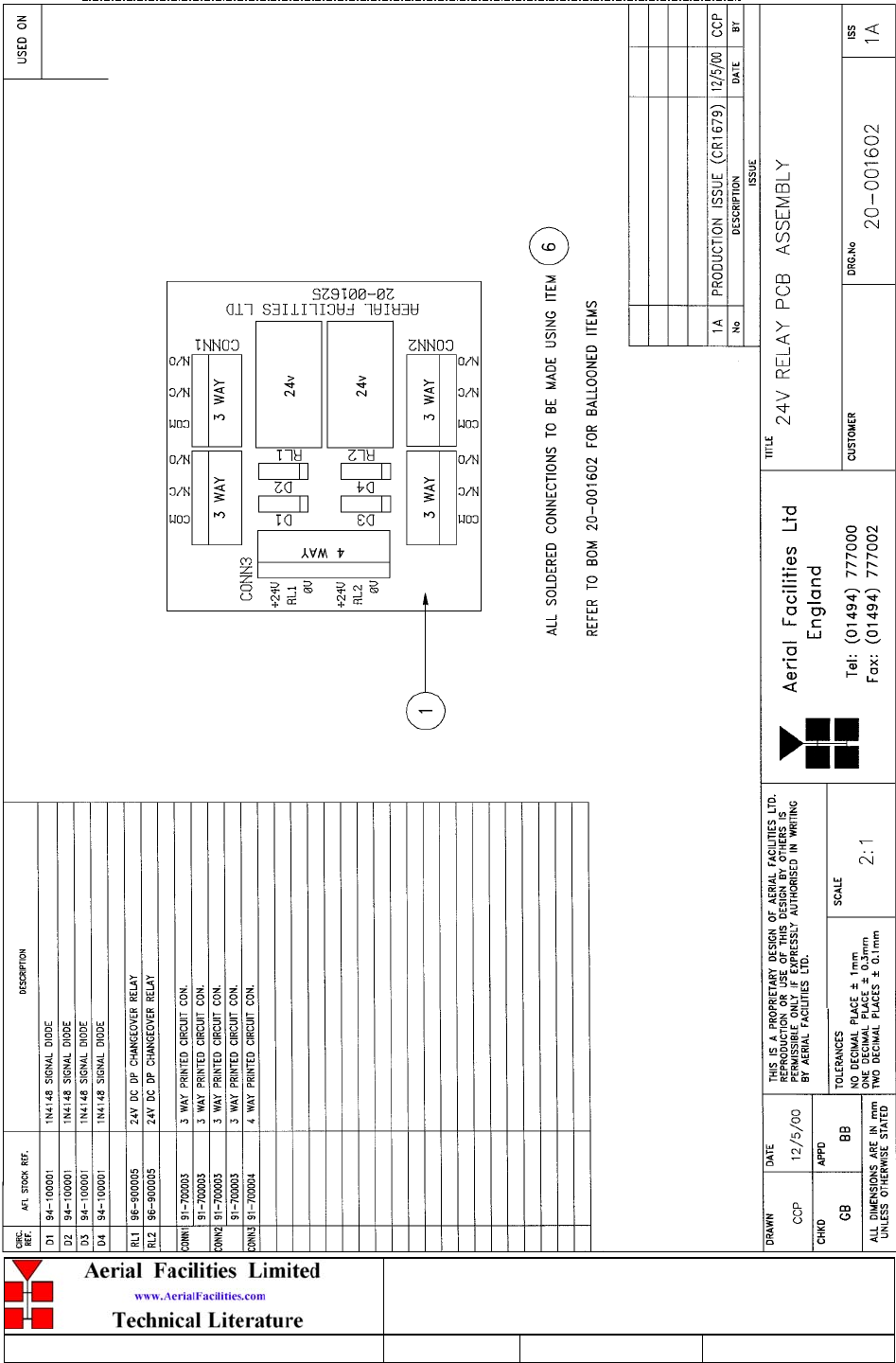
5-Way Channelised UHF Cell Enhancer
Maintenance Handbook
H/book Number:-50-060601HBKM Issue No:-1Date:-04/07/2003 Page:-43 of 54
5.1.10.2 Drg. N. 20-001602, 24V Relay Board Assembly Drawing
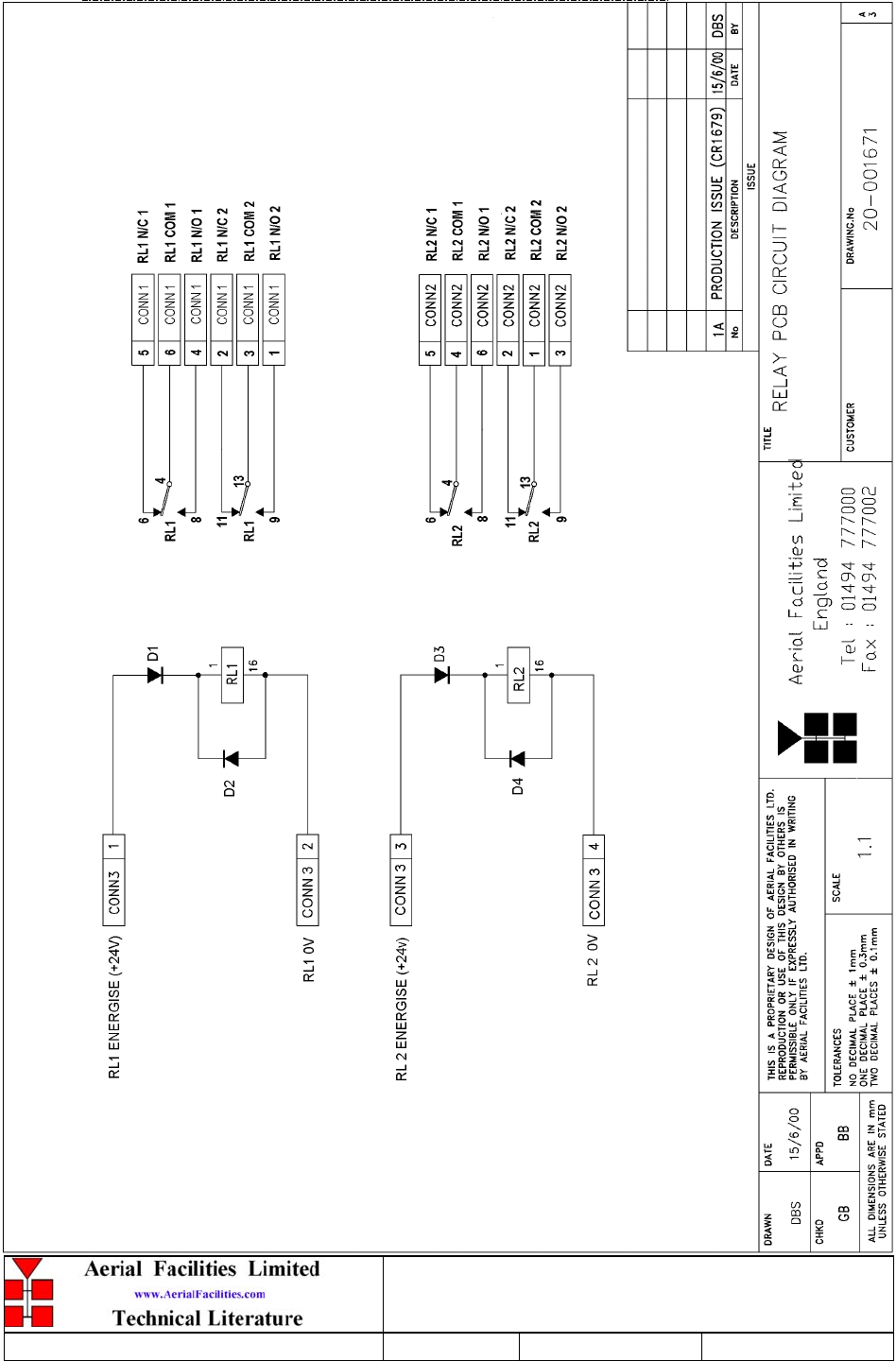
5-Way Channelised UHF Cell Enhancer
Maintenance Handbook
H/book Number:-50-060601HBKM Issue No:-1Date:-04/07/2003 Page:-44 of 54
5.1.10.3 Drg. N. 20-001671, Relay Board Circuit Diagram
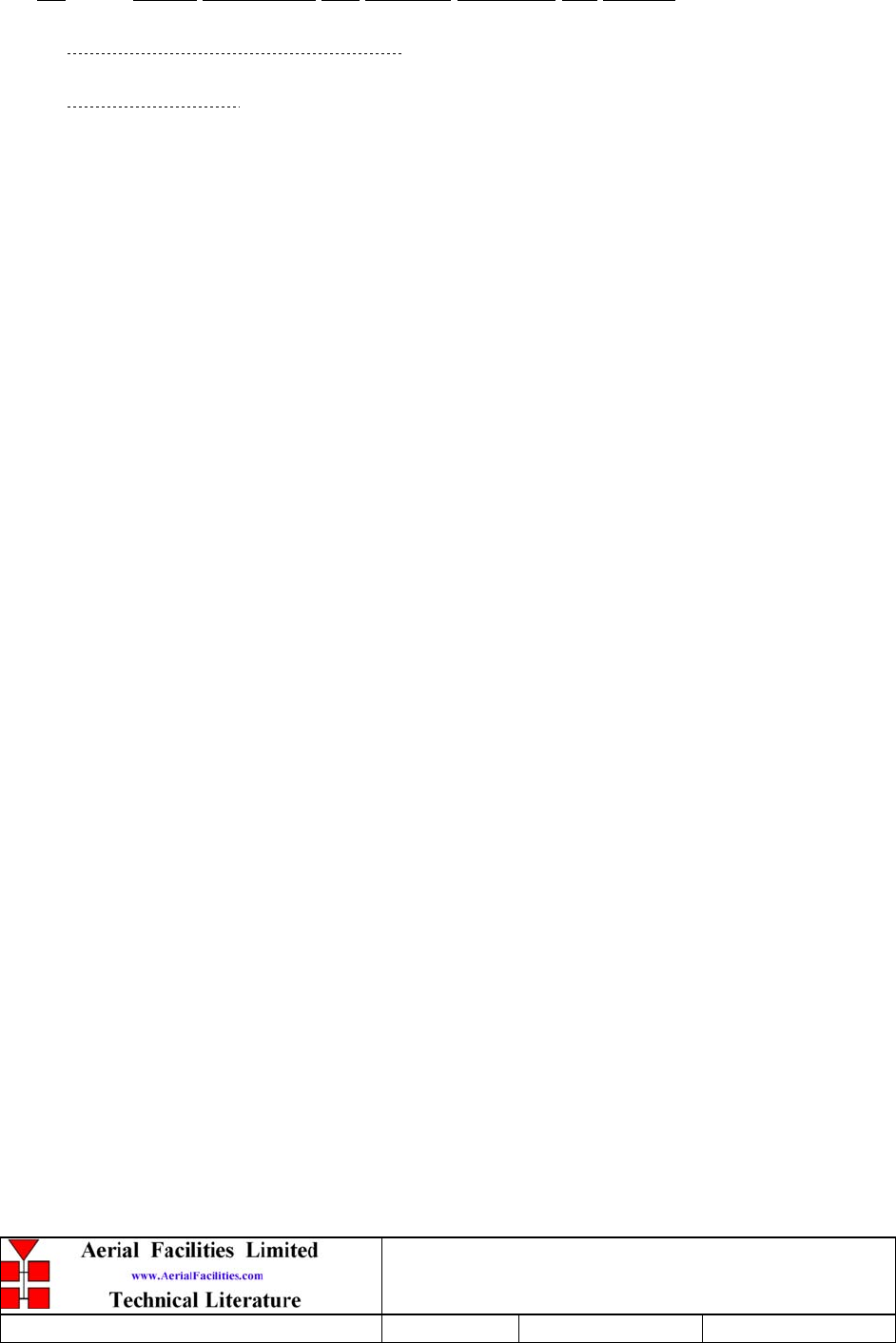
5-Way Channelised UHF Cell Enhancer
Maintenance Handbook
H/book Number:-50-060601HBKM Issue No:-1Date:-04/07/2003 Page:-45 of 54
5.2 Uplink Channelised Cell Enhancer 50-060603 (5U chassis)
5.2.1 DC Tap Module (21-001701)
5.7.1 Description
DC taps are used where it is necessary to inject a DC source ‘through’ an RF signal path
so that equipment in a remote location may be sourced with DC power (where it may be
impractical to have mains power). Where used, it will always be that one DC tap module
is used at each ‘end’ of the DC source, one to supply the DC onto the RF signal, and one
to remove it at its ultimate destination. The modules are designed for minimum insertion
loss (and minimum DC volt-drop) at the operating frequency. They are purely passive
devices, and should need no maintenance over their operating lifetime.
All other modules in this shelf have been described in the downlink Cell Enhancer
section 5.1.
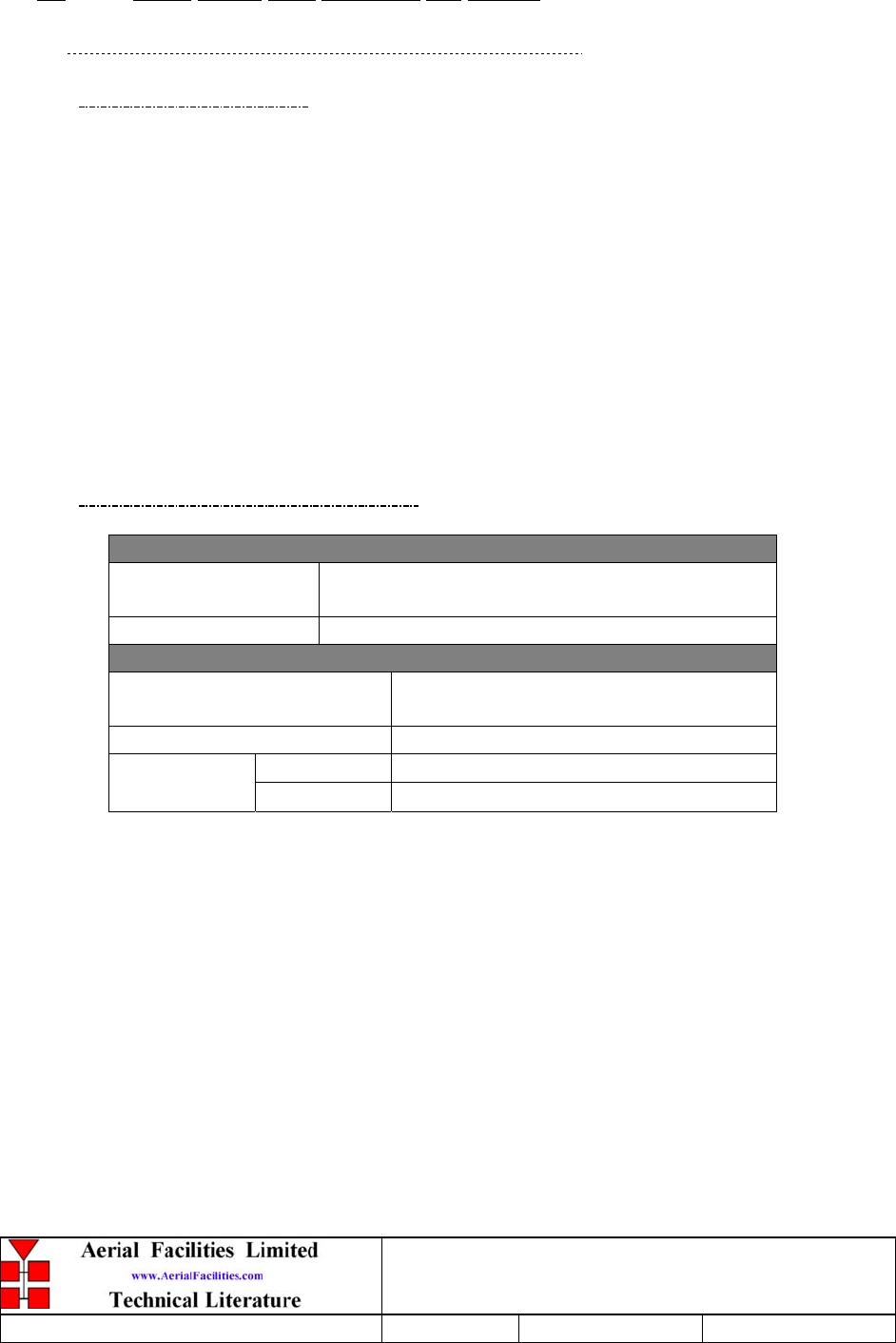
5-Way Channelised UHF Cell Enhancer
Maintenance Handbook
H/book Number:-50-060601HBKM Issue No:-1Date:-04/07/2003 Page:-46 of 54
5.3 Power Supply Shelf 50-060604 (4U chassis)
5.3.1 24V 410W Flat-Pack Power Supply (96-300054)
5.3.1.1 Description
The power supply unit is a switched-mode type capable of supplying 24V DC at 17.0Amps
continuously. Equipment of this type typically requires approximately 5-7.0 Amps at 24V
DC, so the PSU will be used conservatively ensuring a long operational lifetime.
No routine maintenance of the PSU is required. If a fault is suspected, then the output
voltage from the power supply may be measured on its output terminals. This is typically set
to 24.5V.
All the PSU’s used in AFL Cell Enhancers are capable of operation from either 110 or 220V
nominal AC supplies. The line voltage is sensed automatically, so no adjustment or link
setting is needed by the operator. The PSU modules are O.E.M devices and therefore no
drawings are available.
5.3.1.2 Technical Specification
AC Input Supply:
Voltage: 110 or 220V nominal - 90 to 132 or 180 to
264V (single phase, absolute limits)
Frequency: 47 to 63Hz
DC Output Supply:
Voltage: 24V DC (nominal), 22 to 26V
(absolute limits)
Current: 17.0A
operational: -10ΒC to +55ΒC
Temperature
range: storage: -40ΒC to +70ΒC
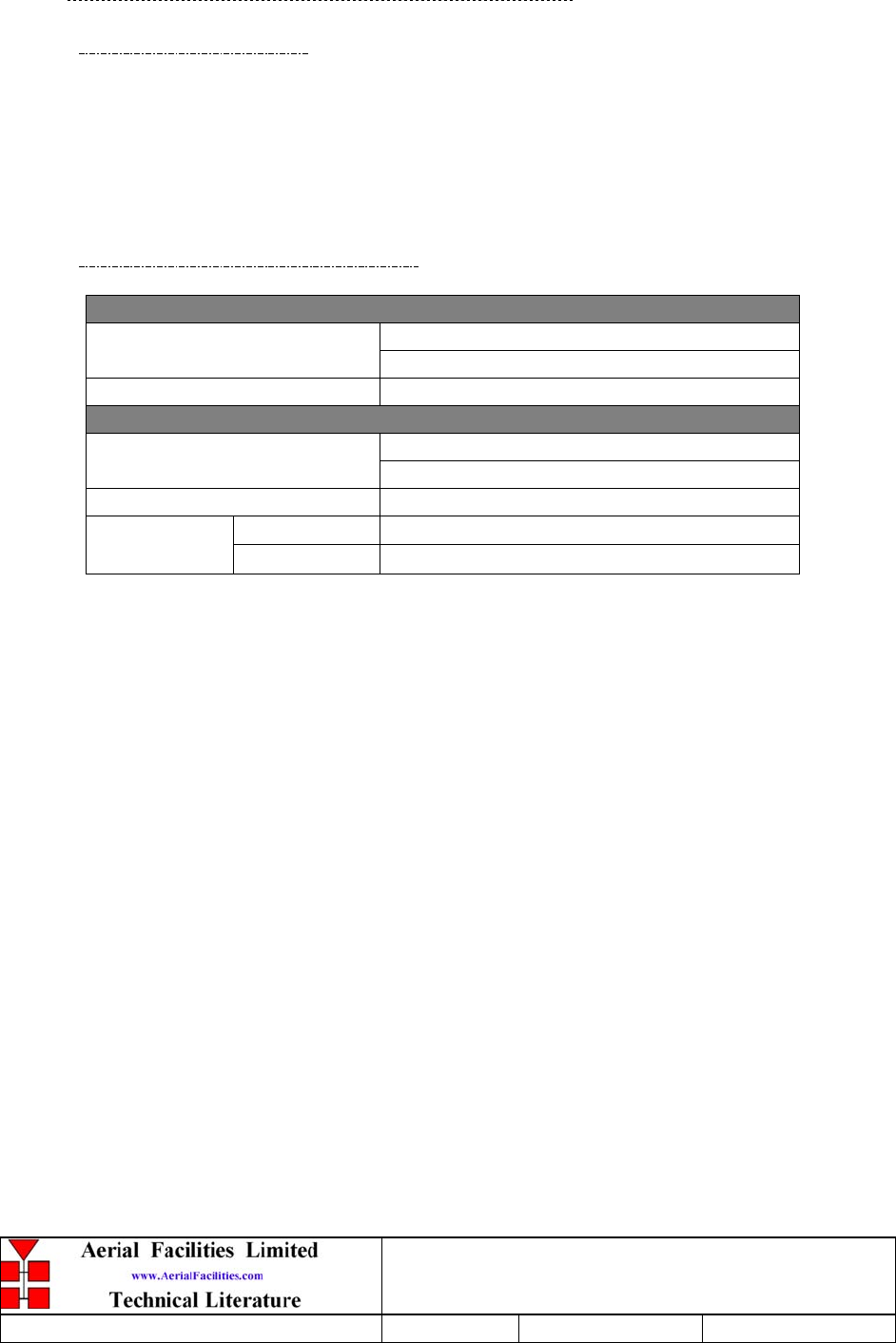
5-Way Channelised UHF Cell Enhancer
Maintenance Handbook
H/book Number:-50-060601HBKM Issue No:-1Date:-04/07/2003 Page:-47 of 54
5.3.2 48V/8A DC Power Supply Module (96-300056)
5.3.2.1 Description
This PSU module is similar in size and type to the 24V module, being a multi-mains-
voltage switch mode unit but having a 48V DC output. The unit is used to power the
remote amplifier unit via the DC Tap Module (see section 5.2.1). A small volt drop from
the 48V PSU to the remote cell enhancer is expected so that the DC voltage may be easily
converted to 24V to power the remote enhancers’s electronics.
5.3.2.2 Technical Specification
AC Input Supply
110 or 220V nominal
Voltages: 90 to 132 or 180 to 264V (absolute limits)
Frequency: 47 to 63Hz
DC Output Supply:
48V DC (nominal)
Voltage: 45-50V (absolute limits)
Maximum Output Current: 6A
operation: -10ΒC to +55ΒC
Temperature
range storage: -40ΒC to +70ΒC
All other modules in this shelf have been described elsewhere in this document.
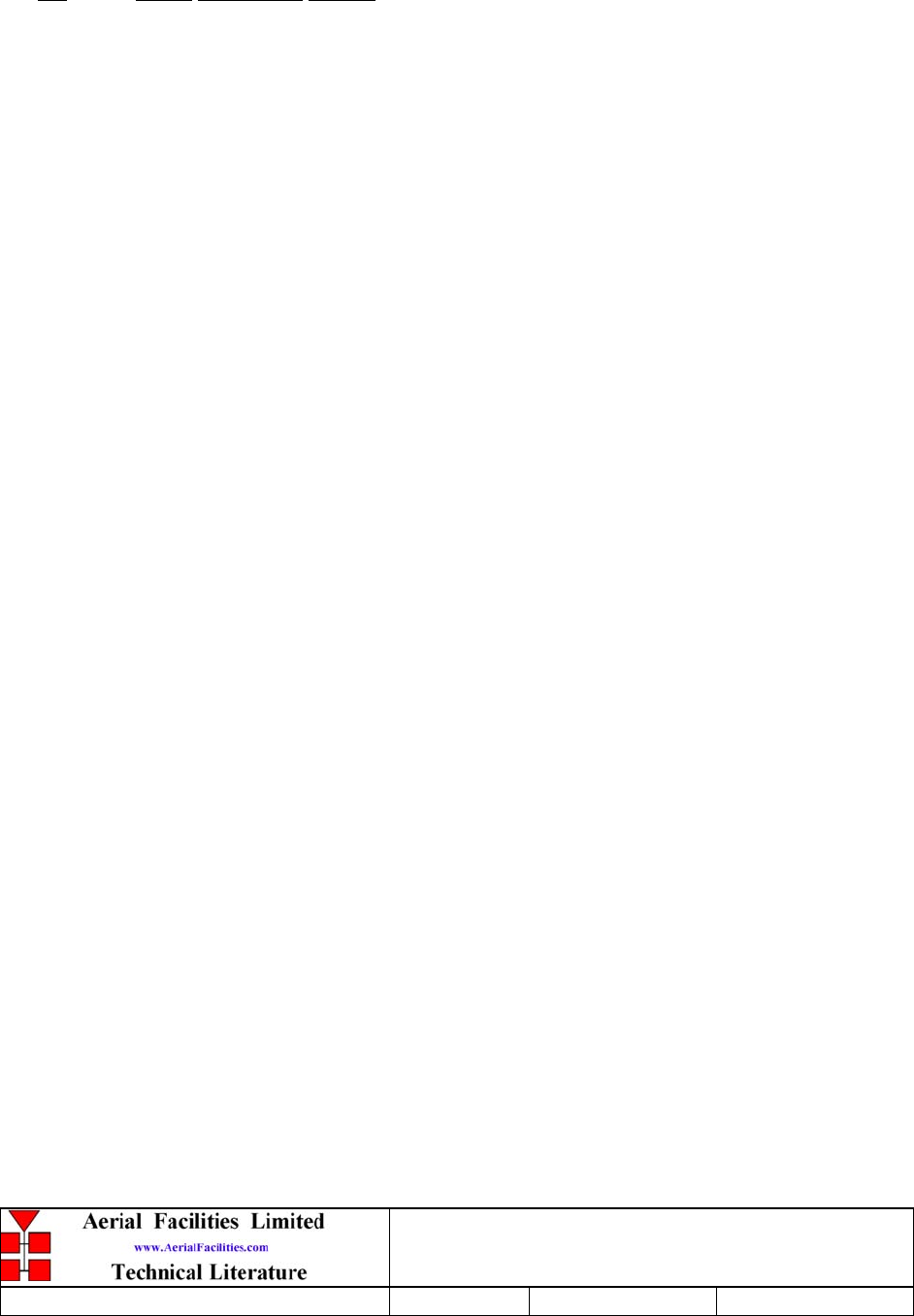
5-Way Channelised UHF Cell Enhancer
Maintenance Handbook
H/book Number:-50-060601HBKM Issue No:-1Date:-04/07/2003 Page:-48 of 54
6. INSTALLATION
6.1 Initial Installation Record
When this equipment is initially commissioned, please use the equipment set-up record sheet
in Appendix A. This will help both the installation personnel and AFL should these figures
be needed for future reference or diagnosis.
Installation will be a matter of securing each shelf into its appropriate place in the rack
cabinet, connecting all the cables (RF, DC and alarm ) to their correct ports/connectors and
system testing (at the customer’s discretion) to prove the original specification. Power
should not be applied until all connections have been double-checked and verified.
Refer to the system drawing(s) in section 4. for cabling details.
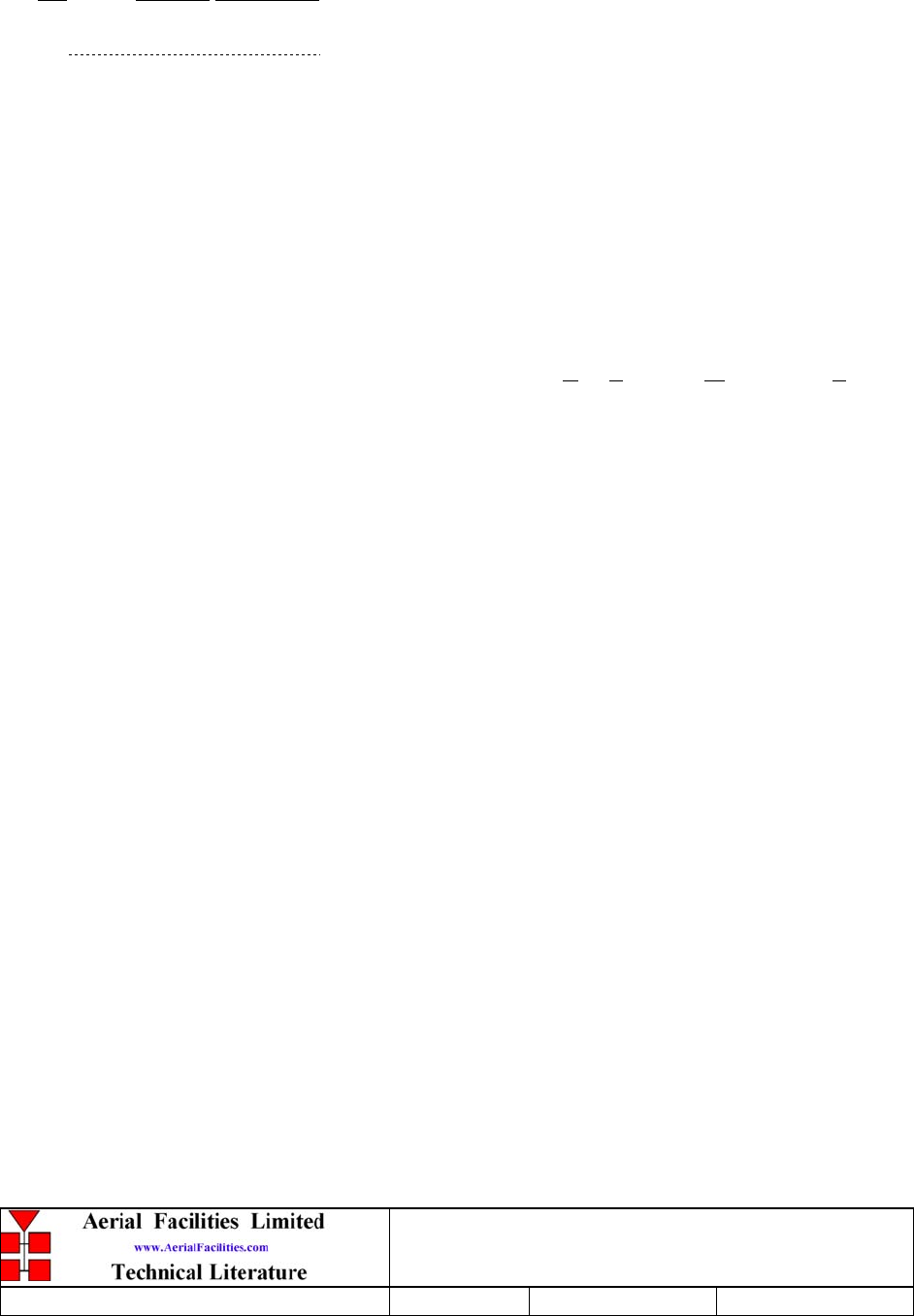
5-Way Channelised UHF Cell Enhancer
Maintenance Handbook
H/book Number:-50-060601HBKM Issue No:-1Date:-04/07/2003 Page:-49 of 54
7. MAINTENANCE
7.1 General Procedures
7.1.1 Basic Fault Finding
In the event that the performance of the system is suspect, a methodical and logical approach
to the problem will reveal the cause of the difficulty. The System consists of modules fitted
within shelves or trays and all housed within a standard 19” rack type cabinet.
Transmissions from the main base stations are passed though the system to the mobile radio
equipment; this could be a handheld radio or a transceiver in a vehicle. This path is referred
to as the downlink. The return signal path from the mobile radio equipment to the base
station is referred to as the uplink.
The first operation is to check the alarms of each of the active units and determine that the
power supplies to the equipment are connected and active.
This can be achieved remotely (via CEMS, the RS232 Cell Enhancer Management System,
if fitted), or locally with the front panel LED’s. The green LED on the front panel should be
illuminated, while the red alarm indicator should be off.
If an Alarm is on, then that individual shelf must be individually tested against the original
test specification.
The individual amplifier units within the shelf have a green LED showing through a hole in
their piggy-back alarm board, which is illuminated if the unit is working correctly.
If an amplifier is suspect, check the DC power supply to the unit. If no other fault is
apparent use a spectrum analyser to measure the incoming signal level at the input and then
after reconnecting the amplifier input, measure the output level. Consult with the system
diagram to determine the expected gain and compare result.
In the event that there are no alarms on and all units appear to be functioning it will be
necessary to test the system in a systematic manner to confirm correct operation.
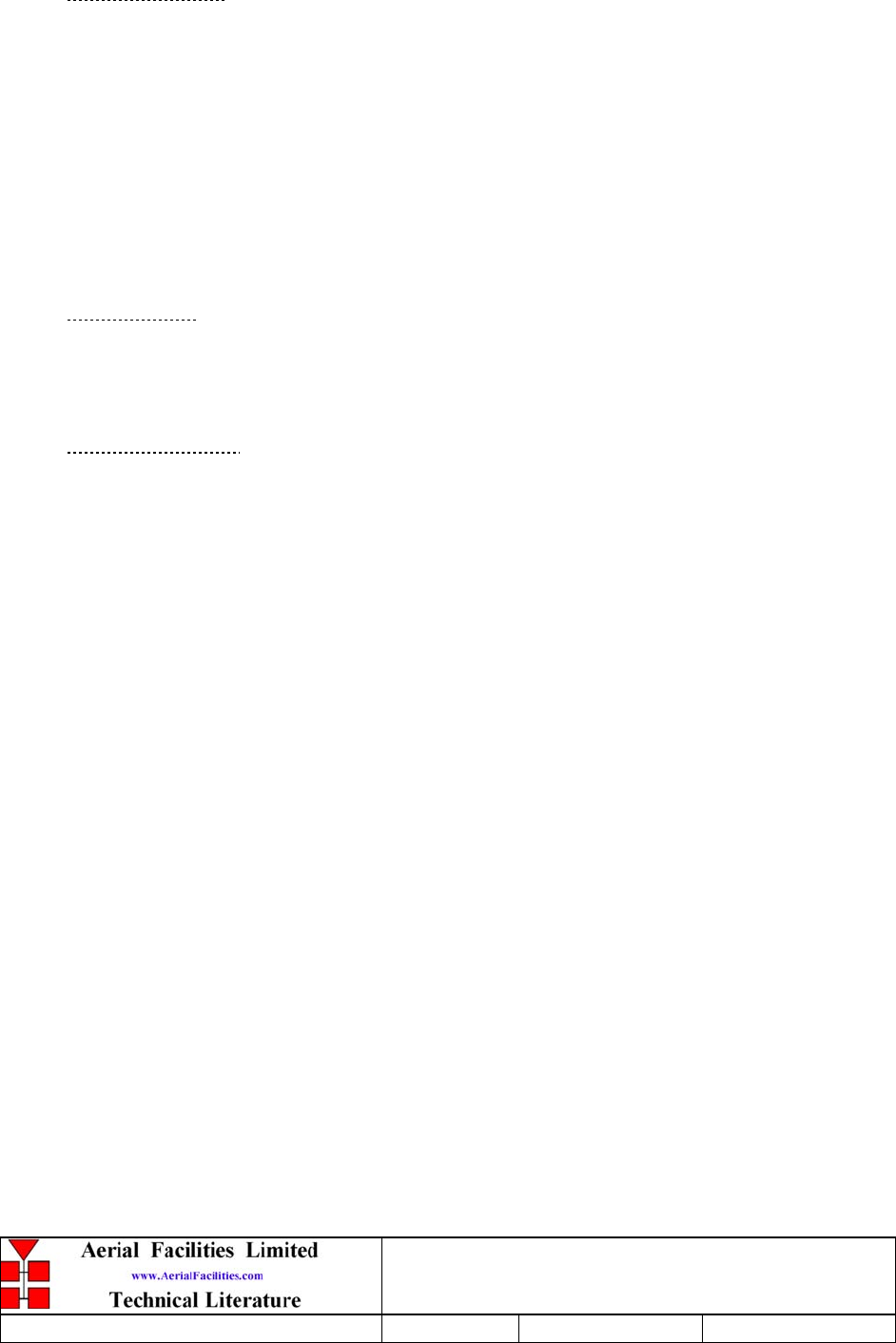
5-Way Channelised UHF Cell Enhancer
Maintenance Handbook
H/book Number:-50-060601HBKM Issue No:-1Date:-04/07/2003 Page:-50 of 54
7.1.2 Downlink
Confirm that there is a signal at the expected frequency and strength from the base station. If
this is not present then the fault may lay outside the system. To confirm this, inject a
downlink frequency signal from a known source at the master site BTS input and check for
output at the remote site feeder output.
If a signal is not received at the output it will be necessary to follow the downlink path
through the system to find a point at which the signal is lost. The expected downlink output
for the given input can be found in the end-to-end test specification.
7.1.3 Uplink
Testing the uplink involves a similar procedure to the downlink except that the frequencies
used are those transmitted by the mobile equipment.
7.1.4 Fault repair
Once a faulty component has been identified, a decision must be made on the appropriate
course to carry out a repair. A competent engineer can quickly remedy typical faults such as
faulty connections or cables. The exceptions to this are cable assemblies connecting
bandpass filter assemblies that are manufactured to critical lengths to maintain a 50-ohm
system. Care should be taken when replacing cables or connectors to ensure that items are of
the correct specification. The repair of component modules such as amplifiers and bandpass
filters will not usually be possible in the field, as they frequently require specialist
knowledge and test equipment to ensure correct operation. It is recommended that items of
this type are replaced with a spare unit and the faulty unit returned to AFL for repair. One
item that may need individual testing on site is the DC Tap system which supplies 48V DC
to the remote cell enhancer. When this unit is ‘on’ (but not necessarily with RF signals) a
DC voltage of over 40V should be available at the remote site at the input RF port. Be
careful not to ‘short out’ the enhancer output RF cable when DC is present – it will blow the
48V PSU fuse!
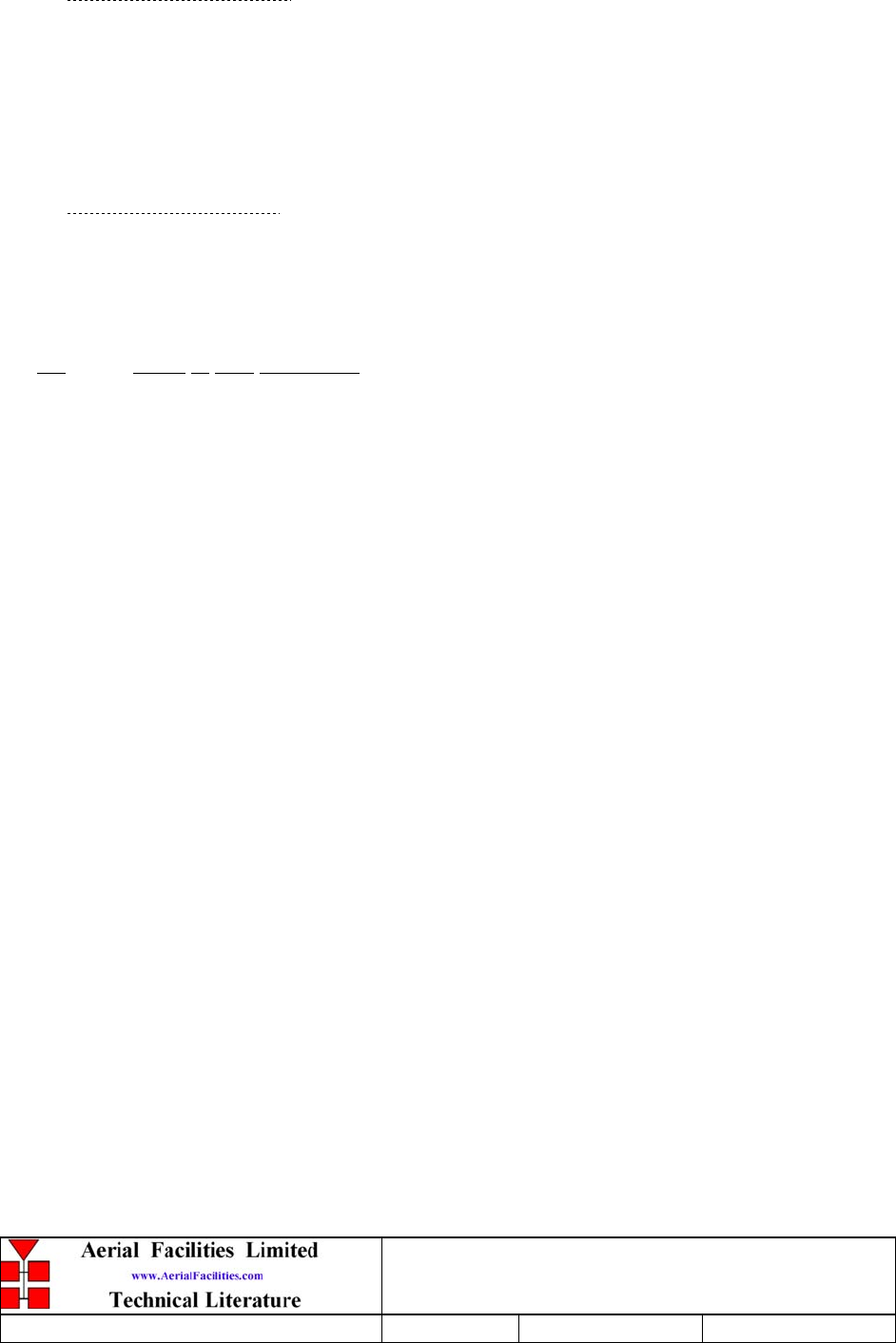
5-Way Channelised UHF Cell Enhancer
Maintenance Handbook
H/book Number:-50-060601HBKM Issue No:-1Date:-04/07/2003 Page:-51 of 54
7.1.5 Checking service
Following the repair of any part of the system it is recommended that a full end-to-end test is
carried out in accordance with the test specification and that the coverage is checked by
survey.
It is important to bear in mind that the system includes a radiating cable network and base
stations that may be faulty or may have been damaged.
7.1.6 Service Support
Advice and assistance with maintaining and servicing this system are available by contacting
Aerial Facilities Ltd.
7.2 Tools & Test Equipment
The minimum tools and test equipment needed to successfully service this AFL product are
as follows:-
Spectrum analyser: 100kHz to 2GHz (Dynamic range = 90dB).
Signal Generator: 30MHz to 2GHz (-120dBm to 0dBm o/p level).
Attenuator: 20dB, 10W, DC-2GHz, (N male – N female).
Test Antenna: Yagi or dipole for operating frequency.
Digital multi-meter: Universal Volt-Ohm-Amp meter.
Test cable x 2: N male – N male, 2M long RG214.
Test cable x 2: SMA male – N male, 1m long RG223.
Hand tools: Philips #1&2 tip screwdriver.
3mm flat bladed screwdriver.
SMA spanner and torque setter.
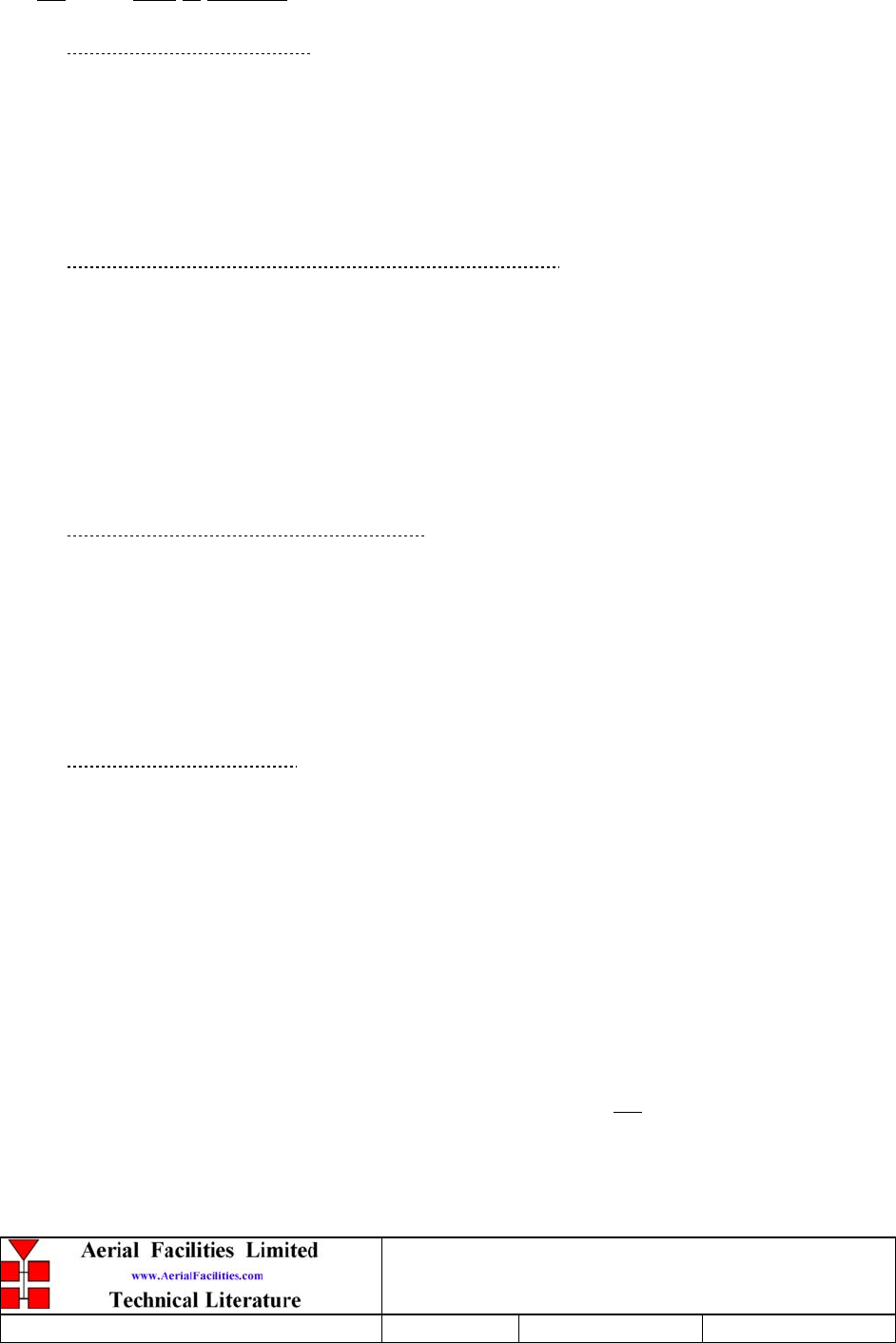
5-Way Channelised UHF Cell Enhancer
Maintenance Handbook
H/book Number:-50-060601HBKM Issue No:-1Date:-04/07/2003 Page:-52 of 54
7.3 Care of Modules
7.3.1 General Comments
Many of the active modules contain semiconductor devices utilising MOS technology, which
can be damaged by electrostatic discharge. Correct handling of such modules is mandatory to
ensure their long-term reliability.
To prevent damage to a module, it must be withdrawn/inserted with care. The module may
have connectors on its underside, which might not be visible to the service operative.
7.3.2 Module Removal (LNA’s, general procedure):
The following general rules should be followed to remove a module:
1 Remove power to the unit
2 Remove all visible connectors (RF, DC & alarm)
3 Release module retaining screws.
4 Slowly but firmly, pull the module straight out of its position. Take care not to twist/turn
the module during withdrawal. (When the module is loose, care may be needed, as there
may be concealed connections underneath).
7.3.3 Module Replacement (general):
1 Carefully align the module into its location then slowly push the module directly straight
into its position, taking care not to twist/turn it during insertion.
2 Reconnect all connectors, RF, alarm, power etc.,(concealed connectors may have to be
connected first).
3 Replace retaining screws (if any).
4 Double-check all connections before applying power.
7.3.4 Power Amplifiers
1) Remove power to the unit. (Switch off @ mains/battery, or remove DC in connector)
2) Remove alarm wires from alarm screw terminal block or disconnect multi-way alarm
connector.
3) Carefully disconnect the RF input and output coaxial connectors (usually SMA)
If alarm board removal is not required, go to step 5.
4) There is (usually) a plate attached to the alarm board which fixes it to the amplifier,
remove its retaining screws and the alarm board can be withdrawn from the amplifier in
its entirety. On certain types of amplifier the alarm board is not mounted on a dedicated
mounting plate; in this case it will have to firstly be removed by unscrewing it from the
mounting pillars, in most cases, the pillars will not have not have to be removed before
lifting the amplifier.
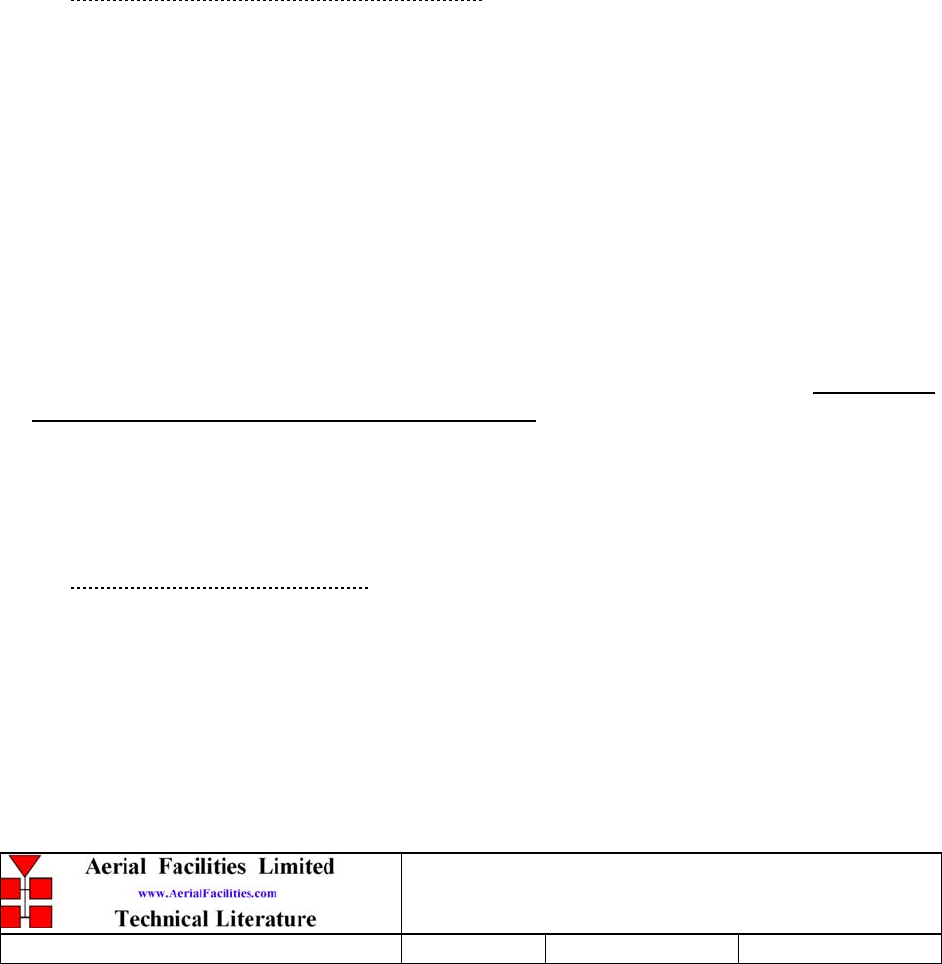
5-Way Channelised UHF Cell Enhancer
Maintenance Handbook
H/book Number:-50-060601HBKM Issue No:-1Date:-04/07/2003 Page:-53 of 54
5) If the amplifier to be removed has a heatsink attached, there may be several different
ways it can have been assembled. The most commonly used method, is screws through
the front of the heatsink to threaded screw holes (or nuts and bolts), into the amplifier
within the main case. If the heatsink is mounted on the rear of the main case (e.g., against
a wall in the case of wall mounted enclosures), then the fixing method for the heatsink
will be from within the case, (otherwise the enclosure would have to be removed from the
wall in order to remove the heatsink).
When the heatsink has been removed, the amplifier may be unscrewed from the main
casing by its four corner fixings and gently withdrawn.
Fitting a new power amplifier module will be the exact reverse of the above.
Note: Do not forget to apply fresh heatsink compound to the heatsink/main case
joint and also between the amplifier and the main case.
7.3.5 Low Power Amplifier Replacement
1 Disconnect the mains power supply and disconnect the 24V dc supply connector for the
LPA.
2 Disconnect the RF input and output cables from the LPA.
3 Disconnect the alarm connector.
4 Remove the alarm monitoring wires from (D type connector) pins 9 and 10.
5 Remove the LPA module by removing the four retaining screws, replace with a new
LPA module and secure it with the screws.
6 Connect the RF cables to the LPA input and output connectors. Reconnect the wires to
the alarm board connector pins 9 and 10.
7 Reconnect the DC supply connector and turn the mains switch on.
Note: Tighten SMA connectors using only a dedicated SMA torque spanner. If
SMA connectors are over-tightened, irreparable damage will occur. . Do not use
adjustable pliers to loosen/tighten SMA connectors.
Also take care not to drop or knock the module as this can damage (or misalign in the
case of tuned passive modules) sensitive internal components. Always store the modules
in an environmentally friendly location
7.3.6 Module Transportation:
To maintain the operation, performance and reliability of any module it must be stored and
transported correctly. Any module not installed in a whole system must be kept in an anti-
static bag or container. These bags or containers are normally identified by being pink or
black, and are often marked with an ESD label. Any module sent back to AFL for
investigation/repair must be so protected. Please contact AFL’s quality department before
returning a module.
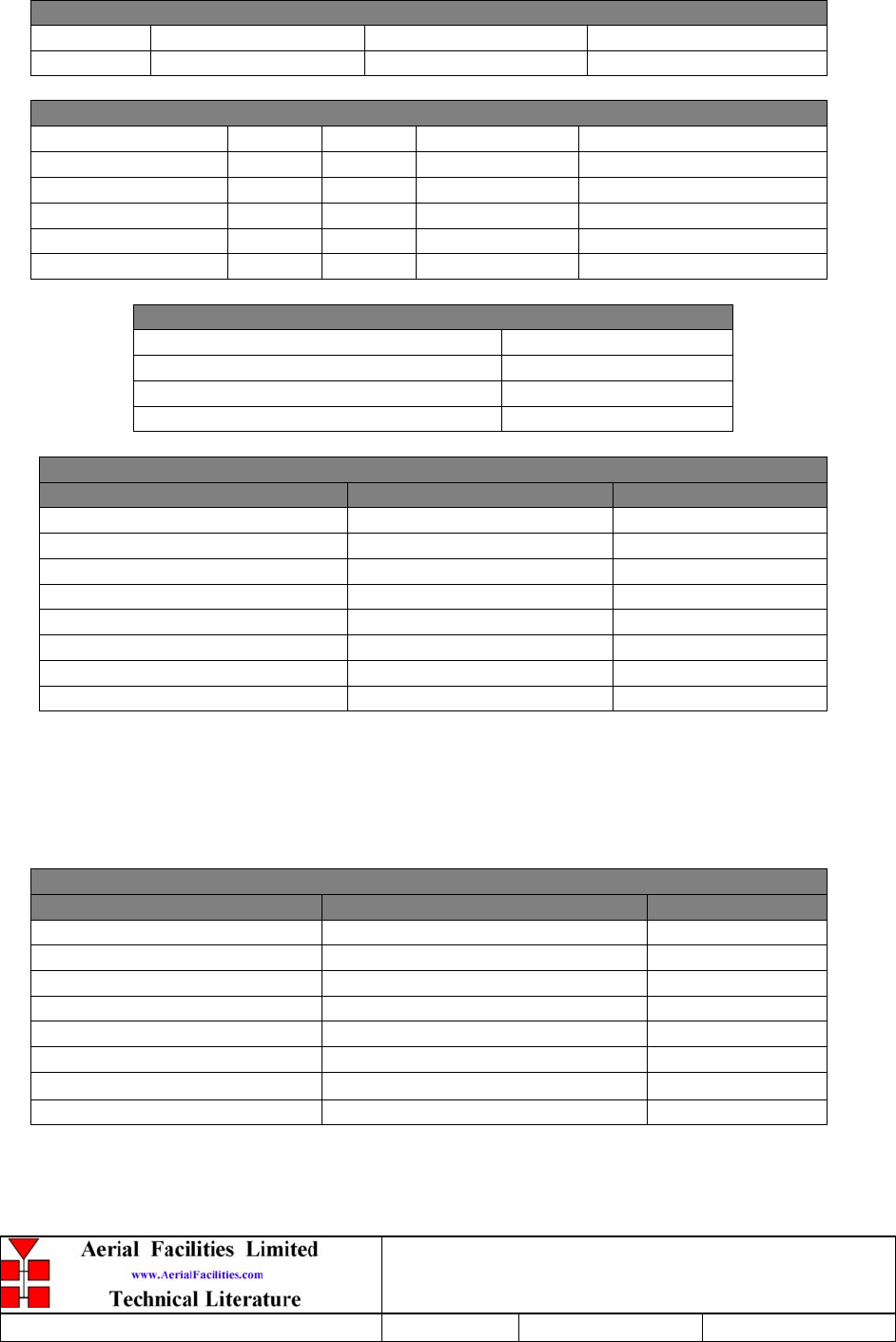
5-Way Channelised UHF Cell Enhancer
Maintenance Handbook
H/book Number:-50-060601HBKM Issue No:-1Date:-04/07/2003 Page:-54 of 54
APPENDIX A INITIAL EQUIPMENT SET-UP CALCULATIONS
GENERAL INFORMATION
Site Name: Client Name:
Date: AFL Equip. Model N.
ANTENNA SYSTEMS
Model Gain Azimuth Comments
A - Service Antenna
B – Donor Antenna
Type Loss Length Comments
C – Service Feeder
D – Donor Feeder
INITIAL PARAMETERS
E – CE Output Power dBm
F – Antenna Isolation dB
G – Input signal level from donor BTS dBm
Operating Voltage V
DOWNLINK CALCULATIONS
Parameter Comments Value
Input signal level (G)dBm
CE max. o/p power (E)dBm
Gain setting E - G dB
Isolation required (Gain + 10dB) dB
Service antenna gain (A)dB
Service antenna feeder loss (C)dB
Effective radiated power (ERP) E+A-C dBm
Attenuator setting CE gain-gain setting dB
If the input signal level in the uplink path is known and steady, use the following calculation
table to determine the gain setting. If the CE features Automatic Gain Control the attenuator
should be set to zero and if not, then the attenuation setting for both uplink and downlink
should be similar.
UPLINK CALCULATIONS
Parameter Comments Value
Input signal level dBm
CE max. o/p power (E)dBm
Gain setting dB
Required isolation dB
Donor antenna gain (B)dB
Donor antenna feeder loss (D)dB
Effective radiated power (ERP)E+B-D dBm
Attenuator setting (CE gain-gain setting) dB